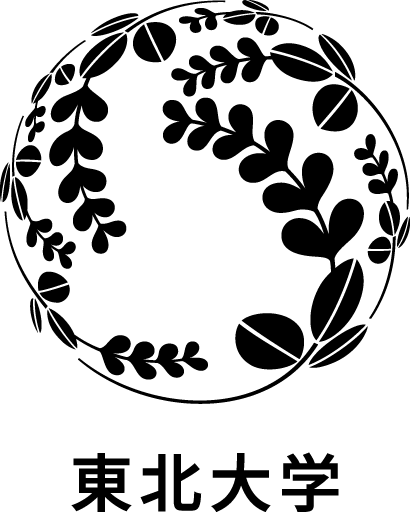GPPU ESSAYS
Essays by GPPU students and visitors
GPPU graduates
Essays by the GPPU graduates on their GPPU activities.
Seisho Abe (Department of Physics, Graduate School of Science, Tohoku University)
March 2023, GPPU Excellent Student Award and QE2 Special Award
2019年度から四年間に渡り、GP-PU には大変お世話になりました。
最初の一年間は修士課程二年生でした。修論のための研究と並行し、セミナーに参加して単位をとる必要があり、少々慌ただしくしていた記憶があります。
一方の博士課程の三年間では、修士課程の反省を活かして計画的に単位取得のためのセミナーや高度実験に参加しました。しかしながら、博士課程の開始と同時にコロナ禍となってしまいました。個人的に三ヶ月の海外研修をとても楽しみにしていたのですが、海外渡航することはかなわず、すべてオンラインでの研修となりました。面識がなかったにも関わらず、指導を快く引き受けてくださったKevin S. MacFarland 先生には大変感謝しております。研修で海外にいくことはかないませんでしたが、博士課程三年目(2022年度)はようやく状況が緩和されることとなりました。GP-PUの旅費サポートをいただき、最後の一年間で二回も海外での会議に行かせていただきました(写真はバークレーでのKamLAND Collaboration Meeting に行かせていただいた際のものです)。対面での英語での議論はやはり刺激的で、非常に実りのある時間を過ごすことができました。
海外研修の他に、高度実験も印象に残っています。普段触れることのない天文や原子核分野の実験を履修し、様々な測定や解析技術に触れることができました。実験でご指導いただいた先生方に、この場をお借りしてお礼申し上げます。また、最終的にいただいた実験成績が良かったようで、Excellent Student Award (Experiment) の賞をいただきました。最終試験(QE2)では、たった15分で素粒子・原子核・天文の先生方に研究内容と魅力を伝える必要があり、発表内容の工夫に苦しみました。皆様に内容をお伝えできたようで、QE2 Special Award をいただくことができました。二つの賞をいただき、大変光栄に存じます。
今後は東京大学宇宙線研究所にて、引き続きニュートリノ反応の精密測定とモデルの改良に従事していきます。これまではただのユーザーだったニュートリノ反応シミュレーションに関して、開発者として関わっていく予定です。世界各地で計画されている次世代ニュートリノ実験にニュートリノ反応モデルの観点から貢献していきたいです。
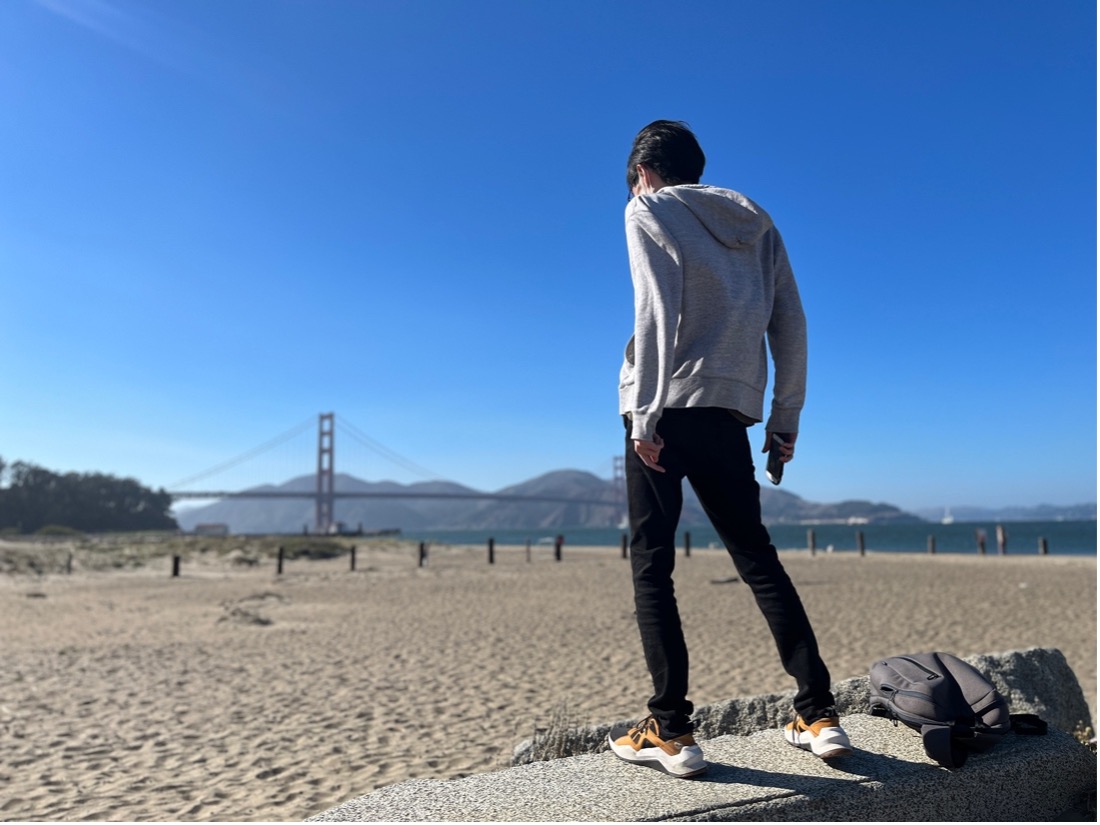

Yuki Hayashi (Department of Physics, Graduate School of Science, Tohoku University)
March 2023, QE2 Special Award
このエッセイでは4年間のGP-PU第3期生としての研究生活を振り返りたいと思います。
私の専門は素粒子理論で、QCD計算の高精度化に向けた研究を修士1年の頃から行ってきました。GP-PUに応募したのは金銭的なサポート及びさまざまな制度を利用して、より深く自分の研究を進展させられると思ったからです。
実際の研究生活を振り返って最も重要だったのは海外研修です。博士後期課程がちょうどコロナ禍と重なり、プログラム開始時に思い浮かべていたものとは異なる海外研修でしたが、幸運にもドイツでの研究生活を約1ヶ月半行うことができました。博士3年の6月からの滞在ということで新規の研究を進めることは叶いませんでしたが、摂動QCD計算の最先端の研究が行われているカールスルーエ大学において自身の博士論文研究の内容についてセミナーや議論を行い、非常に有意義な滞在となりました。受入研究者のMatthias Steinhauser教授にはこの場を借りて深く感謝申し上げます。また毎週末は鉄道を駆使してドイツの様々な土地を観光しました。(当時はドイツのエネルギー施策により9ユーロで1ヶ月間鉄道に乗り放題でした。)添付の写真は特に印象的だったハイデルベルグ城から城下を見下ろした風景です。コロナ禍においても研究だけでなく文化的にも豊かな生活を送ることができて、GP-PU生は大変恵まれているのだと感じます。GP-PU生の皆さんには海外渡航の機会を逃さずに、アクティブに研究活動を送ってもらいたいと思います。
その他の制度として、半年ごとに行われる進捗状況報告会は自らのプレゼン能力を磨く良い機会でした。時間とスライド枚数の制約の中、分野外の先生に自身の研究の面白さを英語でアピールするのは一朝一夕にはうまくいきませんでした。しかしこれを繰り返すうちに自分の研究内容をより論理的に説明できるようになり、プレゼン能力が成長して研究の面白さが伝わっていくのを実感できました。特に最終評価試験のQE2ではQE2 special awardを受賞することができました。素晴らしい評価をいただき大変光栄に存じます。
4月からは民間のIT企業に就職し、物理の業界からは離れることになります。これからはGP-PUで培った能力を遺憾なく発揮して、社会に貢献できるよう精進してまいります。最後になりますがお世話になった先生方、スタッフの皆様に深く感謝申し上げます。


Keita Sakai (Department of Physics, Graduate School of Science, Tohoku University)
March 2023
修士2年から博士3年まで四年間に渡りお世話になりました。修士2年の時には旅費サポートをいただき、トレント(イタリア)のECT*で行われた格子QCDのサマースクールに参加することができました。それまで学外で議論する機会があまりなかったので、同分野に携わる世界各国から集まった学生と交流できたことは良い刺激になりました。博士課程に進学直前からコロナ禍に突入し、海外渡航が困難な時期が続きましたが、オンラインサマースクールに参加して三週間アメリカの時間に合わせて昼夜逆転生活を送ったりしたことも今思うと貴重な経験だったと思います。最後の一年でようやく海外渡航が可能になり、スタヴァンゲル(ノルウェー)とボン(ドイツ)でそれぞれ国際会議に現地参加することができました。特にボンで行われた格子QCDの国際会議は前年度にもオンライン参加していましたが、格子QCDの専門家達に向けて研究発表を行って議論できたことはやはり現地参加ならではのものがあったと思います。さらに格子QCDにおけるハドロン質量の成分分解やグルーボール計算の第一人者であるKeh-Fei Liu教授の下で数値計算技術を習得するため、ローレンスバークレー国立研究所(アメリカ)に40日滞在しました。初の単独渡航で円安のピークだったこともあり生活面で大変なこともありましたが、Liu教授と個人的に議論できたことは博士論文執筆の面でも非常に有意義でした。このようにGP-PUの海外研修と通して様々な貴重な経験をすることができました。
卒業後は一般企業で機械学習関係の研究開発に携わる予定です。分野自体は大きく変わりますが、専門外の方に向けた発表や海外の方との議論など、GP-PUの四年間での経験を活かしていきたいと思っています。
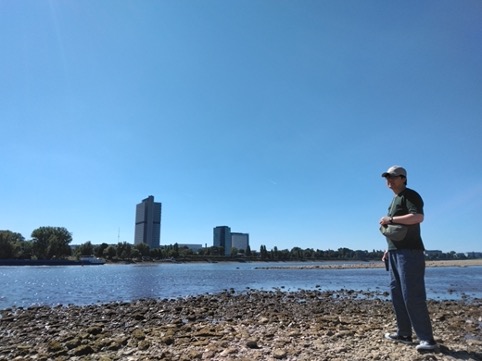

Nanami Kawada (Department of Physics, Graduate School of Science, Tohoku University)
September 2022
私は2019年の4月から2022年9月まで、GPPUで学ばせていただきました。この3年半を振り返ると、カムランドの波形読み出し回路を改造して増幅器を取り付けたり、アメリカの太陽観測衛星のデータを自分で解析してカムランドでのニュートリノ事象との相関を調べたり、先輩方が残してくれた秘伝のタレのようなデータ解析コードを改良して地球ニュートリノ解析をしてみたり、とにかく色々なことに挑戦してきました。GPPUのセミナーや高度実験で素粒子だけでなく原子核や天文学を含む広いテーマについて学んだことは、私が様々なテーマに興味を持ち取り組むきっかけの一つとなったと感じています。
博士課程在籍期間がコロナ禍と重なったことにより、海外研修は残念ながらオンラインになりました。しかしながら、指導教官のBerger氏とともに中心になって進めたカムランドへの信号増幅器導入作業が、カムランドグループ全体のプロジェクトとして今でも続いていることは誇りに思っています。
博士課程修了後も引き続きニュートリノ科学研究センターでカムランド実験を続けています。特に、地球ニュートリノ観測のさらなる精度向上に向けて新たな事象再構成手法の開発に取り組むほか、カムランド次期計画カムランド2の実現へ向け、プロトタイプ検出器での新技術実証、ストリーミングDAQシステムの新規開発に取り組んでいます。さらには、カリウム由来の地球ニュートリノ世界初検出へ向け、新実験の立ち上げを目指して取り組んでいます。

Yuichi Toyama (Department of Physics, Graduate School of Science, Tohoku University)
March 2022
私は2017年からGPPUの一期生としてお世話になり,コロナ禍前に様々な海外研修を行うことができました.
その中で私の専門である原子核物理のほかにも海外で素粒子物理学,宇宙物理学に関連する実験的研究に携わることができたことは,自分自身の科学者としての知見を広げ,将来の選択肢を広く持てるようになったという点で非常に重要だったと思います.
結果として,修了後の進路としてはミュオン物理に関する特任助教のポストを獲得することができました.国内のポストではありますが,分野を超えた選択肢を持てたというのはGPPU海外研修のおかげだと思っています.
それではこの場をお借りして実際に海外研修で感じたことなどを少し振り返ってみたいと思います.
私は主に米国のトーマスジェファーソン研究所(以下JLab),ドイツのマインツ大学の2か所にそれぞれ複数回,のべおよそ半年間滞在しました.
この2つの研究施設は大強度かつ高品質(エネルギーおよび位置精度が高い)の高エネルギー電子線加速器を所有しており,世界の原子核やハドロン,素粒子実験をリードする施設です.
私はそれぞれの施設で主にハイパー核の精密質量分光,またはそれに関連する実験に従事していました.具体的な研究内容については省略しますが,それぞれの施設で日本とは異なったスタイルで研究が進められており,新鮮な気持ちで日々を過ごすことができました.
GPPU採用前の修士一年で初めてマインツで実験に参加した時にはドイツの学生の優秀さに圧倒されて少し自信を失ったこともありましたが,経験を積んでいくにつれてだんだんと慣れていくことができ,GPPUプログラムを通じて対等に議論・実験ができるようになったと思います.またドイツでノンネイティヴである程度ゆっくりの英語というのも最初の経験としてはちょうどよかったなあと思います.そして英語に関して一番重要と私が考えるのはシニアな日本人のいない環境で作業(研究)をするということです.私の場合は研究室同士の共同研究ということもあり,日本人複数人で渡独して実験に参加することが多かったですが,現場にシニアな日本人スタッフや先輩学生がいるとどうしてもコミュニケーションの部分で無意識的に彼らに頼ってしまい,英語能力の向上が緩やかになってしまうと感じました.私は渡独は複数人であっても,日本人同士別の現場で作業する経験に恵まれてある程度しゃべれるようになれたと感じています.「聞く」という点ではなんとなくでも海外で生活していれば徐々に慣れていく気がしますが,「しゃべる,伝える」というところでは「英語でないと他の誰にも理解してもらえない」という危機感が能力向上を加速してくれると思います.
JLabではマインツに比べてもかなり規模の大きい国際共同研究施設ということもあり,あらゆるバックボーンの研究者が一緒に研究していてまさに人種のサラダボウル状態で,その中ではコミュニケーションの大切さ,特に交渉力の重要さを強く感じました.これはお国柄に加えて実験規模が大きいというところに理由があると思いますが,あらゆる部分が高度に専門化されているためそれぞれの専門家に助けてもらいながらでないとプロジェクトをなかなか前に進められないという環境でした.その中で一緒に行動することが多かった当時のGPPU助教(現京都大学助教)の後神利志氏がいろいろな人と毎日アポを取って様々な情報を収集,整理したり,仕事をお願いしたり(されたり)しながらプロジェクトを推進するさまを間近で見ることができ,貴重な体験だったと思います.研究者や技術者も人間ですから,事務的に正しく進めるだけでなく人と人との信頼関係を築きながら進めていく必要があり,その点で後神氏の能力は(天性かもしれませんが)すさまじいなと感心する日々でした.その境地にはたどり着けませんでしたが,後神氏を見習って(?)JLabの中庭で昼休みに行われているサッカーに参加してみたり,現地の学生に花火に連れて行ってもらったりと研究以外の場面でもいろいろな関係性を築くようにしていました.そういったある意味遊びながら築いたような関係が研究に活かされる場面もあり,アメリカ社会の一部を感じることができた気になっています.英語に関しては,JLabの研究者はネイティヴであっても英語が未熟な人との会話になれていて易しい言葉でしゃべってくれる人が多いのでそこまで苦労しませんでしたが,むしろ街中でのネイティヴとの会話のほうが当初は意思疎通に苦労しました.ただレストランなどはある程度パターン化された会話なので,少し慣れれば(研究者として滞在するうえでは)特に問題ないくらいにはすぐなれるのかなと思います.とはいえ初めてサブウェイで思い通りのカスタマイズができたときの喜びは研究とは別のベクトルで素晴らしいものでした.なにしろサブウェイの注文は日本語でも難しいのですから(私だけでしょうか?).
まとまりのない文章になってしまいましたが,GPPUにかかわるすべての皆様への感謝の言葉を述べて結びに代えさせていただきたいと思います.
本当に長い間ありがとうございました.またコロナ禍が収束し,活発な国際交流が再開してGPPU学生が海外研修を通して大きく成長できるような世の中になることを願っています.
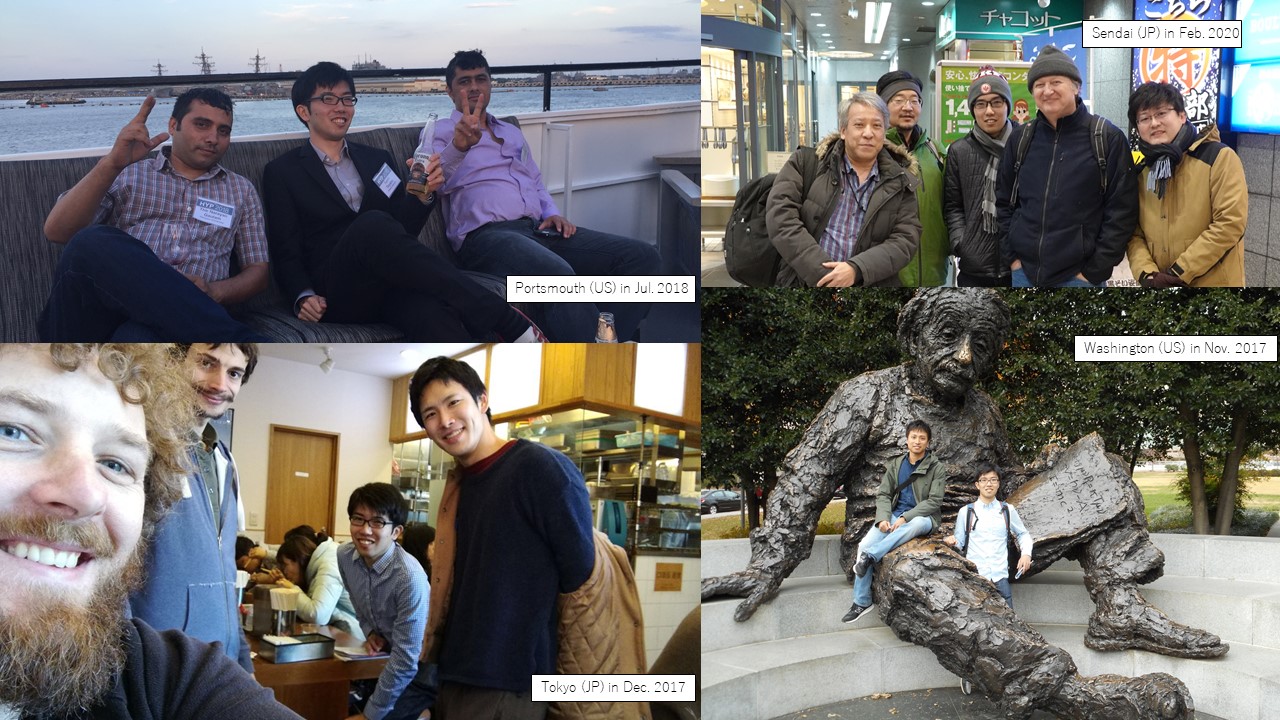

Yuto Kamei (Department of Physics, Graduate School of Science, Tohoku University)
March 2022
私は修士2年の2018年4月から4年間、GPPU生として研究に取り組みました。まずは研究活動を支えてくださった多くの方々に感謝の意を示したいと思います。私が参加したKamLAND-Zen 800実験は745 kgものキセノンガスを30 m3の液体シンチレータに溶かし込んで136Xeが起こす未発見の希少崩壊事象を探索するものです。参加した当初は実験開始に向けた装置作成段階でした。2019年1月に観測準備が整い、2022年現在も観測を続けています。私の博士論文では約2年間の観測データを解析し、まとめました。ハードウェアからソフトウェアまで触れることができたことはとても貴重な経験です。世界各地で行われている同種の観測実験の中で、KamLAND-Zen実験でデータ解析を行い、世界最高感度を誇る成果を出せたことを誇りに思います。また、実験開始前のハードウェア作業は背景事象を極力減らすためにスーパークリーンルーム内で行われましたが、二重に着込んだクリーンスーツにゴーグル、マスクで閉塞感が大きく、辛かったのもいい思い出です。マスクと言えば、Covid-19の蔓延により日常でも身につけなければならなくなるとは思いもしませんでした。こちらの閉塞感は耐え難いもので、海外研修にも大きく影響しました。D2でオランダに渡航を計画していましたが、キャンセルとなり、D1のうちに行っておけば良かったと後悔しています。何事も後回しはよろしくないですね。Covid-19に関しては早く以前の生活、活動が戻ることを願います。今後は一研究者として自身の興味を追求し、それが科学の発展に寄与するよう努力していきたいです。

Atsuto Takeuchi (Department of Physics, Graduate School of Science, Tohoku University)
March 2022, Excellent Student Award
GPPU生としての4年間で様々な経験をさせて頂きました。特に、自分の研究分野と全く関係のない天文学に関するセミナーや実験授業を受けることができたのは良い経験でした。振り返ってみると、GPPU生としての課程は機会と義務からなっていたように思います。“日本ではできない研究を海外で進める機会/3ヶ月以上の海外研修を受ける義務”といった具合にGPPUで与えられる機会と義務とは表裏一体です。例えば、宇宙創成物理学特別講義(GPPUセミナー)では1–2時間英語のセミナーを聞き、質問や議論を行う必要があります。正直大変です。分野外の研究について英語で聞いてもよくわかりません。面倒になると、セミナー自体は軽く聞き流して、義務を果たすために「軸の単位はなんだ」とか「この文字が表しているものはなんだ」とかあまり意味のない質問(?)をして終わらせることもできます。それはそれで処世術なのかもしれませんが、セミナーに参加した2時間は無駄になります。一方で、わからないながらも真剣に耳を傾け要点を抑えるだけでも新しい知見が得られます。必然的に気になる点や確認したい点も出てくるので、言われるまでもなく質問・議論することになります。前置きが長くなりましたが、GPPUで得られる成長は、自分の意識に依るものが大きいと思います。本文を読んで下さった皆様が有意義に制度を活用し、宇宙創成の理解を進めてくださることを願っています。末尾になりますが、GPPUプログラムを運営してくださった教員・コーディネーター・秘書の皆様に感謝を述べたいと思います。ありがとうございました。

Shinnosuke Nakai (Department of Physics, Graduate School of Science, Tohoku University)
March 2021
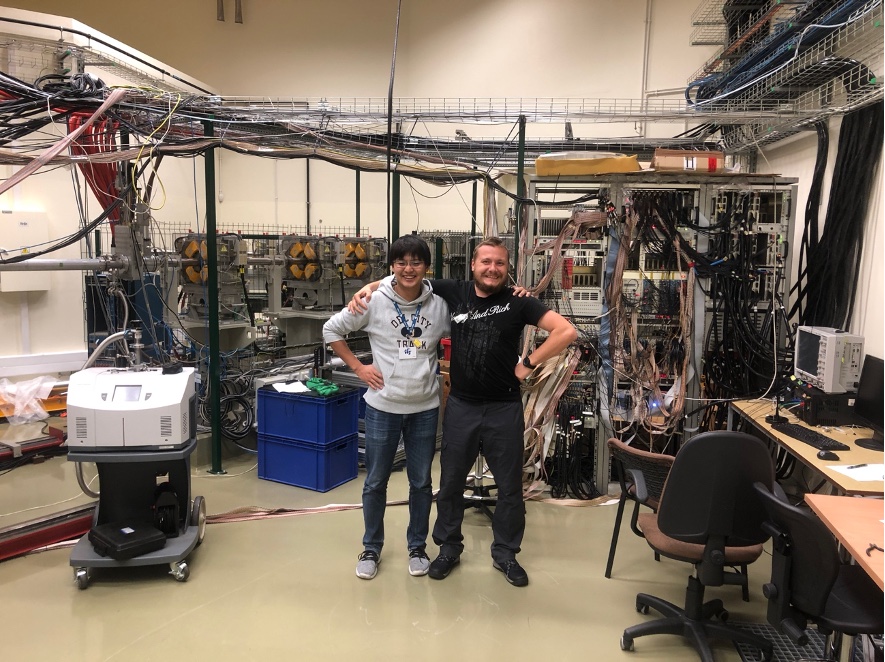
I had really great experiences through the GPPU program. I was able to visit many laboratories and universities for my research or conferences. I could have experience state-of-the-art research activities and had discussions with various people. It was very inspiring and the experience enabled me to grow a lot. Conducting research at overseas institute is a very valuable experience and will be a important asset in your future life. I think that interacting with various people, especially foreigners through research activities is a major feature of the GPPU program. You will be able to acquire the communication skills which is necessary for your future research life. My research life has become very meaningful thanks to GPPU. I would like to thank all staffs, researchers and the people involved with me here.

Koji Yamaguchi (Department of Physics, Graduate School of Science, Tohoku University)
March 2021
このエッセイではGPPUプログラムにおける海外研修と、そこで得た経験について簡単に振り返りたいと思います。GPPUプログラムに参加すると、修士課程の間に1か月間、博士課程の間に3か月間の合計4か月間の海外で研究活動を行うことになります。修士課程での海外研修として私はカナダのUniversity of WaterlooのAchim Kempf氏の研究室に1か月間滞在しました。海外に長期間滞在するのは初めての経験であったので出発前は多少不安もありましたが、教授だけではなく現地の大学院生とも議論ができ、楽しく有意義な時間を過ごすことができました。博士課程では、オーストリア・台湾・カナダ・オーストラリアといった複数の国で海外研修を行いました。それぞれの詳細はここでは述べませんが、海外研修での多数の研究者との議論を通して様々な研究のアイデアを得ることができました。特に、ある国際会議で新しい研究のアイデアを着想し、それをもとにAchim氏らと共同研究を行って国際共同論文を書くことができました。
これらのGPPUの海外研修における経験から、英語での議論も物怖じせずにできるようになったと感じます。またGPPUでの海外研修をきっかけとして、博士課程修了後のポスドクポストをカナダで得ることができました。GPPUプログラムが私の研究者としてのキャリアの第一歩において非常に大きな影響を与えてくださったと思います。
末尾になりますが、GPPUプログラムを修了するに際して、プログラムを運営してくださった教員・コーディネーター・秘書の皆様に感謝いたします。

Ryoki Matsukoba (Institute of Astronomy, Graduate School of Science, Tohoku University)
March 2021
私は修士2年から博士3年までの合計4年間、プログラム生としてお世話になりました。GPPUでは、分野の第一線で活躍する研究者による講義や海外研修の経済的支援などが行われており、それらを通して貴重な経験を積めた4年間でした。私は天文学を専門にしていますが、GPPUの講義で原子核や素粒子といった他分野の話を聞くことは、自分の専門外の研究に関しても興味を持ち、広く知識を身につけようと心がける契機になりました。近年はこれまで細分化されてきた各分野の境界領域に関する研究、いわゆる学際研究が新たな知見の発見につながると重要視されてきています。GPPUの講義で得た専門外の知識、またはそれを知ろうとする姿勢を、将来的に学際研究に携わるときに活かしていきたいと思っています。次に海外研修も、私が今後研究活動を続けていくうえで価値のある機会を与えてくれました。私は海外研修で、ウィーン大学に所属する共同研究者のもとを訪れ、計算コードの開発および結果に対する議論を行いました。その滞在中に同大学に所属する学生と議論をしたり、食事をともにする機会がありました。自分と同世代の海外の学生の意見や生活について知ることで、国際的な感覚を身につけることができたと考えています。最後に、海外研修がきっかけで始まった国際共同研究は、私が博士論文を書く上で欠かせない研究でした。このようなチャンスを与えてくださったGPPUの方々には、大変感謝しております。上記以外にもGPPUを通して得た経験は数多くあり、それらの経験を糧として今後も良い研究ができるように頑張りたいです。

Taiki Ogihara (Institute of Astronomy, Graduate School of Science, Tohoku University)
March 2021
タイトル: 価値
私は活動銀河核ジェットのダイナミクスについての理論モデルを構築する研究を行ってきた。活動銀河核ジェットとは、銀河の中心部で明るく光るコア(活動銀河核)から伸びる光速に近い速さ(相対論的速度)を持つ細く絞られたプラズマ流(ジェット)である。ジェットは銀河中心にある超巨大ブラックホールの近傍数シュバルツシルト半径で駆動され、大きなものでは数メガパーセクまで約10桁ものスケールを伝播する。高解像電波観測計画 Event Horizon Telescope (EHT) によってM87 銀河においてブラックホールの事象の地平面付近が撮像観測され、ブラックホール近傍領域の数値シミュレーションも多くなされるようになってきており、ジェットの形成メカニズムにも注目が集められてきている。
私はこれまで様々な研究者との交流を通して、自分の研究の意義を再確認したり研究コミュニティに対する貢献感を得てきた。その始まりは修士二年(2017年)に国立天文台水沢観測所で開かれたEHTに関する研究ミーティングに参加したことだった。小さな部屋にぎゅうぎゅうになりながら10人弱が一つのプロジェクターを囲むなか、私は自身の研究について発表した。自分の研究を面白く思って、自分自身の今後にも期待してもらえる人がいるという実感を初めて味わった。その後もGPPUのサポートをいただいた海外での滞在も含め多くの研究会に参加し、自分の研究に魅力を感じてもらえるように意識したプレゼンをしてきた。その甲斐あってか多くの研究者とつながることができ、議論を通して研究が進んだり、新たな共同研究に発展したりもした。海外の研究者とも対等に議論ができたことは大きな自信になった。
GPPUのサポートのおかげで国内外問わず活動できたことは、海外で活躍する多くの研究者と直接交流して自分や自分の研究の価値や立ち位置について考える上で貴重な経験となった。今後の研究活動でも国内外問わないコミュニケーションの中から問題を発見、解決してコミュニティに貢献していくことを意識していきたい。

Yo Sato (Department of Physics, Graduate School of Science, Tohoku University)
March 2021, Excellent Student Award
GPPUには研究分野の異なる学生が在籍しており、講義や進捗報告を通して自分以外の研究に目を向けることが出来るのが特色の一つだと思います。GPPUでは、Qualifying
Examinationや学期毎の進捗報告会で、自分の研究の面白さ・重要さを分野の異なる人に発表する機会があります。研究室内での発表とは違って、専門的な用語を避けたりわかりやすい説明をしたりはもちろんのこと、宇宙創成という観点から自分の研究がどういう立場にあるのかを考える必要がありました。普段の発表とは毛色が違うので準備は大変ですが、その分自分の研究を俯瞰的に捉える良いトレーニングになったと感じています。
GPPUでは海外研修の支援や経済的サポートをいただき、集中できる環境で研究に打ち込むことが出来ました。その中で培った研究力と俯瞰的視野は必ず役立つと考えています。GPPU修了生としての自覚と責任を持って、この先の研究者生活に臨んでいきます。

Masaaki Tokieda (Department of Physics, Graduate School of Science, Tohoku University)
March 2021, Excellent Student Award
GP-PUメンバーとして採用されて一番大きかったのは、自身の意識の変化でした。それまで海外渡航などにあまり興味は無かったですが、必要に迫られて色々と調べ、また外国人の友達ができていく中で、国際交流をもっとしてみたい、海外に行って研究したい、また海外で自分の力を試してみたいと思う様になりました。結果博士号取得後のポジションは海外を優先して探す様になり、フランスでのポスドクを獲得する事が出来ました。GP-PU加入当時の自分からすると、考えられない事です。ポスドクでは大きな環境の変化はもちろんのこと、分野が多少変わることもあり非常に挑戦的ですが、GP-PU参加以前と現在ほどの成長と共に日本に戻ってきたいと意気込んでいます。
GP-PUの期間中には、イタリア、ハワイ、フランスへの渡航を経験する事が出来ました。新たな経験ができた、楽しかったなどは当たり前なので、ここでは渡航中の個人的な反省を列挙します。一つ目は、準備をきちんとするという事です。研究に関しては当然ですが、英語についても同様です。海外に行けば自動的に英語が喋れるわけではありません。それは認識していたつもりで、多少練習もしていきましたが、全く自分を表現できなかった事に悔しい思いをしました。自分の場合それをM2で経験できた事は幸いでした。帰国後は危機感からより本腰を入れて練習する様になり、その後の渡航では多少改善が見られました。当然ですが、コミュニケーションが取れた方が楽しいし、またもっと喋ってみたいという気持ちにもなります。人によっては、そういう気持ちが持てないと現地での上達は見込めない気がします。二つ目は、できるだけ日本人と連れ添わないという事です。海外でも日本人と一緒にいると楽だし安心もできます。その日本人がその国の事をよく知っている人だとなおさらです。ただ、その人と一緒に回っていても自身の成長は一切見込めません。研究者になるにしても、企業に勤めるにしても、また単に帰国後の会話の種としても海外渡航は貴重な経験です。何事も自分でやらないと身につかないので、よく知っている人が周りにいれば教えを仰ぎつつ、基本的には自分の足で歩くという事が自身にとってプラスになると思います。三つ目に、GP-PUの制度は積極的に活用し、また早めに行動した方が良いという事です。自分はD3時に二つの国での長期滞在を予定していましたが、結局中止となってしまいました。中止となる事が予想外だったのに加え、その時は自分が博士修了後海外に住む様になるという事も予想していませんでした。今となっては住む前に渡航というより簡単な形で海外をもっと経験しておきたかったという気持ちがあります。現状思い立ったら即行動というわけにもいきませんが、この状況だからこそ築ける人脈というのもあります。文字通り今後何が起きるかはわからないので、常にできる限りの備えをしておくしかないんだろうと思います。
自身の人生にとってGP-PUに加入した事は大きな意味があったと感じています。大きく視野が広がった事に加え、多くの新たな経験もできました。その様な機会を与えてくれた事に深く感謝しています。

GPPU students
Essays by the GPPU students on their stays abroad for international collaborations supported by GPPU.
Nanae Domoto (D2, Astronomical Institute, Graduate School of Science, Tohoku University)
July 3rd-23rd, 2023, Germany
ドイツはポツダムにあるマックスプランク重力物理学研究所に3週間滞在しました。これまでの海外出張は研究会への参加が主だったため、やや長い期間1つの研究所に滞在するのは今回が初めてでしたが、3週間という期間でドイツでの生活に触れられたのも印象的でした。例えば、ペットボトルの料金には”デポジット”が含まれていて、リサイクルに出すことでそれが返金されることを知りました。スーパーで何度か買い物もして、スキャンされた品物をその場で素早くバッグに詰める必要があるのはあまり慣れませんでしたが、次回は迷うことなく行けるでしょう。このようなことは滞在してみないとわからないことだったと思いますし、貴重な経験になりました。最後に、今回の滞在をサポートしてくださった方々に感謝いたします。
I stayed Max-Planck Institute for Gravitational physics (Albert Einstein Institute) in Germany for three weeks. One of the groups in this Institute has many researchers working on neutron star mergers, which is my research topic. This time, I visited my collaborators to start something new project. I have worked on the electromagnetic counterpart of neutron star merger (kilonova), in particular focused on spectra. Finally, as a result of many discussions, I came back with about two directions as extensions of my previous research, which will be new themes. I also gave a seminar about my published work in the second week. I was happy to get several questions.
The group that I visited has not only Japanese but also many Chinese and European people. During the stay, I had lunch and coffeetime together with them every day. I could discuss (chat) many things about culture/research/living overseas. Those conversations were in fact very valuable.
Since I had twice weekend, I would go to sightseeing for Potsdam and Berlin. Everyone told me that a famous museum in Berlin, Pergamon museum, plans to be closed for about 15 years from this October due to some construction. So, I went there and saw great exhibits. However, some areas were already closed and could not be seen. I hope that I can go there again after the construction is end.



Ryutaro Tsuji (D3, Department of Physics, Graduate School of Science, Tohoku University)
April 22nd-June 5th, 2023, USA
I visited Brookhaven National Laboratory (BNL) at New York from 22nd on April to 5th on June. BNL is located at long island in NY state, which advances fundamental research in nuclear and particle physics. One of the main purposes of my visitation is giving a seminar about our research and having a discussion with them. Especially while I stayed at BNL, I could have many opportunities to have discussions. These discussions with them gave me lots of information including new data analyses methodology which can be a clue to blush up our research. Furthermore, during my visitation to the US, I could visit Stony Brook University to attend a seminar and have a discussion. In addition, I also stayed at Los Alamos National Laboratory (LANL) at New Mexico for a week. LANL is in NM state, where is so far to require me 6 hours’ flight and 2 hours’ driving from BNL. Prof. Rajan Gupta, who is very famous researcher in our lattice QCD community, invited me to have a seminar at LANL, and taught me their data analyses that should be implemented in our study in detail.
Since it was the first time for me to visit the US, everything was fresh and stimulating. Let me describe three experiences expecting for the research topic. First, I went to Manhattan Island several times. Especially the musical CHICAGO that I watched at a Broadway theater, Ambassador Theatre, was wonderful. Second, I needed cook for myself. I asked my colleagues driving me to a grocery store, and I tried to cook the US style food such as mac & cheese, bagel, and sandwiches. Since this is a unique experience that is not be assumed in the ordinal trip, I could enjoy my survival. Finally, the most wonderful experience is a drive in the US. I used rental cars to visit beauty spots in NY and NM. The memories going around such beautiful spots are my treasures.
During the visitation, I could have a brilliant time in those seminars, discussions, and conversations. I am sure that my experiences are very valuable in my life and encourage me to work harder. I am sincerely grateful everything especially to Nobu, Taku, Raza, Jun-Sik and Rajan who helped me a lot, and GPPU's support.
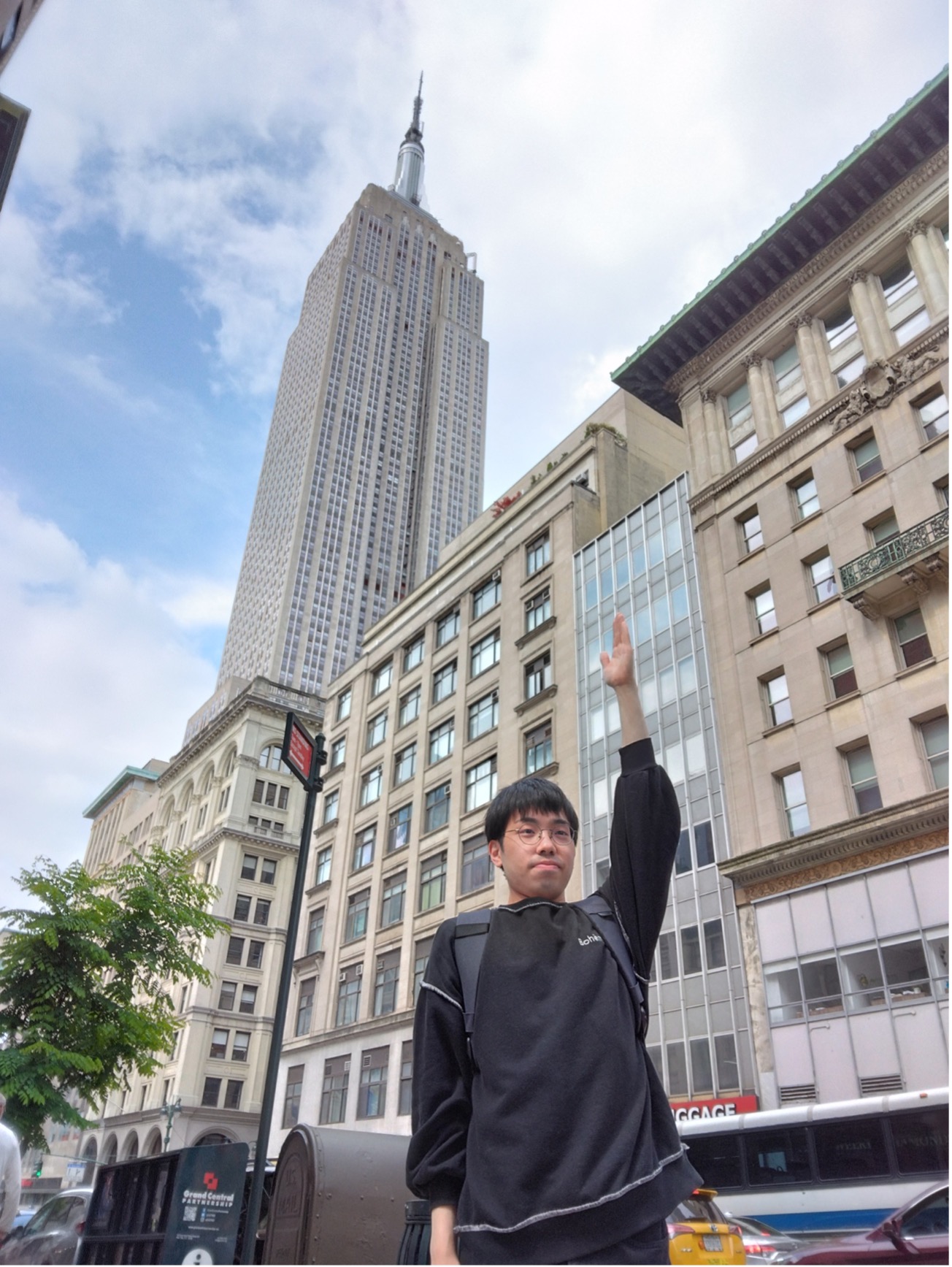

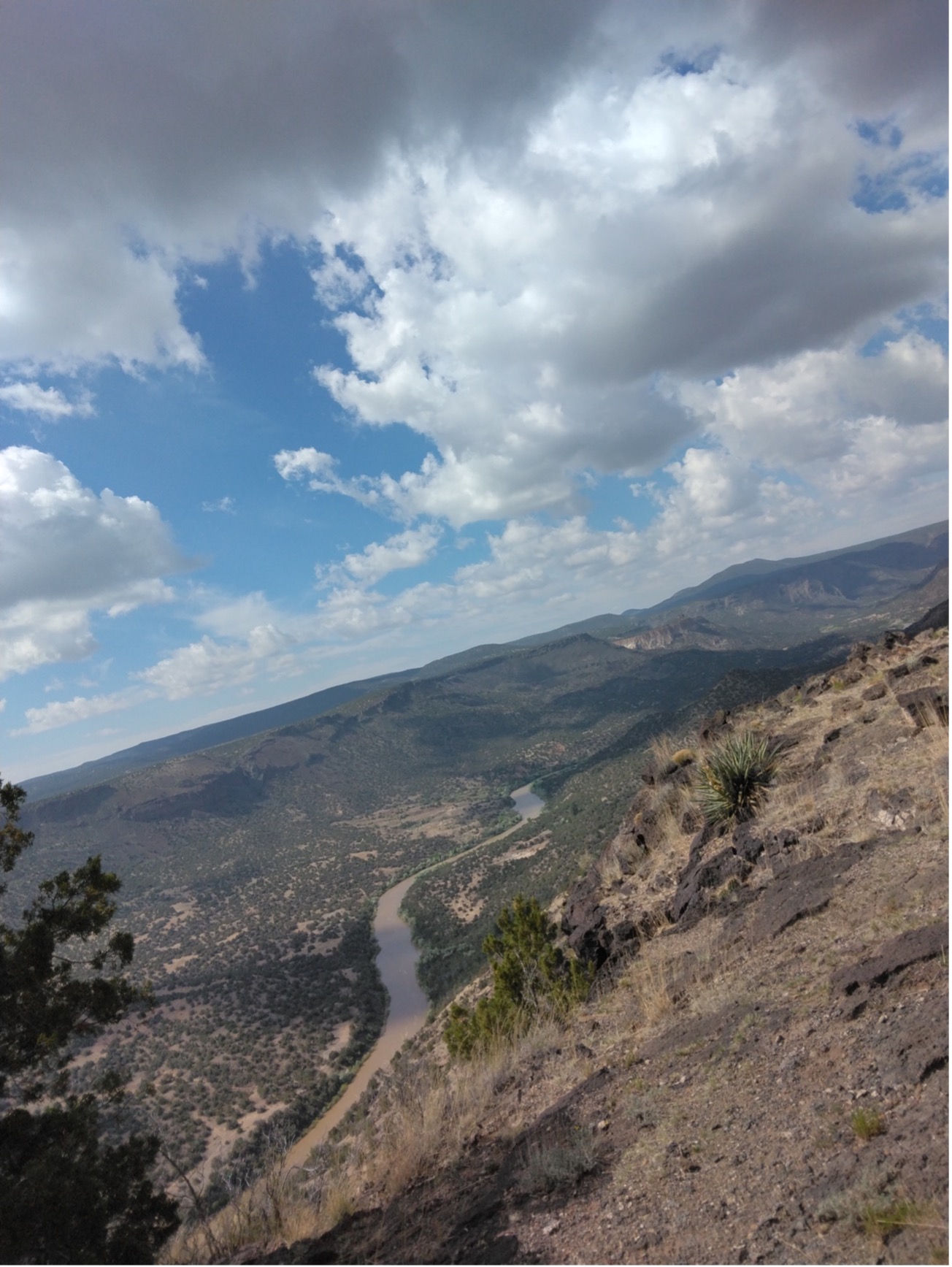

Minori Eizuka (D1, Department of Physics, Graduate School of Science, Tohoku University)
- , 2023
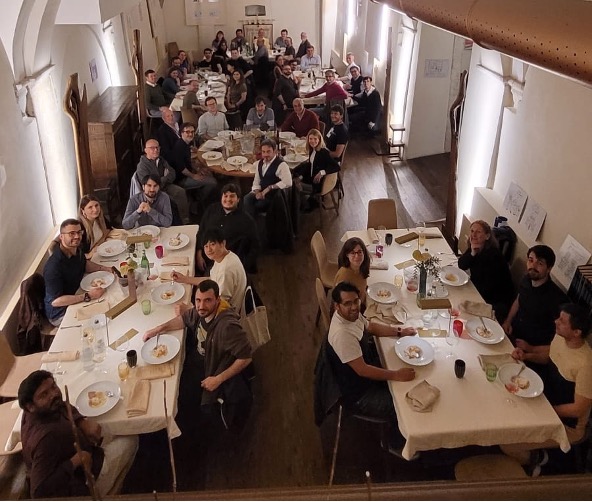
5月29 日から6月1日までイタリアのグランサッソ国立研究所で行われた国際学会International conference on Supernova Neutrino Detection(SNvD2023)に招待され、講演を行いました。講演内容は自身の所属研究室が所有するニュートリノ検出器KamLANDを用いた超新星ニュートリノ観測の現状についてです。この内容は自身が修士研究として行なっていた研究に加えて、博士研究のテーマにする予定の研究や他の大学と共同で行なっている研究も含んでおり、それらを包括的にまとめて英語で話すのはなかなか大変でした。しかし、4日間世界最先端の研究結果に触れたり、将来研究の可能性について議論したりと大変有意義な時間を過ごすことができました。
SNvD2023で海外の研究者たちと交流したことで自分の視点も広げることができました。博士卒業後の進路についても新たにやりたいこと、興味のあることを見つけることができた点でも今回の学会参加は非常に意味があったと感じています。このような機会をサポートしていただいた学会主催者、研究室の教員の皆様、そしてGPPU関係者の皆様に感謝申し上げます。
From May 29th to June 1st, I was invited to speak at the International conference on Supernova Neutrino Detection (SNvD2023) held at the Gran Sasso National Laboratory in Italy. My presentation focused on the current status of supernova neutrino detection using our neutrino detector, KamLAND. My talk consisted of my previous master’s research, ongoing doctoral research, and collaborative research with the other university. It was quite challenging to comprehensively summarize these topics in English. However, during the four days of this conference, I had the opportunity to learn the cutting-edge research and discuss future research possibilities with other researchers.
Interacting with international researchers at SNvD2023 broadened my perspective significantly. The conference proved to be a valuable experience where I could not only learn about the forefront of research but also discover new interests and aspirations for my post-doctoral career path. I am deeply grateful to the organizers of the conference, the faculty members in my research laboratory, and everyone involved in making this opportunity possible, including the GPPU team.

Kazuki Okuyama (D3,Department of Physics, Graduate School of Science, Tohoku University)
May 15th - Jun. 1st, 2023
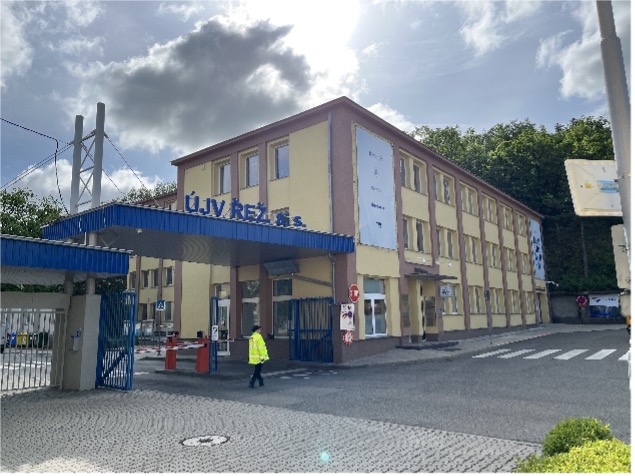
| 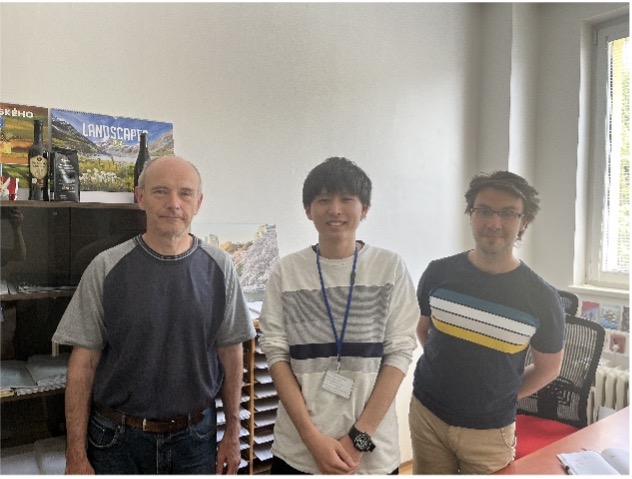 |
| Figure 1 The institute in Řež (May 16, 2023) | Figure 2 (Left) Dr. Petr Bydžovský,(Right) Dr. Dalibor Skoupil (May 29, 2023) |
I visited Nuclear Physics Institute of CAS in Řež, Czech Republic (Figure 1). It was the first time in a year since I had visited Prague last year for an international conference. However, I have never been to the institute. I stayed there about two weeks from May 16th to May 31st. My purpose of this trip was to discuss with the theorists, Dr. Petr Bydžovský and Dr. Dalibor Skoupil based on my analysis results. I have been analyzing the experimental data taken at Jefferson Lab in the U.S. to obtain the differential cross sections of the hyperon electroproductions. Dr. Petr Bydžovský and Dr. Dalibor Skoupil are at the forefront of theoretical research on the subject. After my arrival, we had a workshop and I presented about my analysis results. After the workshop, Dr. Petr Bydžovský gave us a lecture about the theoretical aspect of the hyperon electroproduction, and provide me with their computer programs. He was very helpful in teaching me everything and I soon learned to use their programs. During the second half of the stay, we discussed based on our experimental results and their calculation results. Unfortunately, Dr. Dalibor Skoupil was on a trip for his research most of my stay, but we were finally able to meet and discuss during the last week of my stay (Figure 2). I had the best research life in the beautiful city of Prague. Since I got used to living in Prague this time, I went sightseeing in cities away from Prague on the weekends to refresh myself.
During this entire stay, there was no work regarding experiments like a radiation worker training, cabling, detector operations, etc., but only time to discuss physics with theorists every day. Those were so stimulating days and valuable experiences for me, as if I were a student majoring in theory.

Ryoko Kino(M2 , Department of Physics, Graduate School of Science, Tohoku University)
March 2023, QE1 Special Award
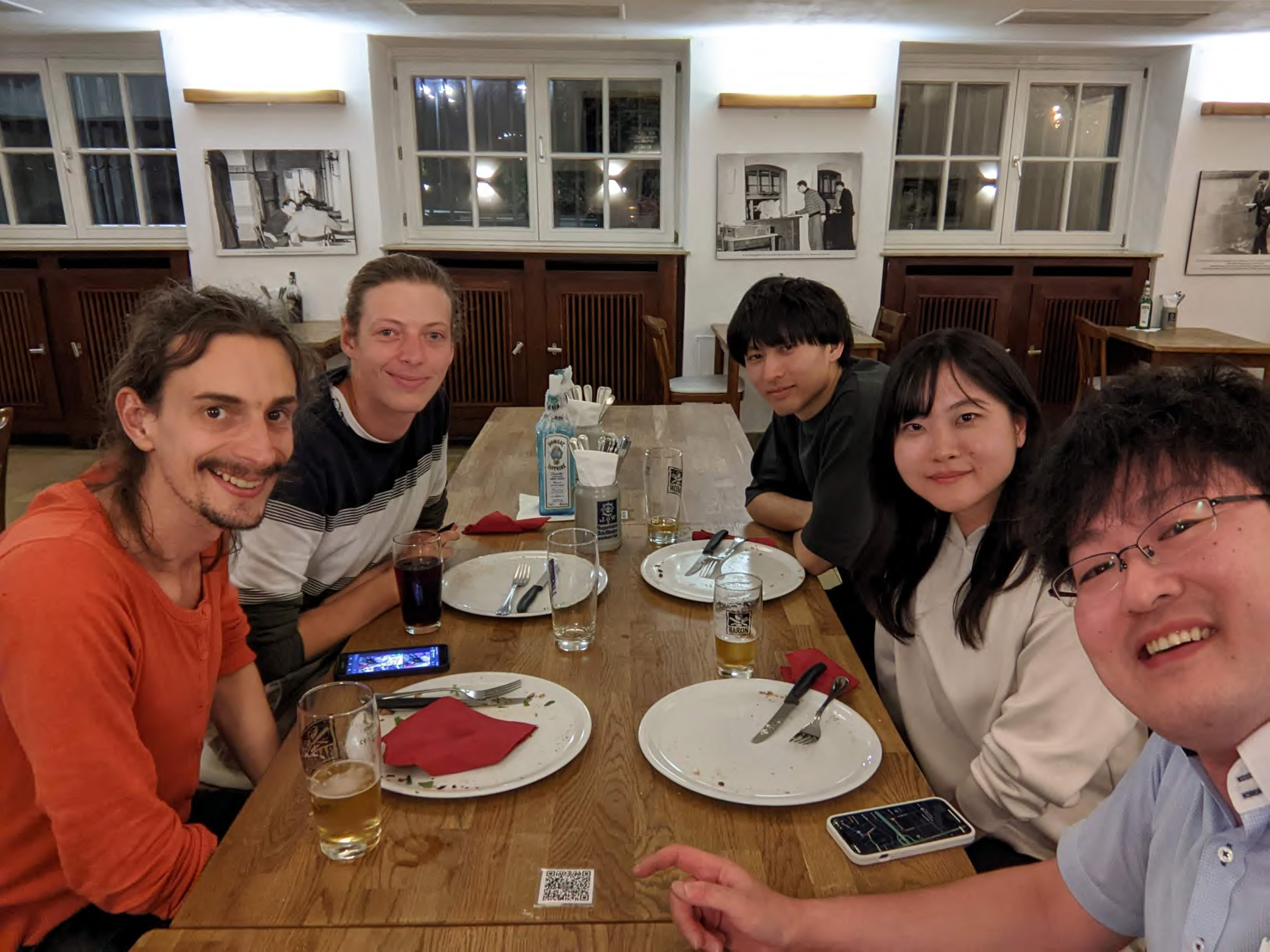
作業後にドイツの学生と乾杯しました。
この度はQE1 Special Award を頂き、誠にありがとうございます。
この1年を振り返ってみると、GP-PU国際研修の経験がやはり一番に思い返されます。国際研修を兼ね、ドイツ・マインツ大学に計4ヶ月間滞在し、最も基本的なハイパー核である「ハイパートライトン」の質量を高精度に測定する実験に参加しました。4ヶ月の間に、スペクトロメータの立ち上げ作業、コミッショニング(本実験の前の検証・試験実験)、物理実験、解析のディスカッションまで一連の重要なパートに現地で参加する経験を積みました。
原子核実験は数十人規模の比較的少人数で行います。その中でどのように存在感を発揮していくか、という部分を意識してこの国際研修に臨みました。私はグループの中でも最年少で、自分にできることも限られていたため、担当する仕事を責任を持ってこなすこと、コミュニケーションを積極的に取ることの二つに注力しました。これらを通して、実験に必要な知識や技術を学びながら、少しずつ相手にも自分の名前やできること・できないことを知ってもらうことができたと思います。しかし、始めのコミッショニング実験のときには、問題が起きた際にドイツ語に切り替わって議論が進んでしまい、置いていかれてしまうことが多々ありました。国際共同研究では、常に積極的に議論の中心に関わっていかないといけない、ということを実感しました。
GP-PU生になってからの1年間、英語によるセミナーや進捗報告会での議論などの機会に加え、英会話の勉強にも多くの時間をかけて取り組んできました。そして、何より一番大事な物理の勉強にも没頭した1年だったと思います。このように、自分の目標に向かってやりたいことに集中できた環境には、GP-PUのサポートは欠かせないものでした。
来年度以降も、引き続きドイツでの実験をPh.D. candidateとして責任を持って進めるとともに、中村研究室で推進している米国JLabにおける実験にも積極的に従事し、経験を積んでいきたいと思っています。

Ryutaro Tuji (D2 , Department of Physics, Graduate School of Science, Tohoku University)
2023/1/17-20, Singapore
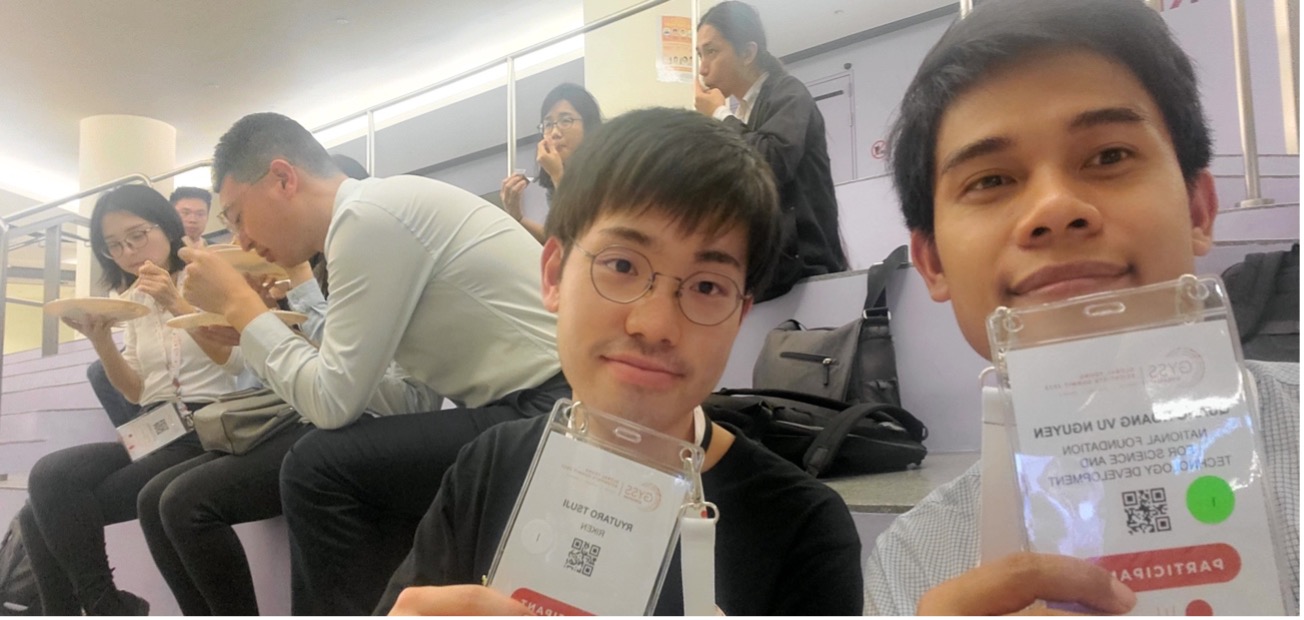
Figure 1. Chatting with my friend
I participated in the Global Young Scientists Summit (GYSS) 2023 held at the Singapore university of technology and design from 17th to 20th January. This summit is not an "ordinary" academic conference but brings together young researchers, including undergraduate students to post-doctoral researchers, and top scientists from around the world to discuss science and technology trends, future game changers, and how research could address major global challenges. During this summit, I attended 21 plenary lectures and 4 four panel discussions performed by Nobel laureates and eminent scientists. The lectures cover topics including physics, chemistry, biology, medicine, mathematics, computer science and engineering. I could learn lots of information from those lectures and had discussions with other participants. Furthermore, I attended a small group discussion with Sir David Klenerman, currently the Royal Society Professor of Molecular Medicine at the Department of Chemistry, University of Cambridge. He is working on next-generation DNA sequencing and got Millennium Technology Prize 2022. In this session, I could have advice about international collaborative research and the educational mindset of a scientist. In addition to the lectures and discussion sessions, we had plenty of time for communication during coffee break, breakfast, lunch and dinner. I had not only discussions about scientific topics such as the lectures and science communication, but also many conversations about our backgrounds. Especially, I could hear of the traditional food of Singapore, Malaysia, Vietnam, Pakistan, etc. I would like to have their recommendations someday. Even after the summit, I went to the beach and a bar with other participants and had a nice time.
The schedule was so tight that we all were exhausted, however, we could have a brilliant time in those lectures, discussions and conversations. I am sure that my experiences during my summit are very valuable in my life. I am sincerely grateful everything to the organizers and RIKEN's support.
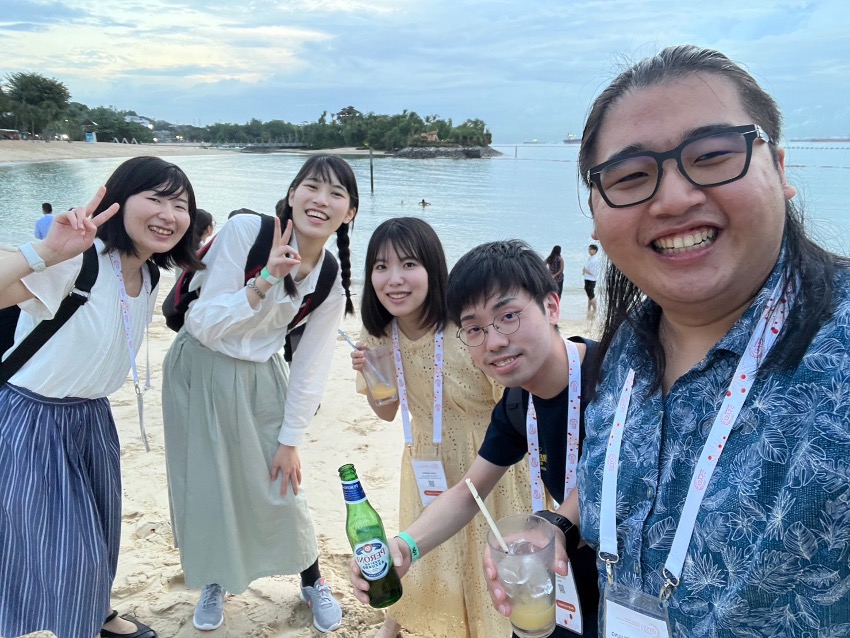
|  |
| Figure 2. Farewell party | Figure 3. Small group discussion with Sir David Klenerman (Center elderly man with red ribbon) |

Shunsuke Kajikawa (D2, Department of Physics, Graduate School of Science, Tohoku University)
Jun. 22 - Aug. 10th, 2022
私は、アメリカ・イリノイ州のフェルミ国立加速器研究所(Fermilab)に約50日間の滞在を行い、Fermilab内部のFermilab Test Beam Facility(FTBF)で行われるEMPHATIC実験のPhase-1b runへの参加を行いました。本実験は、高運動量の陽子・π中間子ビームを用いたハドロン生成・散乱実験です。今回のrunでは前回コロナのせいで持ってこられなかった新たな検出器等を設置し、前回より優れた実験セットアップでデータ測定を行うことができました。 ビームタイムの終了後には、本実験の解析に使用するart Frameworkについて現地で指導を受け、artを用いた測定データの解析を行いました。フレームワークを用いた解析に関しては、現地でソフトウェアのエキスパートと積極的に議論を行い問題への対処を行うことで、私の担当であるT0検出器の信号の確認を達成し、さらなる解析に向けた道筋をつけることができました。 今回の出張は2度目のフェルミ研究所への出張ということもあり、前回と比較しても精神的に余裕をもって実験・解析に参加することができ、前回で気が付かなかった問題の発見や、データに関する理解をさらに深めることができ、非常に有意義な経験をすることができました。EMPHATIC実験のグループの皆様には、実験時並びにその後のデータ解析において、様々なご指導や困った際のアドバイスをいただき非常に感謝しております。
On June 22nd - August 10th, I stayed at Fermilab in Illinois, U.S. to join the EMPHATIC experiment at FTBF (Fermilab test beam facility). EMPAHTIC experiment is a hadron production and scattering experiment and in collaboration with J-PARC E50 experiment, in which I participate. During the beamtime, I took part in this experiment as a PIC of T0 detector, a timing detector transported from Japan. After the beamtime, I learned the data analysis of EMPHATIC experiment to use the data for some study of E50 experiment. In the data analysis of EMPHATIC experiment, we use the art Framework, which is a software framework used in Fermilab experiments. During my stay, I learned how to use the art Framework and analyzed the T0 detector data in discussion with software experts. This was my second trip to Fermilab. So, I was able to participate in the experiment and analysis with more time to spare compared to the first time. Thanks to this time to spare, I was able to discover the problems which I had not noticed during my previous stay and further my understanding of the experimental data. In this stay, the members who came to Fermilab with me from Japan returned to Japan halfway through the stay, so I was the only member from Japan at the end of the stay. Although there were some difficulties due to the departure of the Japanese staff, I was able to conduct meaningful research thanks to the help of other EMPHATIC experiment members, my roommates.
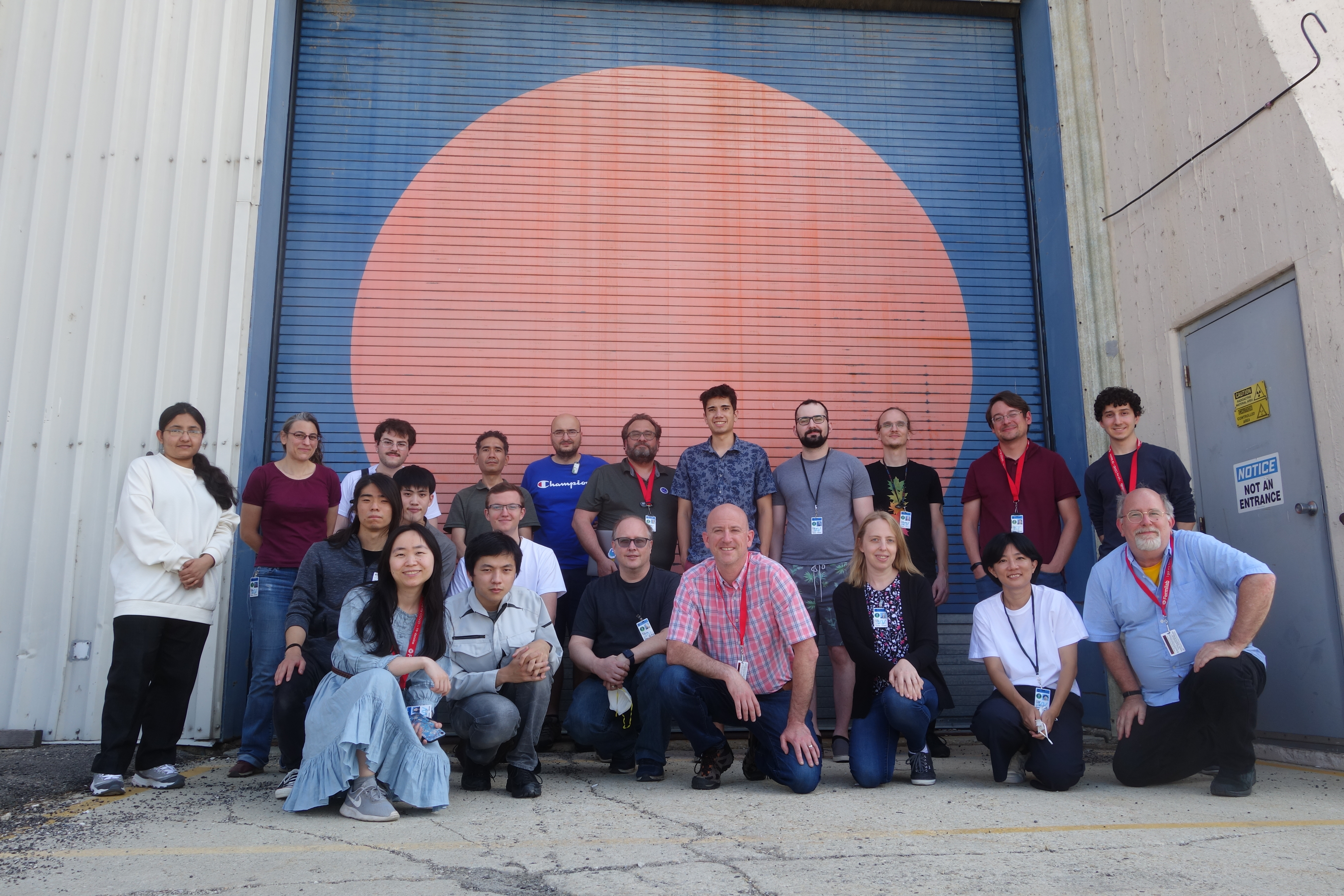
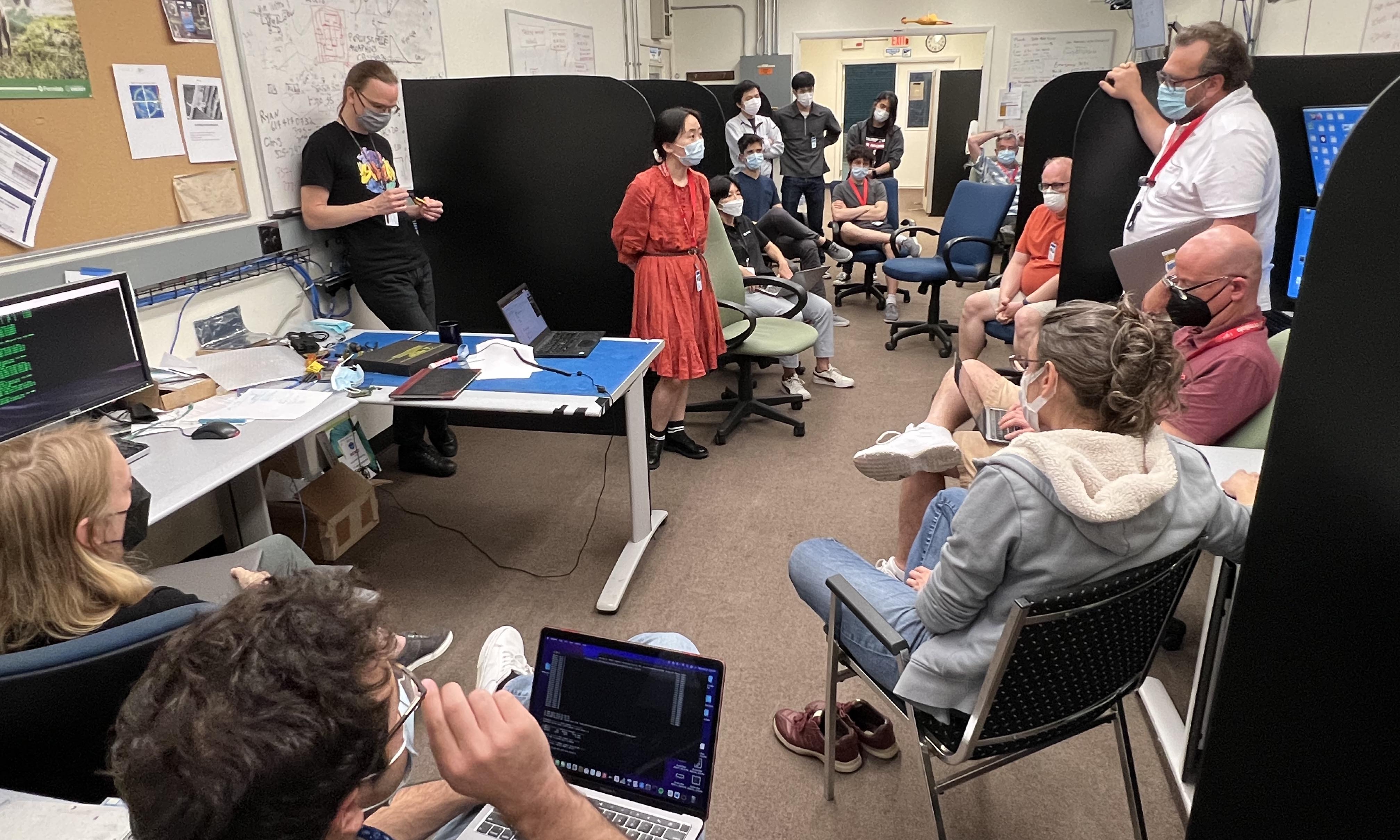

Kazuki Okuyama (D2, Department of Physics, Graduate School of Science, Tohoku University)
Aug. 28 - Sep. 13th, 2022
I visited Mainz in Germany again from Aug. 28th to Sep. 13th. The main purpose of this trip was to join the beamtime which was a continuation from last time in July. However, the beamtime was postponed due to the accelerator trouble after my arrival, so I had to do some preparation and analysis during my stay. I was able to resume my work there smoothly because it was a continuation of what I had been doing until just a month ago. In the second week, one of our collaborator Prof. Dr. Liguang Tang from JLab in the U.S. also visited Mainz. At that time, I was analyzing the previous data taken in July. He was so curious about my progress, and he listened my results and gave me advice every day. Since I have never had a opportunity to be supervised directly from him even though he is our collaborator, so the days spent with him were totally exciting and interesting. Unfortunately, I was too busy working in the experimental hall on the last day of his stay to take a picture with him. I would be happy to discuss my research about JLab experiment in more detail when I visit JLab someday.
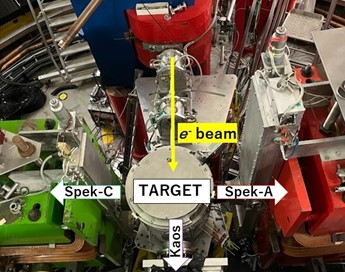

Asuka Kuwata (D2, Institute of Astronomy, Graduate School of Science, Tohoku University)
2022/08/27-09/04, Italy
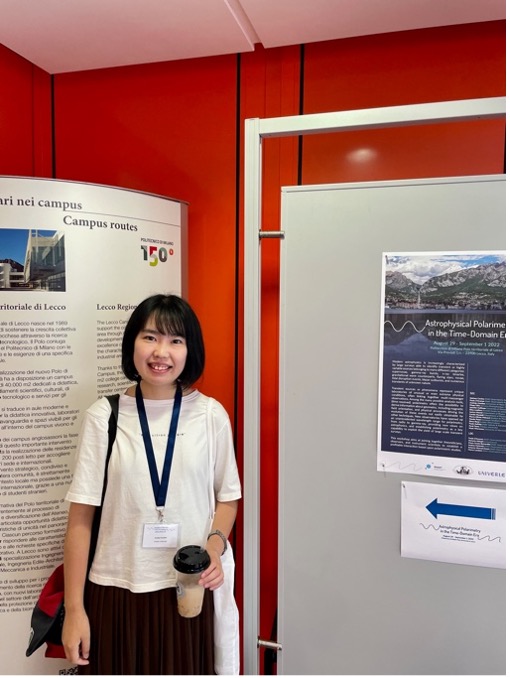
2022年9月1日、研究会の会場にて
イタリア北部、ミラノから電車で一時間ほどさらに北へ行くと、コモ湖という大きな湖があります。私は、コモ湖畔のレッコという町で開かれた、さまざまな天体現象の偏光に関する国際研究会に参加し、ポスター発表をしました。参加者70人ほどの比較的小規模な研究会でしたが、ガンマ線バースト/超新星爆発/ブレーザー/星間現象など幅広い分野の研究者が集まっており充実した内容の講演が聞けました。分野が広いせいか、みんな知り合いという感じでもなかったので、今回が国際研究会デビューだった私でも話しかけやすく、積極的に自分の研究成果のアピールをして有意義な時間を過ごせました。また、夕食のときにたまたま隣に座った人が、私の研究分野であるガンマ線バーストの残光の偏光について最近観測を始めたばかりの人で、その話で盛り上がって楽しかったです。
会議3日目の午後は自由時間で、会議参加者と一緒にコモ湖をボートでまわったり、町を散策したりしました。やはり日本人だというとアニメの話をふられると思ってナルトを予習していったのですが、ふられたのが「黄金バット」という古すぎるアニメの話だったので何もわかりませんでした。とはいえ、研究についての議論もでき、観光も楽しめて非常に充実した研究会でした。最後に、今回の研修をサポートしていただいたGPPUのスタッフ、研究会の主催者・参加者全員に感謝いたします。
I participated in the international conference "Astrophysical Polarimetry in the Time-Domain Era" held in Lecco, a town near Milano, from August 28 to September 1, 2022. Lecco is a beautiful town on the shore of a large lake called Lake Como. Surrounded by such beautiful mountains and lake, I made my first poster presentation abroad. In this conference, researchers of many kinds of astronomical phenomena came together and discussed their polarimetric observational features and theoretical interpretations. My research topic is theoretical calculation of polarization from gamma-ray burst afterglow, but I found that similar calculation conducted in the topic of blazar and I was impressed from their talk. In the poster session, I presented my recent work and discussed with many people, including Dr. Granot, Dr. Gill and Dr. Covino, who are experts of gamma-ray burst afterglow polarization. I also enjoyed a social dinner and free time during this conference. I went around the lake in a boat with 5 researchers I met at the conference. Overall, my experience at Lecco encouraged me to be more active in research, discussion and communication. I would like to thank all those who have supported this overseas training program.

Genta Sato (D2, Institute of Astronomy, Graduate School of Science, Tohoku University)
August 2022, Busan, Korea

シンポジウムの会場BEXCO(韓国・釜山)
このエッセイでは私が8月に行った海外研修について報告する。
2022年の8月2日から11日まで、International Astronomical Union (IAU)主催の国際シンポジウムが、韓国の釜山で開催された。私はそのシンポジウムの一部門であるIAU Symposium 373: Resolving the Rise and Fall of Star Formation in Galaxiesに、8月9日から11日までの3日間参加した。そのシンポジウムの場で、私はポスター発表を行ったり、他の研究者の口頭発表を聴講したりすることで、研究者に欠かせない国際コミュニケーションの経験を積んだ。
ポスター発表では、私が著者となって発表した、天の川銀河の構成はハローの広域分布に関する論文の内容をまとめたポスターを作成し、 シンポジウムの場で紹介した。発表時には、聴衆からの研究内容の詳細や今後の研究方針に関する質疑を受け、それに回答することで、私の研究をアピールするのと同時に、私自身もこの研究に対する批判点を客観的に受け止め、現在行っている研究へ活かす見通しを立てられた。逆に、私が他の研究者のポスターを閲覧し、出展者からの説明を受け、私が質問することで議論に発展することも多々経験した。ポスター発表では講演者と聴衆の距離が近いため、密度が高い議論を行うことができ、その結果ダークマター欠乏銀河の形成機構や、銀河中心から噴き出るジェットの形状など、彼らの研究をより深く理解することができた。一方、口頭発表の際は、より高度な研究内容について聴講することで、現在の星形成学や矮小銀河探査の状況について把握することができた。このシンポジウムへ参加して得られた経験は、私が今後国際的に活躍できる研究者となるための糧になることを確信している。
最後になるが、今回の私の海外研修を有意義なものにしてくれた、指導教員、GPPUスタッフ、シンポジウムのスタッフ・講演者にこの場を借りて感謝を申し上げる。

Kazuki Okuyama (D2, Strangeness Nuclear Physics, Graduate School of Science, Tohoku University)
2022/06/22-2022/07/22, Czech and Germany
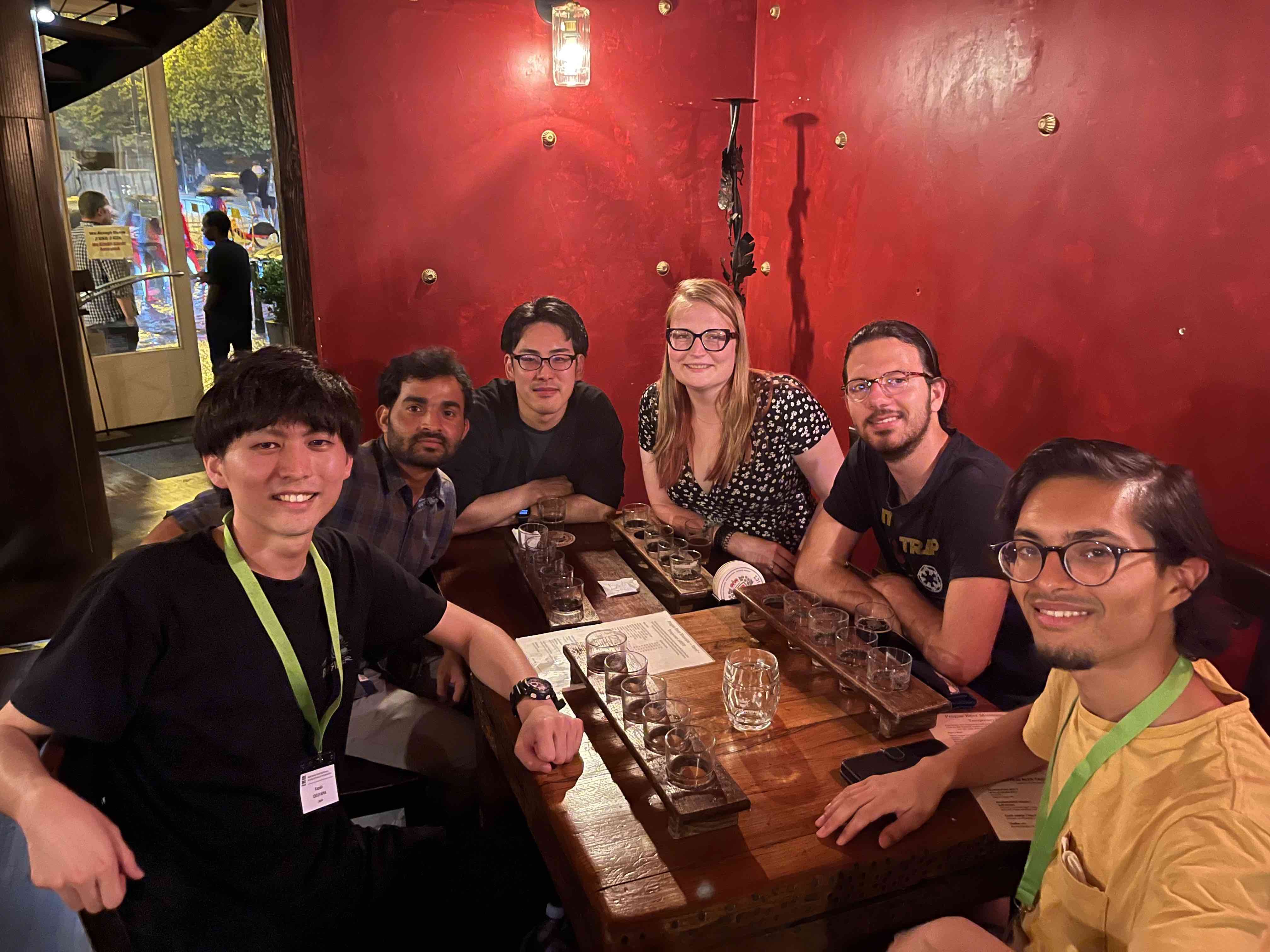
|  |
| Figure 1 A group photo with students who became friends during the summer school at a bar (June 24, 2022) | Figure 2 View of beautiful city and river of Prague from Petrin Lookout Tower (July 2, 2022) |
I visited Prague in the Czech Republic and Mainz in Germany for one month in total.
At first, I participated in the summer school (31st edition of the Indian-Summer School, ISS2022 https://indico.cern.ch/event/1141623/) and the international conference (The 14th International Conference on Hypernuclear and Strange Particle Physics, HYP2022 http://rafael.ujf.cas.cz/hyp2022/) held in the beautiful city of Prague, where I gave a poster presentation and an oral presentation, respectively. It was my first trip to Europe, and I was immediately struck by the gorgeous monasteries and castles and skyline after my arrival at Prague. I felt that this was exactly Europe I had imagined. Pilsner Urquell is a well-balanced beer in the Czech Republic and better than other typical beers in Japan for me. I enjoyed drinking it almost every night. I had beer at a bar with some ALICE collaboration students with whom I became friends during the summer school (See Figure 1).
After that, I moved to Mainz, Germany by ICE of Deutsche Bahn. As rumored, the train from Dresden to Frankfurt was cancelled on the day of departure, so I had to take another train to get to the destination.
In Mainz, the skyline was different from that of Prague, and cooled down my tourist mood, and brought back my awareness that I had come to participate in the experiment and switched me back to a research mood. I visited Mainz at the most critical time, just before and just after the beginning of beamtime, so I was able to concentrate and work with students from Mainz University and keep myself busy. No matter how tired I was, I ended the day with Bier(beer) and Wurst(sausage), by the way.
Finally, I would like to describe my impressions of this trip as a whole. As I have only visited the United States so far, so I would like to look back on this trip to Europe compared to the U.S. The official language in many European countries is not English, so information, guidance, and signs are not always written in English. Therefore, I was disappointed that studying only English would not mean that all overseas travel would be successful. I felt that this was an inconvenience compared to living in English-speaking countries such as the United States. On the other hand, because of this, there is a sense of mutual cooperation each other when speaking in English, so in a sense, I have the impression that we were able to speak more equally than when speaking with native speakers.
In Europe, the units of temperature and size etc. are familiar to Japanese people (although the U.S. may be just a special case), and the food and the scale of everything fit to Japanese people (although the U.S. may be just a special case as well), so I felt that life in Europe was more or less easy (unless getting sick).

Sei Saito (D2, Institute of Astronomy, Graduate School of Science, Tohoku University)
2022/04/09-24, Chile
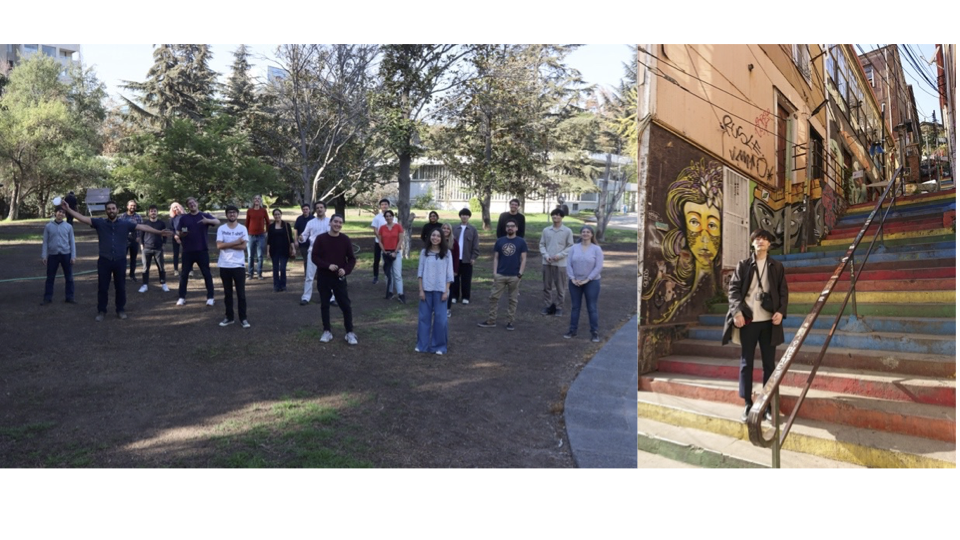
I visited Chile in April 2022 for two weeks. The experiences in Chile were unforgettable. I chose the best three things from them to write in this essay.
First, I joined a face-to-face workshop in the first week, which was a lot of fun. It had been a while since I had joined an offline workshop. In the workshop, I was moved that I again met Ph.D. students whom I had met three years ago on other overseas travels. Besides, detailed discussions after presentations in the workshop gave me enjoyment. Chatting during the break time was also great. On-site workshops are literally awesome! The top-left picture shows all the participants of the workshop with social distances.
Second, I discussed many things with Chilean people in the second week. The fruitful discussions have driven future collaborations with people in Chile. Besides, what was glad was that I felt an improvement in my English skill. When I had gone overseas three years ago, I had only managed to communicate with people in English, even with much help from my supervisor. But this time, I was able to communicate in English by myself. Although there is still much room for improvement in my English, this trip to Chile has further improved my English skill.
Third, I visited Valparaiso on the weekend. It is one of the most famous world heritages in Chile. All the walls in Valparaiso are painted, which has made the streetscape itself a world heritage. The colorful picture on the top right was taken in Valparaiso. The beautiful scenery on the other side of the Earth has fascinated me, making me look forward to my next trip.
I have been glad from the bottom of my heart that I was able to visit Chile even under this pandemic situation. Wonderful was the trip. Special thanks to all the people involved in it.
このエッセイは英語と日本語の両方で書くことになっているのですが、英語で書いた内容の日本語訳を書くだけならDeepLで十分なので、せっかくなら英語の方とは異なる内容を書いてみたいと思います。
チリの2週間の滞在は筆舌に尽くし難いほど良い経験になりました。以下には英語版の方に書いたこととはまた別の、印象に残ったことを3つ書きます。
1つ目は、観光の最中に全然知らない人と友達になったことです。週末に街を歩いている時、いろんな人から「一緒に写真撮ろう!」「どこから来たの?」などと声をかけられました。その流れで少しお喋りして仲良くなって、結局この出張の間に合計4人の見知らぬ人とインスタを交換しました。もしかしたら南米の人にとって東洋人は結構魅力的に映るのかもしれません。街行く人に何度も声をかけられると、まるで自分が芸能人にでもなったかのように感じて最高の気分でした。出張で行く場所に迷っている方には、候補の1つとしてチリをオススメしておきます。
2つ目は、多くの外国人が日本のアニメが好きだと実感したことです。上に書いた人たちも含め、多くの外国人が日本のアニメが好きと言っていました。好きなアニメの例として挙げられたのが、進撃の巨人・呪術廻戦・鬼滅の刃・四月は君の嘘・スラムダンク・らんま1/2・セーラームーンなどです。その中でも複数の人が進撃の巨人が好きと言っていたので、進撃の巨人は日本人の必修科目にした方が良いのではないかと思いました。個人的には、進撃の巨人は一般常識として電磁気学とか量子力学とかと同じくらい我々にとって重要な科目だと思います。
3つ目は、チリの海鮮料理が本当に美味しかったことです。チリは国の西側が海に沿っている国なので、海鮮がとても有名です。今回のチリ出張では様々なチリ料理を食べてみましたが、その中でもpaila marina(パイラマリーナ)という海鮮スープが絶品でした。Paila marinaは、ハーブの効いた貝出汁のスープに具材として鮭・タコ・イカ・ウニ・ムール貝などの海の幸がたくさん入っているものです。たまたま立ち寄ったレストランで店員さんに「This soup is very good! Try it!」と元気良く言われたので何も考えずにそれを注文したのですが、感動するレベルで美味しかったです。美味しすぎて食べている間に思わず顔が綻んでしまいました。これを食べるためだけにまた30時間かけてでもチリに行きたいくらいです。
ここまでに書いた3つ(英語の方も含めれば6つ)以外にも、今回の出張では数多くの貴重な経験を得ることができました。もっとたくさんのことをこのエッセイに書きたいところですが、すでに十分な量の文章を書いてしまっているのでこのあたりで筆を置きたいと思います。
…と思ったのですが、ちょうどここまで書き終わった頃に面白いことが起こったのでもう少しだけ続けさせてください。このエッセイは夜の11:50にチリを飛び立つ(はずだった)帰りの飛行機の中で書いていたのですが、搭乗後から3時間が経っても飛行機が全く動かず、結局その便は欠航になっていまいました。どうやら機材トラブルがあったようです。振替の便は次の夜に出るとのことで、その時間までは航空会社が手配したホテルに滞在することになりました。便の振替の手続きにかなり時間がかかったので、そのホテルにチェックインしたのは朝8:00頃になってしまいました。朝にホテルにチェックインするというのは何とも不思議な感覚ですね。ホテルに着いた頃には既にものすごく眠かったのでチェックイン後すぐにベッドに倒れ込んだのですが、日本時間の夜9:00頃に就寝したことになったので時差ボケの解消に役立ちました。欠便様様です。飛行機の欠航が決まった時には少し焦りましたが、英語も喋れるチリ人のおじいさんの助けもあって何とかなりました。こういった親切な方との巡り合わせも出張の面白いポイントだと思います。というわけで飛行機の欠便で帰国が1日遅れてしまった話でした。
長くなってしまいましたが、今度こそ筆を置きたいと思います。今回の出張は最後のトラブルも含め楽しい思い出になりました。この出張での様々な経験を糧にして、今後も日々研究に勤しんでいきたいと思います。この出張をサポートしてくださった方々、この出張で出会った全ての方々に感謝します。

Nanae Domoto (M2, Institute of Astronomy, Graduate School of Science, Tohoku University)
2022/03/15, QE1 Special Award
この度はSpecial Awardを受賞することができ大変嬉しく思っています。修士課程の終わりにこのような賞をいただけたのは、今後に向けての激励だとも受け止めています。周りの方々のお力添えをいただきながら、変わらず精進していきたいと思います。 GP-PUの特徴の一つは、やはり国際講義や互いの研究発表を通じて、様々な異なる研究分野の話を聞くことができる点だと感じています。もちろん馴染みのない分野の話を理解することは容易ではなく、付いていくことで精一杯なときもしばしばですが、全く知らないと思っていた話が自身の知っていることに結びついたり、異なる分野の知識が天文学の同じ対象に用いられたりすることは非常に面白い点です。一言で天文学と言っても様々な分野がある中、中性子星や元素合成に関わるテーマで研究している私にとって、素粒子や原子核の物理学分野は非常に近い分野です。そのためGP-PUの枠組みにおける"耳学問"の積み重ねは、自身の研究を体系的に捉える手助けになっていくものと考えています。また、GP-PU内での発表は研究会や学会での発表と異なり、専門用語をなるべく使わず平易に説明をする必要があります。これもまた、自身の研究を俯瞰的に捉え端的にまとめる訓練であり、他ではあまり経験することのないものです。聴衆を考えて準備と発表をすることは、いかなる発表の場でも役に立つことと感じています。 私はまだGP-PU生としての1年目を終えるところです。残り3年の期間も貴重な経験を自身の成長につなげられるよう、努力していきたいと思います。

Ronaldo Laisharm (D1, Institute of Astronomy, Graduate School of Science, Tohoku University)
2021/11/23-12/1, Tenerife, Spain
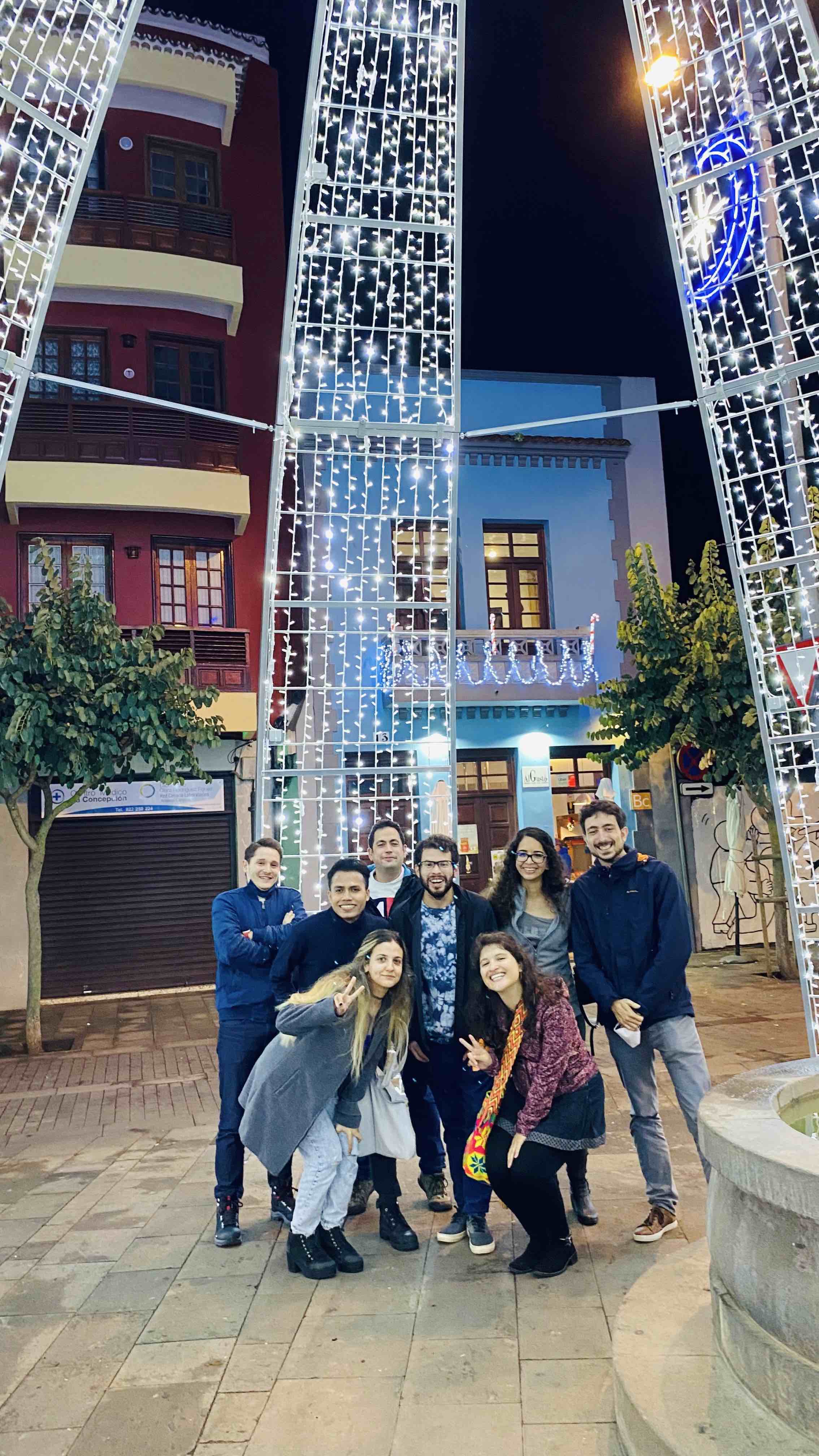 |
 |
I attended XXXII Canary Islands Winter School which was held in San Cristóbal de LaLaguna (Tenerife, Spain) from 23 November to 1 December 2021. The school focuseson Galaxy Clusters. It provided us with the opportunity to learn from world-renownedspecialists about galaxy clusters and also to highlight my current work to others.I met a lot of friendly young researchers from around the globe who are currently working ongalaxy cluster. I learned a lot about galaxy formation and evolution from the lecturers andnew friends. The world is small and the earth is round. I also met old friends whom I met inpast conferences. Even though the timing was short, the bonding among us was very strongwith lots of good memories. I have to say that I don’t know if galaxy clusters are the mostinteresting thing in the universe but they have for sure some of the nicest people are workingon them.
Apart from learning, we also had the chance to visit some of the famous places around thevenue. We went to Teide Observatory and lots of historic places. We also visited randomplaces across this beautiful island such as lovely beaches, museums etc. We went to differentrestaurants to try different types of food. The food was super appetising. I love Tenerife.Words are short to describe this beautiful island.
I also got the chance to visit a short trip around Madrid. Being a great football fan (my namejustifies it), I visited Real Madrid Stadium (Santiago Bernabéu Stadium). The experience wasamazing. I also visited some of the tourist places around the city. The city seems to be in ahurry to say everything. I fall in love with this beautiful city.
In general, those experiences made my first stay in Europe a very satisfactorily memory. Ilearned a lot about the galaxy clusters, made awesome friends and visited and explored lotsof stunning places with amazing food. During this short trip, I had a fruitful life and researchactivities. I would like to thank GPPU and my professor very much for providing thisopportunity. I am very grateful for GPPU's support. I am hoping to attend more conferencesand research activities with GPPU support.

Mao Zhiying (D1, Institute of Astronomy, Graduate School of Science, Tohoku University)
2021/11/23-12/1, Tenerife, Spain
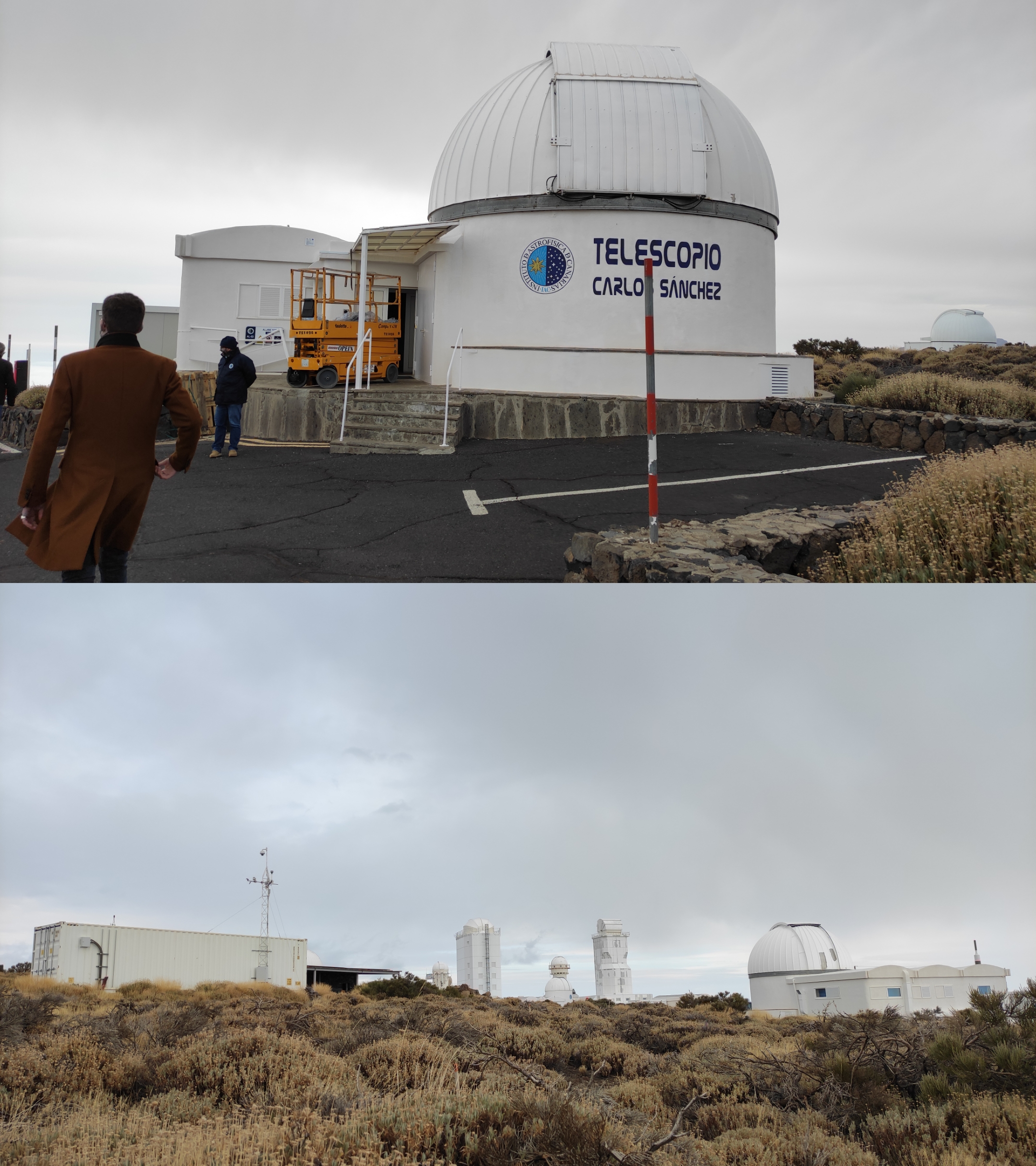
I joined the XXXII Canary Islands Winter School of Astrophysics: Formation and Evolution of Galaxy Clusters Across Cosmic Time from Nov 23 to Dec 1, 2021, in Tenerife, Spain. In the two weeks, I attended a series of lectures featuring galaxy clusters at different redshifts, evolution of galaxies in clusters, current survey for galaxy clusters, and numerical simulation of galaxies. Moreover, I joined the hand-on tutorial section to learn to use simulation data. Apart from these indoor activities, I visited the Izana observatory on Tenerife Island, which is a very active and productive observatory today. Between the main sections of the winter school, I chatted with other young researchers even the lecturers. This is a rare opportunity for me to build connections with other researchers in
this pandemic situation.
Tenerife island is a tropical island near Africa with good weather all over the year. Therefore, I had a chance to walked around the city, even to the other side of the island to enjoy the marvelous view of coastline. The whole trip was a memorable and precious experience.

Message from Masashi Nashimoto (Research Staff, National Astronomical Observatory of Japan)
December 2020

Message from Shunki Ishikawa (D2, Department of Physics, Graduate School of Science, Tohoku University)
October 2020

Shinnosuke Nakai (D2, Department of Physics, Graduate School of Science, Tohoku University)
February 14-27 2020, Triangle Universities Nuclear Laboratory (TUNL):Durham, NC 27710, USA
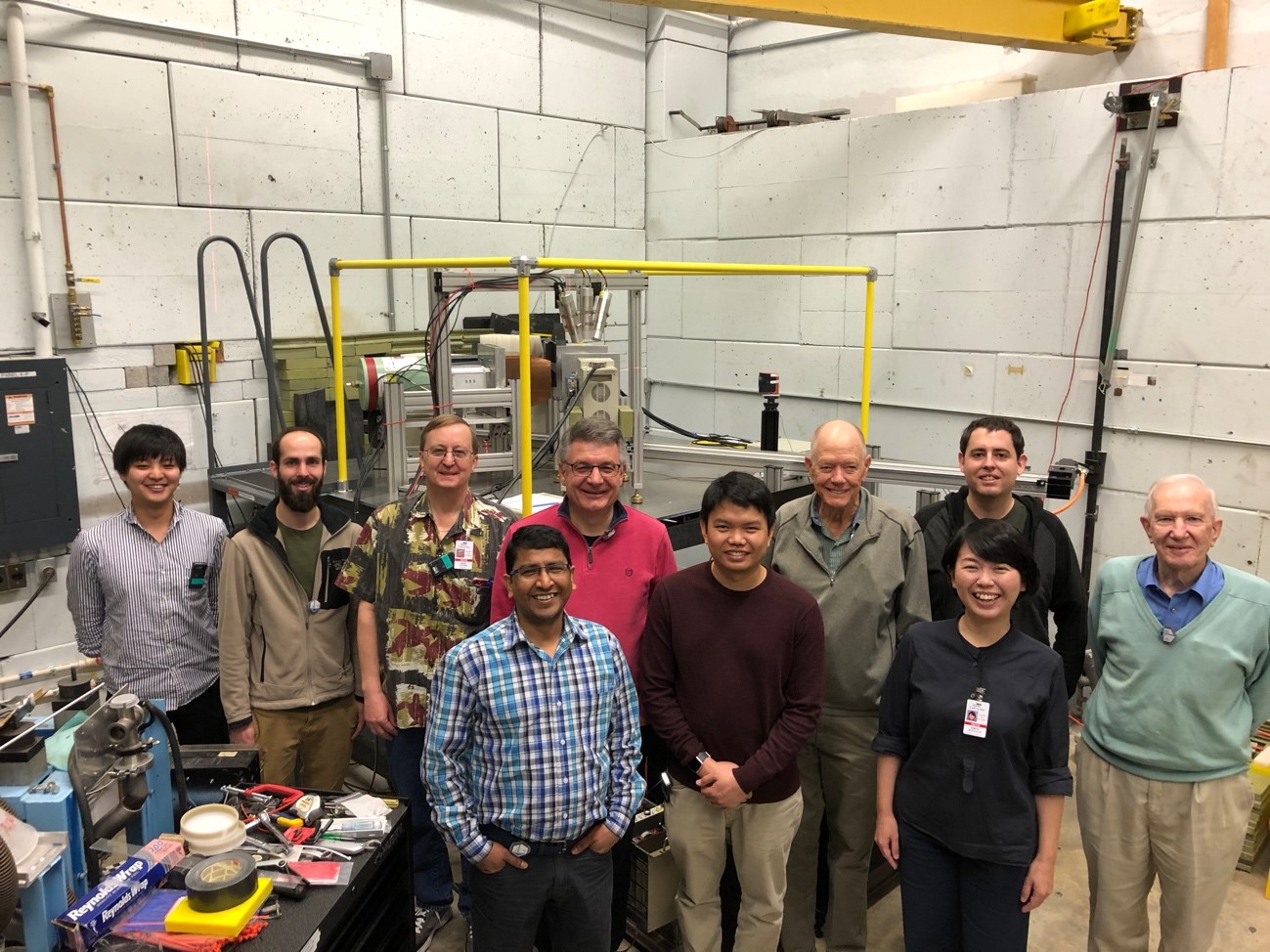
I have joined the Fission Products Yields(FPY) experiment at Triangle Universities Nuclear Laboratory (TUNL) at Durham, NC, USA. TUNL has a sophisticated tandem accelerator and there are so many experienced staff members. The experiment which I joined was so big experiments that many collaborators came to this experiment from Lawrence Livermore National Laboratory (LLNL) and Los Alamos National Laboratory (LANL). They have developed RABBIT system which is designed to transport the target sample over the larger distance of about 10 m within 1 second with respect to the measurements of prompt fission neutron energy spectra. I checked the performance of Ge detectors of RABBIT system with the collaborators. They taught me a lot of things for that experiment and we discussed about it. I really had great experience there. And also, they were so kind to me. They took me out to many american restaurants and I had xcellent and unique meals and enjoyed them.

Hajime Ogane (M2, Institute of Astronomy, Graduate School of Science, Tohoku University)
November 2019, Waikoloa Hawaii, USA
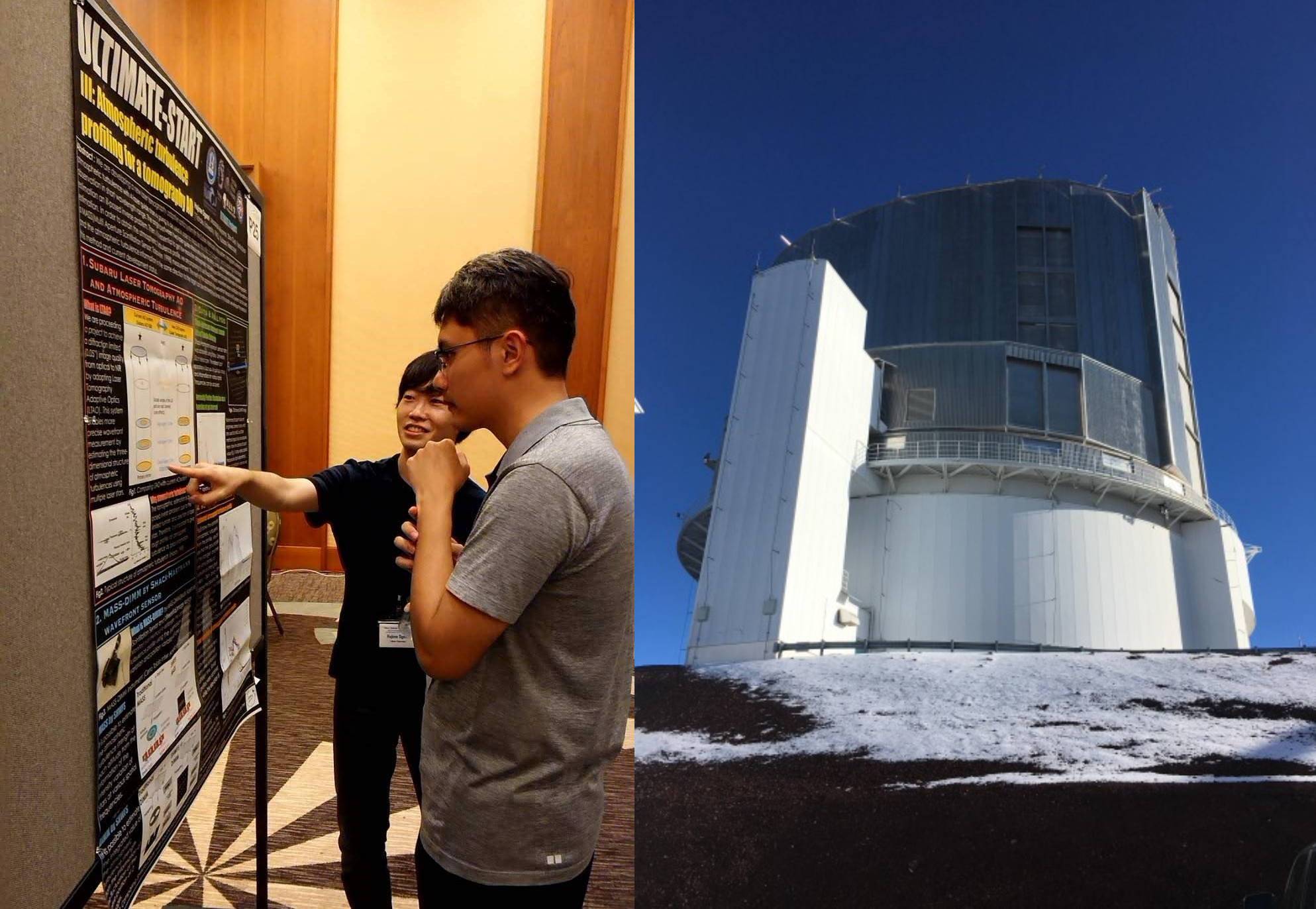
11月17から22日にハワイ島西部のワイコロアで開催された、SUBARU TELESCOPE 20TH ANNIVERSARYに参加しました。 世界最大級の大きさを誇るすばる望遠鏡は、ハワイ島にそびえる標高約4000mのマウナケア山頂に建設されています。 天文学者にとって聖地のようなこの島で、すばる20周年を記念した国際会議が開かれました。 すばるは近年の天文学の著しい進歩を大きく支えてきました。本研究会はこれまでのすばるの成果を振り返りつつ、 現在行われている最先端の研究や、将来どのような戦略で生き残っていくのかなどを議論するものでした。 私はポスター発表とショートプレゼンテーションを行いました。セッションの合間に有名なビーチに赴きウミガメと出会えたり、 少しだけ近くにあるホテルのプールや海で遊泳をしたりしました。
I participated in the "Subaru Telescope 20th Anniversary" held in Waikoloa on the western side of the Hawaii Island from November 17 to 22. Subaru Telescope, which is one of the largest telescopes in the world, is located on the summit of Mauna Kea in the island of Hawaii. This international conference was taken place on this sacred island to celebrate the 20th anniversary of Subaru Telescope. Subaru has been a major contributor to the remarkable advances in astronomy. In this meeting, we looked back at Subaru's achievements to date and discussed current cutting-edge research and strategies to survive in the future. I gave a poster presentation and a short presentation in English. In between sessions, we visited a famous beach, met sea turtles and went swimming in the pool and sea.

Naoaki Yamamoto (M2, Institute of Astronomy, Graduate School of Science, Tohoku University)
November 2019, Waikoloa Hawaii, USA
11/17-22にハワイ島ワイコロアにて開催された、すばる望遠鏡20周年記念シンポジウムに参加しました。 すばるによる最新の研究成果発表に加え、今後の観測プロジェクト、他の望遠鏡との連携戦略にまで 渡って幅広く議論が交わされる大規模なものでした。この研究会で私は、すばる補償光学用の新波面センサー 開発に関わる研究のポスター発表を行いました。英語による説明は初めてでしたが、多くの人に何度も 説明することで次第にスムーズな受け答えができるようになったように感じました。また、11/24-27 にはマウナケア山頂のすばる望遠鏡を訪れ、新波面センサーのインストールへ向けたビームスプリッター の交換作業を行いました。マウナケア山頂は標高が4000mを超えるため酸素は地上の60%, 気温は0度ほどしかありません。(「今冬の初雪はハワイ」という奇妙な名言も生まれました。) 予想以上のハードワークでしたが、実際の大型観測施設における光学実験ができたことは今後に役立つとても貴重な経験でした。 さらに期間中を通して来年度からの研究内容に関する助言を頂けたり、休日には観光地に連れて行って頂けたことも含めて、 非常に実りのある海外研修になったと思います。このような機会をくださったGPPUに感謝申し上げます。
In November 17-22, I joined Subaru 20th anniversary symposium held at Waikoloa Hawaii. There were a wide range of discussion themes including latest results from Subaru, future observation projects and collaboration strategy with other telescopes. In this symposium, I made a poster presentation about the development of new wavefront sensor for Subaru adaptive optics. This was my first time of presentation in English but I felt my presentation skills improve as I repeated explaining. In November 24-27, I visited Subaru telescope at the top of Mauna Kea, and replaced a beam splitter for installation of the new wavefront sensor. The top of Mauna Kea has an altitude of over 4000m, so oxygen is 60% of sea level and the temperature is only 0 degrees. (A strange quote “The first snow in this winter is at Hawaii” was born.) Though it was a hard work than expected, optical experiments at real large observational facility was precious experience that will be useful in the future. I also got some advices about my research from next year, and visited famous spots. I appreciate GPPU for giving me such a fruitful overseas training.

Chihiro Yoshida (D1, Department of Physics, Graduate School of Science, Tohoku University)
September-October 2019, Laboratori Nazionali di Frascati, Italy
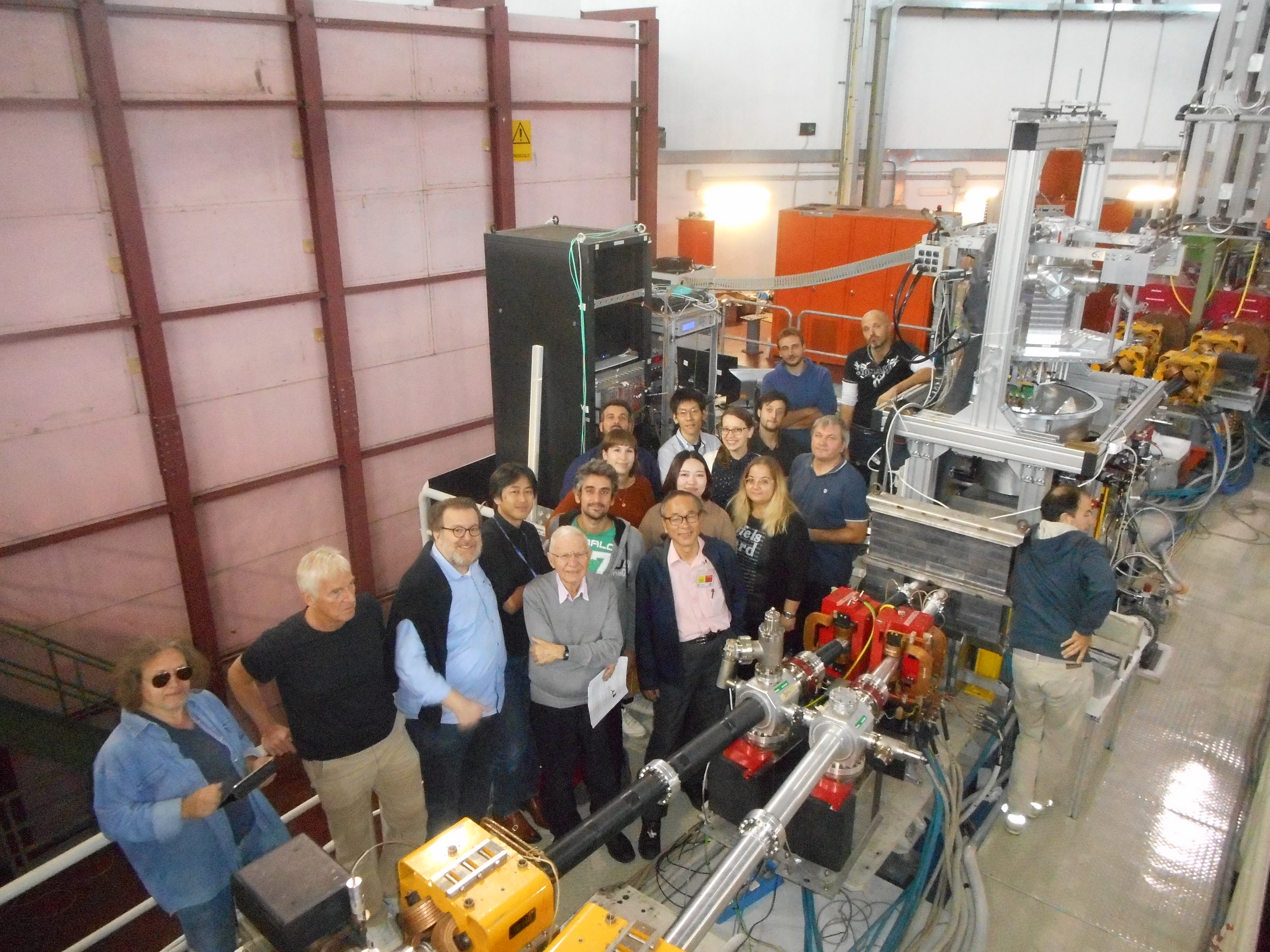
9月末から約1ヶ月間イタリアに滞在し、INFN-LNFのDAFNE加速器にて行われたK中間子原子X線精密分光実験 (SIDDHARTA-2実験)とトレントにて行われたストレンジ物理学に関するworkshop(STRANEX)に参加してきました。 今回の滞在ではK中間子原子から生じるX線を検出するためのシリコンドリフトディテクター(SDD) のキャリブレーションのためのデータを取得しました。INFN-LNFのみなさまは実験のシステムや 解析方法について教えてくださっただけでなく、滞在中の生活に関しても手厚くサポートしてくださり、大変感謝しています。 STRANEX workshopでは世界中で行われているストレンジ核物理に関する理論的・実験的な最先端の成果について学びました。 break time中に同年代の学生と議論を行ったり時には卓球をして、とても楽しい時間を過ごすことができました。 来春に再びINFN-LNFを訪問することを考えています。またINFN-LNFのみなさまに会えるのがとても楽しみです。
I joined the SIDDHARTA-2 experiment used X-ray spectroscopy of the kaonic atoms ]at DAFNE collider of Laboratori Nazionali di Frascati and participated in STRANEX which was a workshop for strangeness nuclear physics at Trento, Italy. During this stay, we took data for the calibration of the Silicon Drift Detectors (SDDs) to detect X-rays from kaonic atom. Reseachers of INFN-LNF taught me about the experiment system and analysis and helped me with my daily life. I appriciate them very much. In the STRANEX workshop, I learned about the the most recent progress in the studies of strange exotic atoms. During a break time, I enjoyed the discussion and playing table tennis with students around the same age. I'm planning to visit INFN-LNF next spring again. I can't wait to see INFN-LNF members!

Naoaki Yamamoto (M2, Institute of Astronomy, Graduate School of Science, Tohoku University)
July 8-12 2019, "Tracing Cosmic Evolution with Clusters of Galaxies"
7月8日から12日にオーストリアとイタリアにまたがる南チロル地方の農村で開催された、 Tracing Cosmic Evolution with Clusters of Galaxiesという国際研究会に参加した。 この研究会はおよそ六年に一度催され、各国の銀河団研究者が一堂に会する。初めての 国際会議の参加だったが、世界に先駆けて成果をあげるためには何が必要であるか感じ取ることができた。 また国や研究機関によって得意分野が異なっており、国内でこれまで決して知ることのできなかった プロジェクトについて理解を深めることができた。拙い英語であるもののポスター発表を行い、 懇親会では特に海外の学生と交流できた。さらに最寄りの空港近くの水の都ヴェネチアを観光した。 16世紀のヴェネチア共和国時代の名残が現在も残り続け、異国情緒溢れる美しい街並みや美味しいイタリアン料理などを満喫することができた。
On 8-12 July, I took part in the international conference, "Tracing Cosmic Evolution with Clusters of Galaxies", held in a rural South Tyrol that straddles Austria and Italy. This conference is held about every six years and researchers of galaxy clusters join from all over the world. This was my first international conference, but I was able to get a sense of what we need to achieve results ahead of the world. In addition, I was able to deepen my understanding of projects that I had never learned in Japan before, as different countries and research institutions have different areas of expertise. I made a poster presentation with my (poor) English, and I could interact with students abroad at the banquet. Incidentally, Venice, the city of water, is located near the nearest airport and we enjoyed Italian food, exotic and beautiful streets, where the remnants of the 16th century Venetian Republic era still remain.

Keita Uehara (M2, Department of Physics, Graduate School of Science, Tohoku University)
17 July - 4 August 2019, Thomas Jefferson National Accellerator Facility (JLab), Newport News, VA, US

7月17日から8月4日までの約二週間半の間、アメリカ・ジェファーソン研究所(JLab)に滞在し、 PAC(課題採択委員会)への参加と将来行うΛハイパー核分光実験の準備を行いました。 課題採択委員会では様々なグループから将来JLabで行われうる実験の提案がプレゼンテーションされ、 最先端の研究について学ぶことができました。また、実験準備に関しては以前使用した 検出器が次の実験でも使用できるか、どのようなクオリティであるかをハンプトン大学の学生と協力しながら確かめました。 写真は検出器のテストが終わったときにその学生と一緒にとったものです。 次の実験では私と彼が中心メンバーの一人として実験および解析を行います。その時には彼と協力しながら、 そして切磋琢磨しながら進めていければと思っています。
From Jul. 17th to Aug. 4th, I stayed at Thomas Jefferson Lab (JLab) in the U.S. to attend PAC (Program Advisory Committee) and prepare for the next Λ hypernuclear spectroscopy experiment. In PAC meeting, many researchers gave presentations of their new experiment proposals and showed their results of experiment carried out at JLab. It was very interesting and a good opportunity to know what other researchers do at JLab. And also, to prepare for the next experiment, I checked the performance of one of our detectors with a student from Hampton University. This picture of him and me was taken when the detector test had done. He and I will be core members of the next experiment and do analysis. At that time, I want to work with him in friendly rivalry and get fruitful results.

Keita Sakai (D1, Department of Physics, Graduate School of Science, Tohoku University)
15 June - 2 Aug 2019, European Center for Theoretical Studies in Nuclear Physics and Related Areas

From Jul. 15th to Aug. 2nd, I joined summer school "From quarks and gluons to nuclear forces and structure" at ECT* in Trento, Italy. In this school there were students who study theories of nuclear physics and hadron physics, from Europe, Asia, Americas, etc.. For three weeks, I attended the lectures about lattice QCD, chiral effective theory, and some other subjects, and did actual numerical calculations too. I discussed about those subjects such as “gradient flow” on lattice QCD, which is essential in my own research with foreign students and teachers. That was very precious experience for me. I was nervous because a lot of things were my first experience, but all of that was very good experience and will be helpful for my future work in overseas.
7/15-8/2にイタリア・トレントのECT*で開催されたサマースクール”From quarks and gluons
to nuclear forces and structure”に参加しました。このスクールではヨーロッパをはじめと
してアジア、南北アメリカ、等世界各地から原子核・ハドロン物理の理論分野を学ぶ学生が集まっ
ていました。三週間に渡り格子QCDやカイラル有効理論、またその数値計算技術等の講義を受けたり、
実際に手を動かして課題や数値計算を行うなどしました。その中で海外の学生達や講師陣とも議論を行うなど、
私としては初めてのことが多い貴重な経験でした。中でも私の研究でも中心的な役割をもつ格子QCD
における”Gradient flow”に関するものが印象に残っています。初めての体験ばかりでおっかなび
っくりな面もありましたが、この体験を元に今後の海外での研究活動を実りあるものにしていきたいと思います。

Taiki Ogihara (D2, Institute of Astronomy, Graduate School of Science, Tohoku University)
July 2019, Manchester, UK
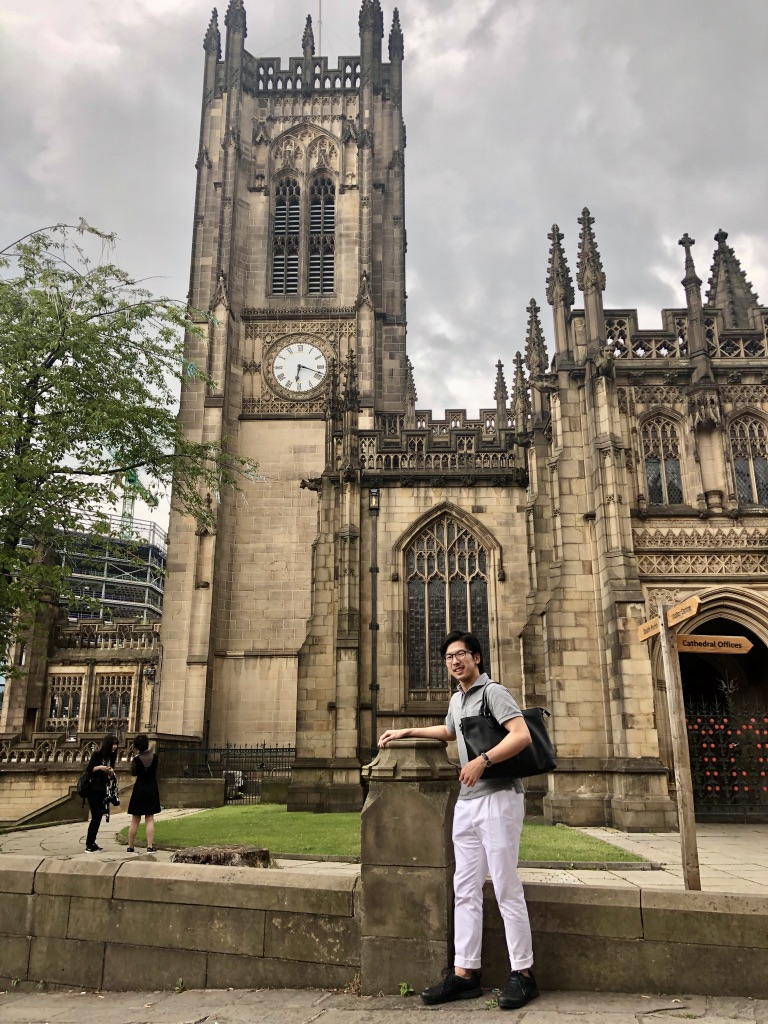
After the conference at Barcelona, I went to Jodrell Bank Observatory located at the suburb of Manchester, UK to attend the international conference "A Centenary of Astrophysical Jets: Observation, Theory, and Future Prospects". At this conference, fortunately, I could talk about our study in front of 120 people. Most participants in this conference have a different background or different interest from the ones of the conference at Barcelona. The topics of HEPRO7 was about the high energy physics related to jets. This conference tended to focus on radio observations and their theoretical interpretations. So, I could listen to a lot of studies about astrophysical jets from a different point of view. I had spent very busy days discussing with many observational and theoretical researchers.

Taiki Ogihara (D2, Institute of Astronomy, Graduate School of Science, Tohoku University)
July 2019, Barcelona, Spain
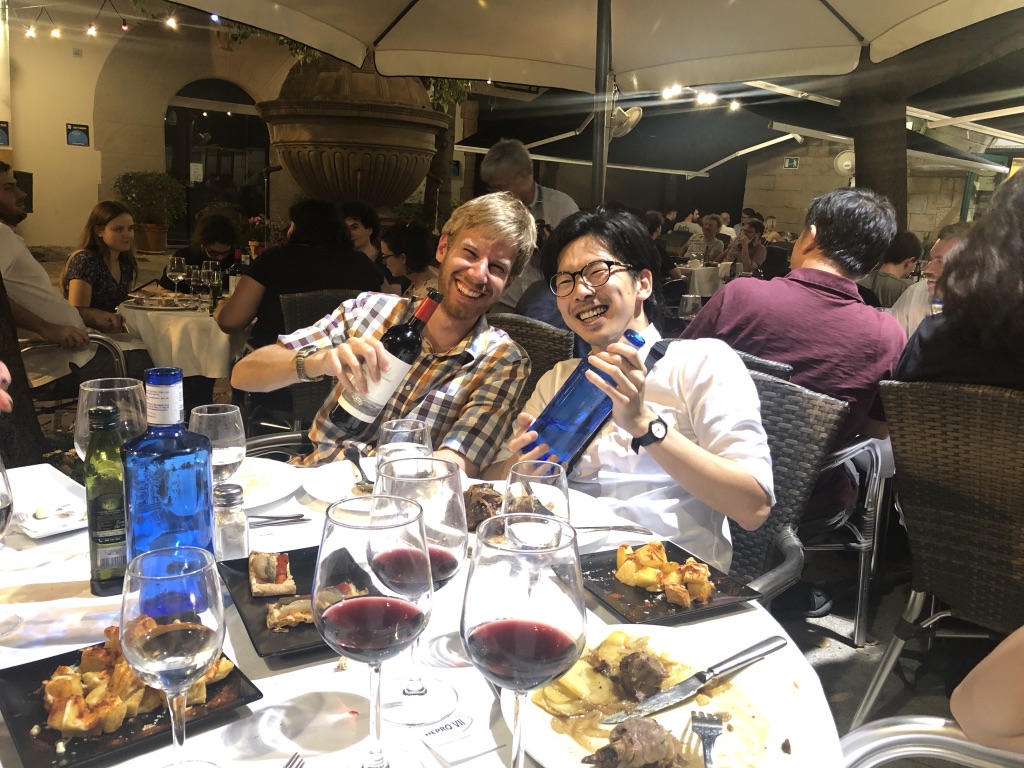
I went to Barcelona, Spain to attend the international conference "High Energy Phenomena in Relativistic Outflows 7 (HEPRO7)" in July 2019. Almost one hundred researchers attended the conference, so this was a good opportunity that I could advertise our works. I gave a poster presentation on a theoretical model of an active galactic nucleus jet which is one of the astrophysical relativistic outflows. I could spend time with fruitful discussion with many participants not only at the poster session but also at the coffee break, everyday lunch and dinner time. This experience made my first stay in Europe a very good memory.

Takeshi Tomitsuka (D1, Department of Physics, Graduate School of Science, Tohoku University)
27 May - 1 June 2019, Tainan, Taiwan
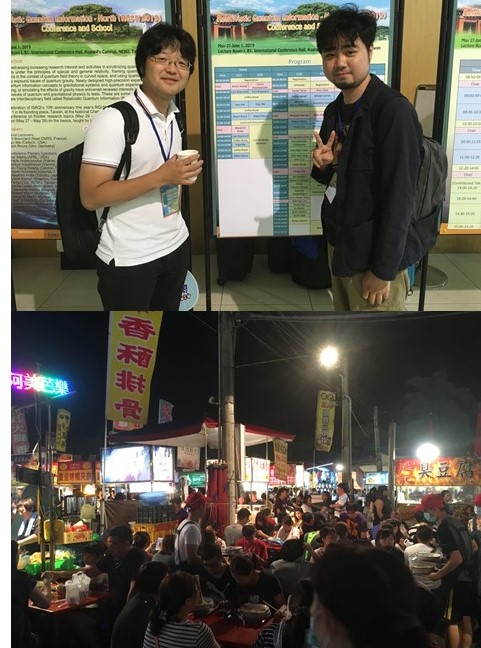
I joined RQI-N (Relativistic Quantum Information) 2019 conference and school at National Cheng Kung University in Tainan for 27/5 ~ 1/6. I reported my recent research "Purification Partner formula in Moving Mirror model" including my master thesis and some participants gave useful comments and discussions. In addition, it is official that new project is going to begin and I’m going to Waterloo University in Canada in this autumn. I went to the night market with participants and enjoyed the Tainan’s culture. This is my first overseas travel and I think it is useful for the future work that I got acquainted with a lot of researchers.
5月27日から6月1日まで台南市の国立成功大学で開かれたRQI-N (Relativistic Quantum Information) 2019 のスクールおよび会議に出席しました。そこで自身の修論を含む「動的鏡模型における純粋化パートナーの公式」 の研究発表をしました。会議に参加されている方々から自身の研究に対し様々な意見を頂きながら議論を交わし、 加えて次の共同研究の計画も新たに立ち上がり、今秋カナダのWaterloo大学に行くことも決まりました。 また参加者の方々と台南の夜市に行き、現地の活気溢れる風土にも触れることができました。 自身にとっては今回が初の海外渡航であり、多くの研究者と出会い知り合えたことは今後研究活動を進めていく中でも大いに役立つことと思います。

Yuichi Toyama (D2, Department of Physics, Graduate School of Science, Tohoku University)
31 Januray - 11 February 2019, Thomas Jefferson National Accellerator Facility (JLab), Newport News, VA, US
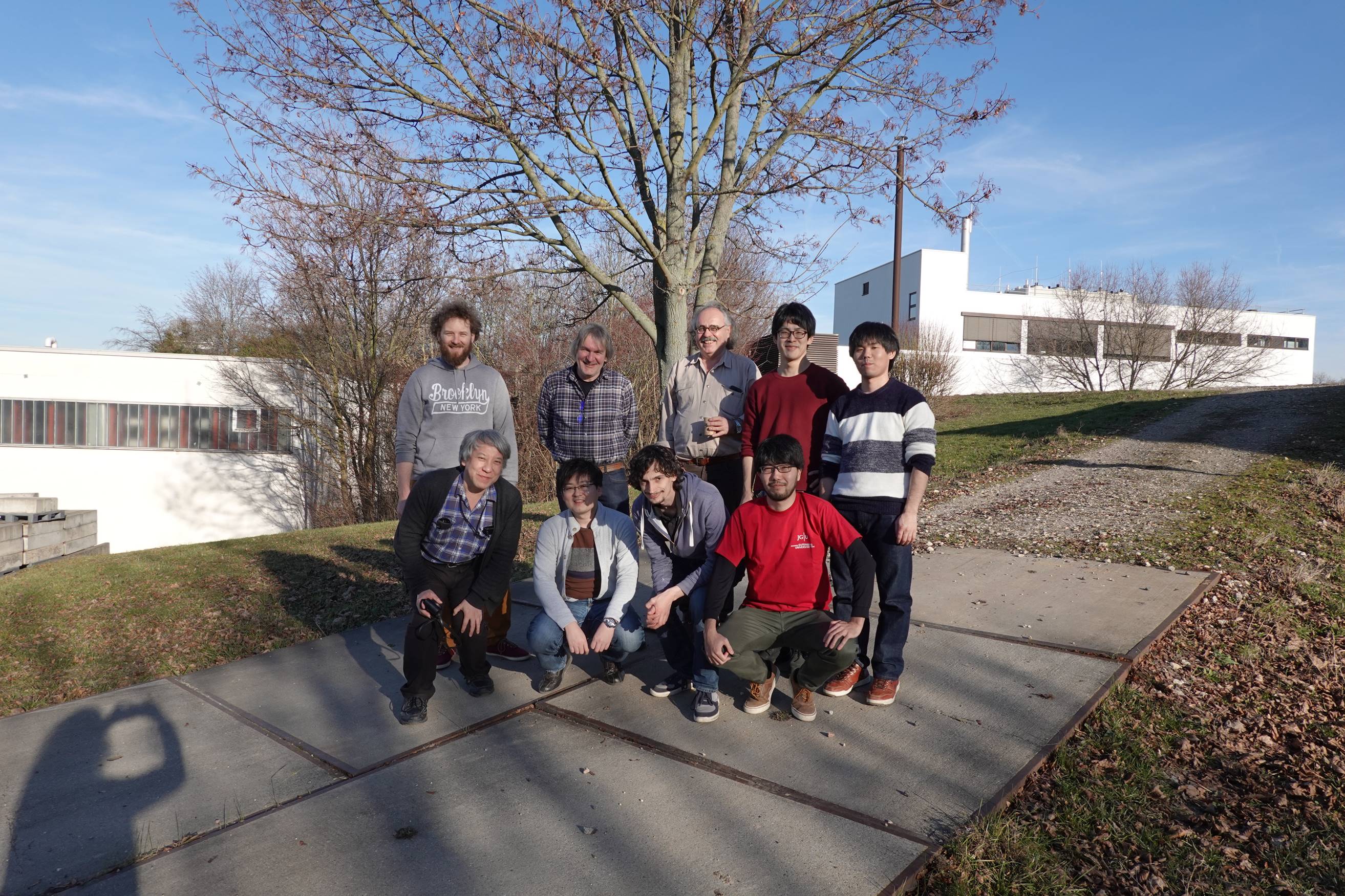
I joined an experiment of dark photon search at Thomas Jefferson Laboratory in the U.S. I performed the experiment with friends at JLab. I also enjoyed comfortable weather in Virginia by playing soccer with friends. After staying JLab, I went to Mainz to join an experiment of electron beam calibration with undulators. This project aiming to reduce systematic error of hypernuclear decay pion spectroscopy has been carried out by Tohoku-Mainz international collaboration since 2016. I visited Braubach castle located along Rhein river and a morning market in Mainz in holidays. I spend great time with friends in Germany and the U.S.
私は米国・ジェファーソン研究所で行われた、ダークフォトン探索実験に参加してきました。 昨年度の実験で知り合った友人たちと共に実験を遂行し、昼休みには一緒にサッカーをするなど、 バージニアの温暖な気候を楽しむことができました。 米国での実験の後には、続けてドイツ・マインツ大学で行われたアンジュレータを用いた電子ビームの較正実験に参加しました。 このプロジェクトは2016年から東北大学とマインツ大学が共同で行っており、今後のハイパー核実験の系統誤差の改善を目指しています。 休日には友人の勧めでブラウバッハ城を訪れたり、朝市に出かけるなど充実した滞在となりました。

Shu-Yu Ho (D2, Department of Physics, Graduate School of Science, Tohoku University)
6-27 Januray 2019, Galileo Galilei Institute (GGI) for Theoretical Physics, Firenze, Italy
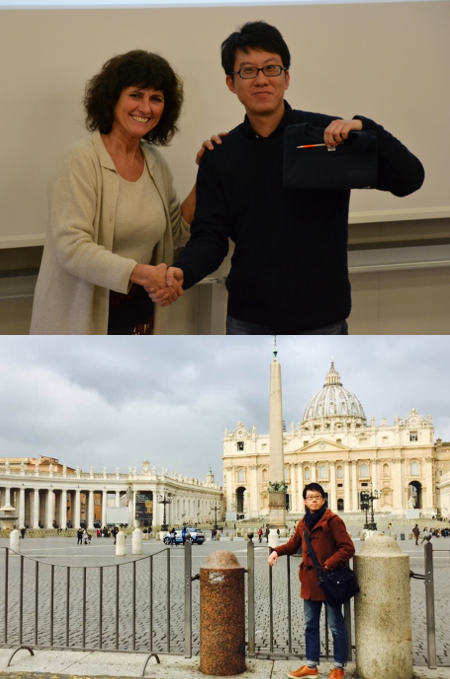
After the workshop in Taiwan, I immediately went to Italy to attend the school held by GGI. This school includes many topics in high energy physics such as axions, effective theories, flavor physics and so on. In particular, they also gave a lecture about machine learning which has been applied in high physics in recent years. During the school, they asked students to give a presentation about our own research optionally, and I am one of the volunteers to give a seminar talk. It is worth to mention that I got a GGI symbolic prize due to my contribution.
In the weekends, I went to other cities in Italy like Pisa, Roma, and Milan. In Pisa, I saw the Pisa tower. In Roma, I visited the Vatican museum and Colosseum. And in Milan, I watched the famous paint “The last supper” by Michelangelo. I also visited cathedrals in these cities such as St. Peter's Basilica and Milan cathedral. Besides the sightseeing, I also enjoyed the food in Italy like Pizza, pasta and ice cream. I had a wonderful time when I stayed in Italy. I would like to thank GP-PU program for providing me this nice chance for visiting Italy.

>
Shunki Ishikawa (D1, Department of Physics, Graduate School of Science, Tohoku University)
July-November 2018, GSI Helmholtzzentrum für Schwerionenforschung GmbH, Germany
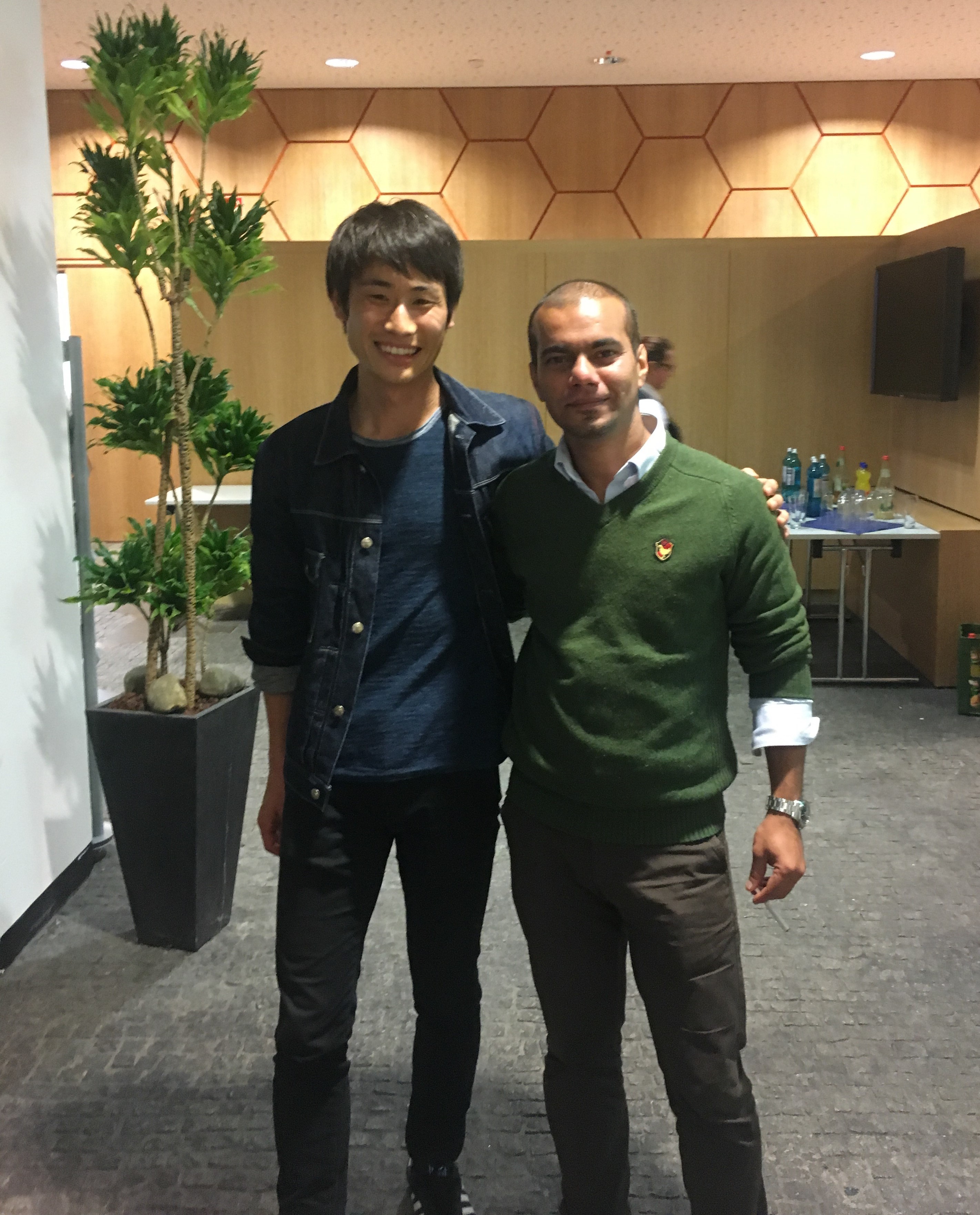
In 2018 July, I visited GSI institute in Darmstadt for 5 months to join the experimental preparation for "the accurate slowing-down measurement of heavy ions in gases and solids" which is one of the upcoming projects of FRS group. Time flew in such a way as I could not, or forgot to hold my breath, but such an intense project gave me a lot of experience and lecture. Working in the interactive environment was one of the best ways to learn something. Researchers in GSI and Giessen university were always friendly and helpful, and that’s why I could progress my tasks such as the simulation of ion-optics, detector development and so on. Germany is a great country to have a researcher life, I found. Beers, wines and sausages were encouraging my daily life. Danke Schön!
7月から5ヶ月間に渡って、ドイツのGSIヘルムホルツ重イオン研究センターに滞在しました。 目的はFRSグループによる「重イオンの物質中におけるエネルギー損失の精密測定」に関する実験準備に参加することでした。 GSIやGiessen大学の方々のご指導を賜り、イオン光学系のシミュレーションや標的の準備などを通して、 多くの知識・技術を学ばせていただきました。 ドイツでの生活は非常にリラックスして過ごすことができました。人々はおおよそ優しく、 困ったことがあれば手を差し伸べてくれます。夏はビール、秋は森へ散歩、 冬になるとクリスマスマーケットで町中が賑やかになる様子は、非常に印象に残っています。

Shu-Yu Ho (D2, Department of Physics, Graduate School of Science, Tohoku University)
25 September - 8 October 2018, National Taiwan University (NTU), Taipei, Taiwan
National Taiwan Normal University (NTNU), Taipei, Taiwan;
National Tsing Hua University (NTHU), Hsinchu, Taiwan;
25 Dec 2018 – 3 Jan, 2019
National Center for Theoretical Sciences (NCTS), Hsinchu, Taiwan
& Fo Guang Shan, Kaohsiung, Taiwan
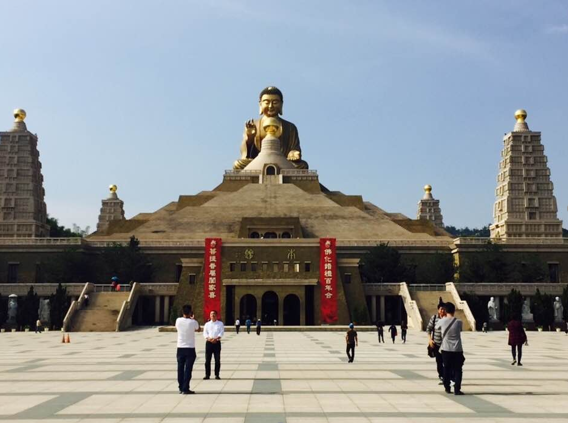
Taiwan is my lovely hometown, I always want to contribute to my alma maters by giving academic presentations. In the last September, I made a schedule for going back to Taiwan after the visiting of institutes in Germany. First, I participated the workshop “Cosmology Frontier in Particle Physics : Astroparticle Physics and Early Universe” in NTU, where I presented my work on "Level crossing between the QCD axion and axion-like particle". I also gave similar talks in the other institutes such as NTNU and NTHU. On the other hand, At the end of last year, I was invited to give a student talk at the workshop "The 5th International Workshop on Dark Matter, Dark Energy and Matter-antimatter Asymmetry" hosted by NCTS, where I presented my work on cosmological moduli problem. Interestingly, this workshop was held at Buddhism place (Fo Guang Shan). Namely, they only provide vegetarian meals and non-alcoholic beverage. Therefore, it is a good chance to refresh my body by attending this wonderful workshop. I also meet new Taiwanese friend there, who is a master student at Tokyo University. Recently, I was invited by his group to give a seminar talk in this June. I think there will be a nice interaction between our groups. Finally, I would like to thank GP-PU program for giving me this opportunity to visit my country.

Masashi Nashimoto (D2, Institute of Astronomy, Graduate School of Science, Tohoku University)
3-10 March 2019, The University of Arizona, US
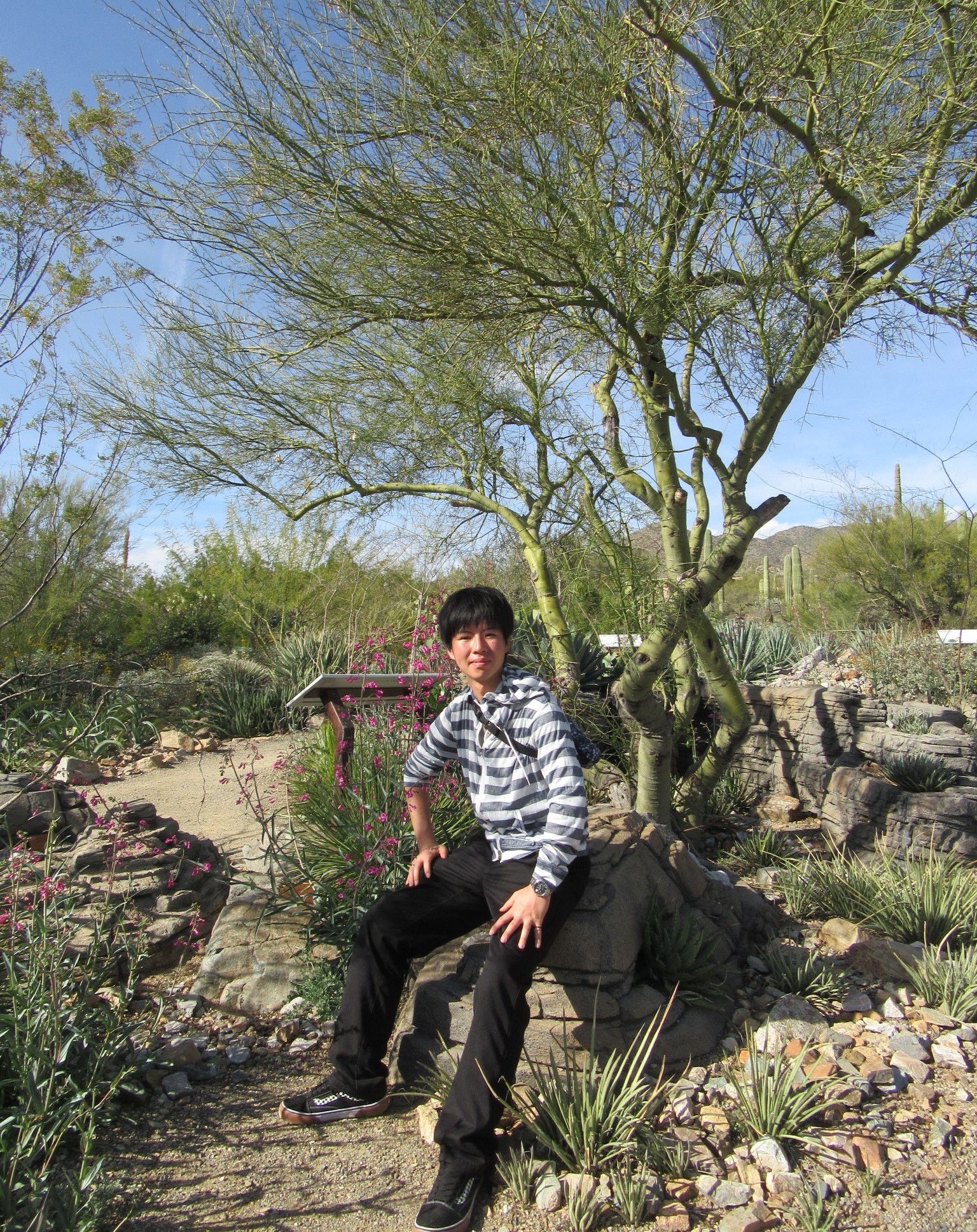
Tucson is the town of Arizona in southern United States of America. In there, a wide wasteland of the cactus reminding a Western film spreads out and Tucson is also famous as an astronomy observation place. I took part in an international conference about the cosmic dust which was held at the university of Arizona and made a poster presentation. I discussed open questions and future observation plans with researchers who were active in the front lines in the world and was able to spend exciting time.
アメリカ合衆国南部のアリゾナ州の街、ツーソン。そこは西部劇を彷彿と させるようなサボテンの荒野が広がっている。天文観測地としても有名な この地で開催された宇宙塵に関する国際会議に参加し、ポスター講演を行った。 会期中は、宇宙塵に関する未解決問題や今後の観測計画についての議論を 世界の第一線で活躍する研究者たちとともに議論し、とても刺激的な時間を 過ごせた。

Masashi Nashimoto (D2, Institute of Astronomy, Graduate School of Science, Tohoku University)
4 September - 18 December 2018, Instituto de Astrofísica de Canarias, Spain
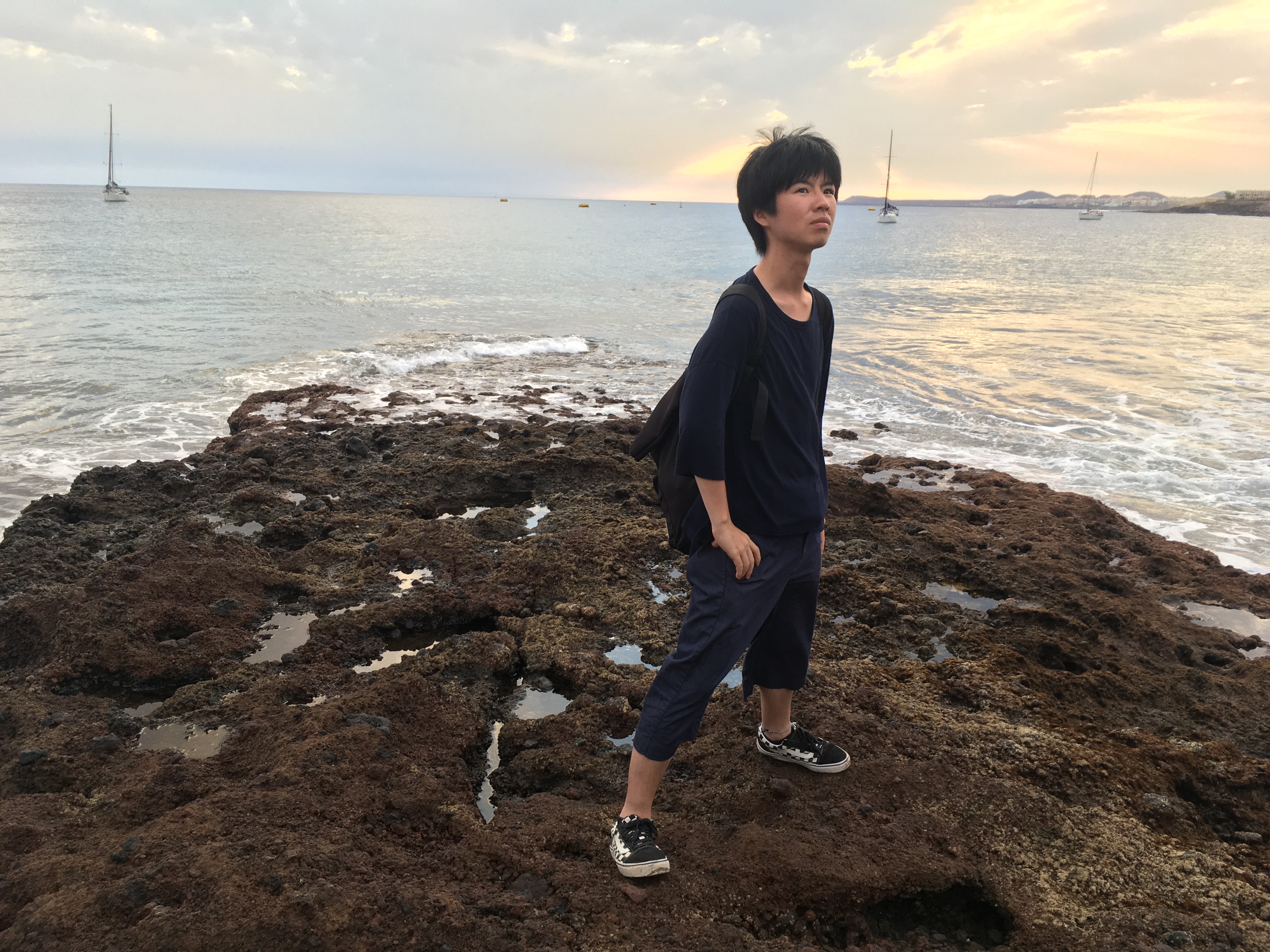
Tenerife island is the largest island among Canary islands floating in the Atlantic and is referred as the island of eternal spring. It is known that Tenerife island is one of the best locations in the world for making astronomical observations. I had studied an unsolved radio emission called anomalous microwave emission (AME) at the Instituto de Astrofisica de Canarias. It was the first time that I collaborated with international researchers and I think I could make a progress as a researcher through this experience. Of course, I enjoyed Tenerifan nature, culture and foods, too!
アフリカ近くの大西洋に浮かぶカナリア諸島のうち最大の島である、 常春のテネリフェ島。テネリフェ島は世界的にも有数の天文観測スポット として知られている。現地の研究機関であるカナリア天体物理研究所(IAC) でAMEと呼ばれる起源未解明の電波放射についての研究を進めた。 国際共同研究を行うのは初めてであり、今回の経験を通して研究者として 成長することができたように思う。 今回の滞在ではテネリフェ島の自然・文化・食事など、研究以外の面でも 満喫することができた。

Takayuki Ueno (M2, Department of Physics, Graduate School of Science, Tohoku University)
4-28 October 2018, SLAC National Accelerator Laboratory
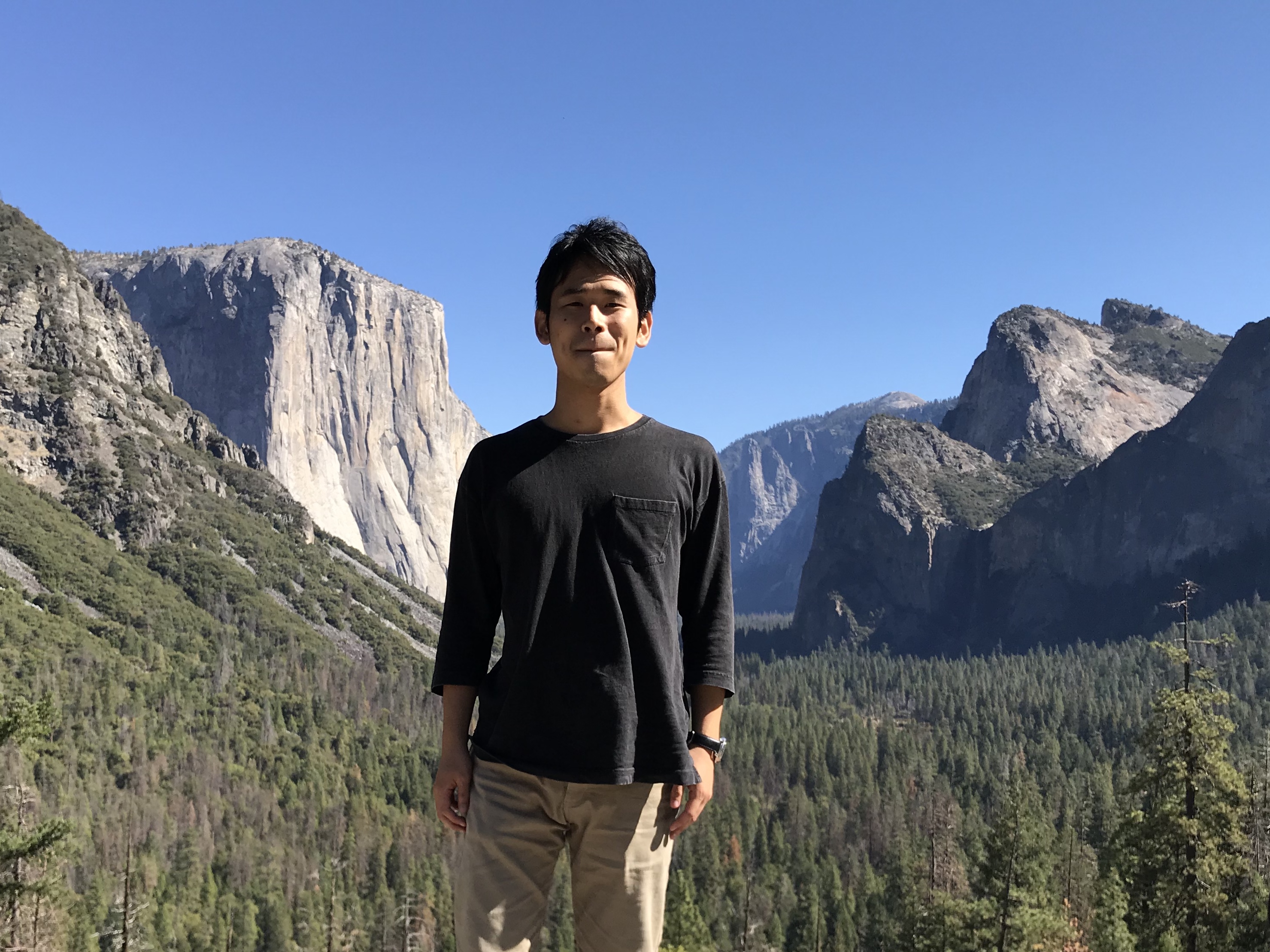
I have done a collaborating study on the measurement of left-right asymmetry at ILC with Dr. Tim Barklow at SLAC National Accelerator Laboratory. The purpose of this trip was to visit him, to finalize my analysis, and to present the result at the LCWS (linear collider workshop). The month I spent in the U.S. was short but it was the most meaningful month in my life. A lot of discussion with Dr. Tim Barklow and other researchers made a huge progress of my study. In addition to work, I had a chance to visit Yosemite National Park. Even though I’ve heard that everything in U.S. is big, the scenery was surpassed my expectation. The great valley made me feel a sense of the power or glaciers and ancient history.
この度は、かねてよりILC(International Linear Collider)におけるビーム偏極非対称性ALR の研究を共に行っていたTim Barklow博士の所属するSLAC国立研究所を訪問いたしました。 今回の目的は本研究をゴールへと導き、その成果をテキサスで開かれるLCWS(linear collider workshop) にて発表することでした。一ヶ月という時間はあっというもに過ぎてしまいましたが、 人生で一番濃い一ヶ月を過ごせたのではないかと思います。Tim Barklow博士や他の研究者との議論はとても有意義なもので、 私の研究を推し進める大きな原動力となりました。休日には、ヨセミテ国立公園を訪れる機会を持つこともできました。 想像をはるかに上回るスケールの渓谷を目の当たりにし、氷河の力強さそしてこれまで地球の刻んできた歴史の長さを感じずには入られませんでした。

Yuichi Toyama (D2, Department of Physics, Graduate School of Science, Tohoku University)
14 October - 12 November 2018, Thomas Jefferson National Accellerator Facility (JLab), Newport News, VA, US
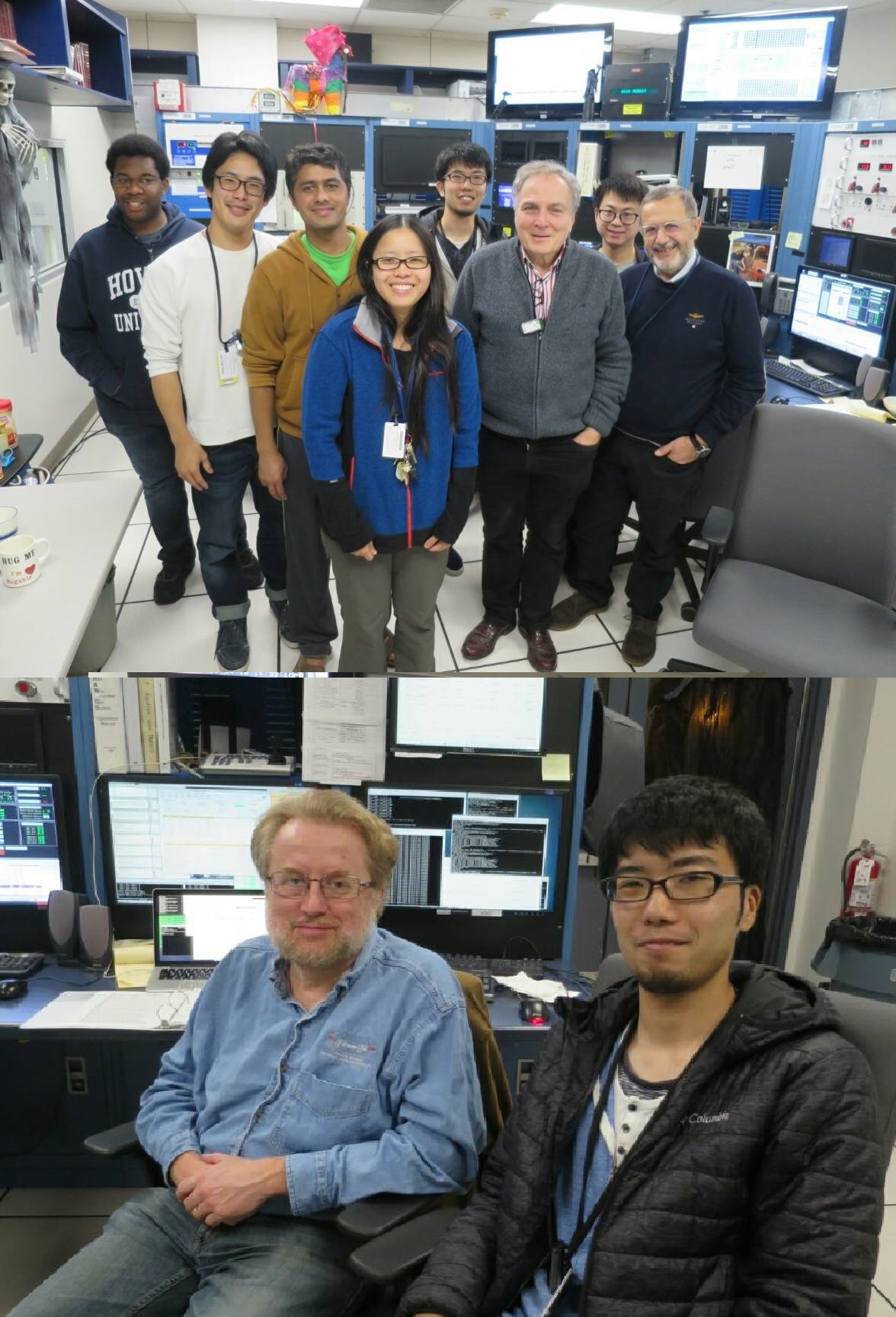
I joined an experiment of hypernuclei at Thomas Jefferson Laboratory in the U.S. The purpose of this experiment was searching exotic hypernuclei called “n n Lambda” (n is neutron, Lambda is Lambda hyperon). Such kind of experiment is very difficult because a Tritium target, high quality electron beam and two high resolution magnetic spectrometers are necessary. The unique opportunity was at Hall-A of Jefferson Lab in 2018 as they had a campaign of tritium target experiments.
I really enjoyed the unique opportunity and online analysis was so exciting. Fortunately, I could be a first person who observed K+ meson in this experiment. Although that is far from our final goal, that proved that our data taking was properly on going. And I learned a lot of things from Postdocs and students at JLab.
私は米国・ジェファーソン研究所で行われた、nnΛと呼ばれるエキゾチックハイパー核の探索実験に参加してきました。 このような実験を実施するには放射性物質であるトリチウムの標的、高品質な電子線、2台の高分解能磁気スペクトロメータが必要なため、 実験実現が非常に困難です。幸運にも2018年にジェファーソン研究所のHall-Aにおいてトリチウム標的を用いた実験のキャンペーンを 行っており、実験実現の唯一無二のチャンスが巡ってきました。
実験中のオンライン解析はとてもエキサイティングで、私はこの実験を存分に堪能することができました。
また幸運にも私はこの実験においてK+中間子を最初に観測することができました。この結果は実験の最終目的には及びませんが、 我々のデータ収集が正しく行われていることを証明するものであり、非常に重要な結果です。
そして、この実験を通してJLabの学生やポスドクから様々なことを学ぶことができました。

Natsuki TSUKAMOTO (D2, Department of Physics, Graduate School of Science, Tohoku University)
23-27 October 2018, Fifth Joint Meeting of the Nuclear Physics Divisions of the APS and the JPS
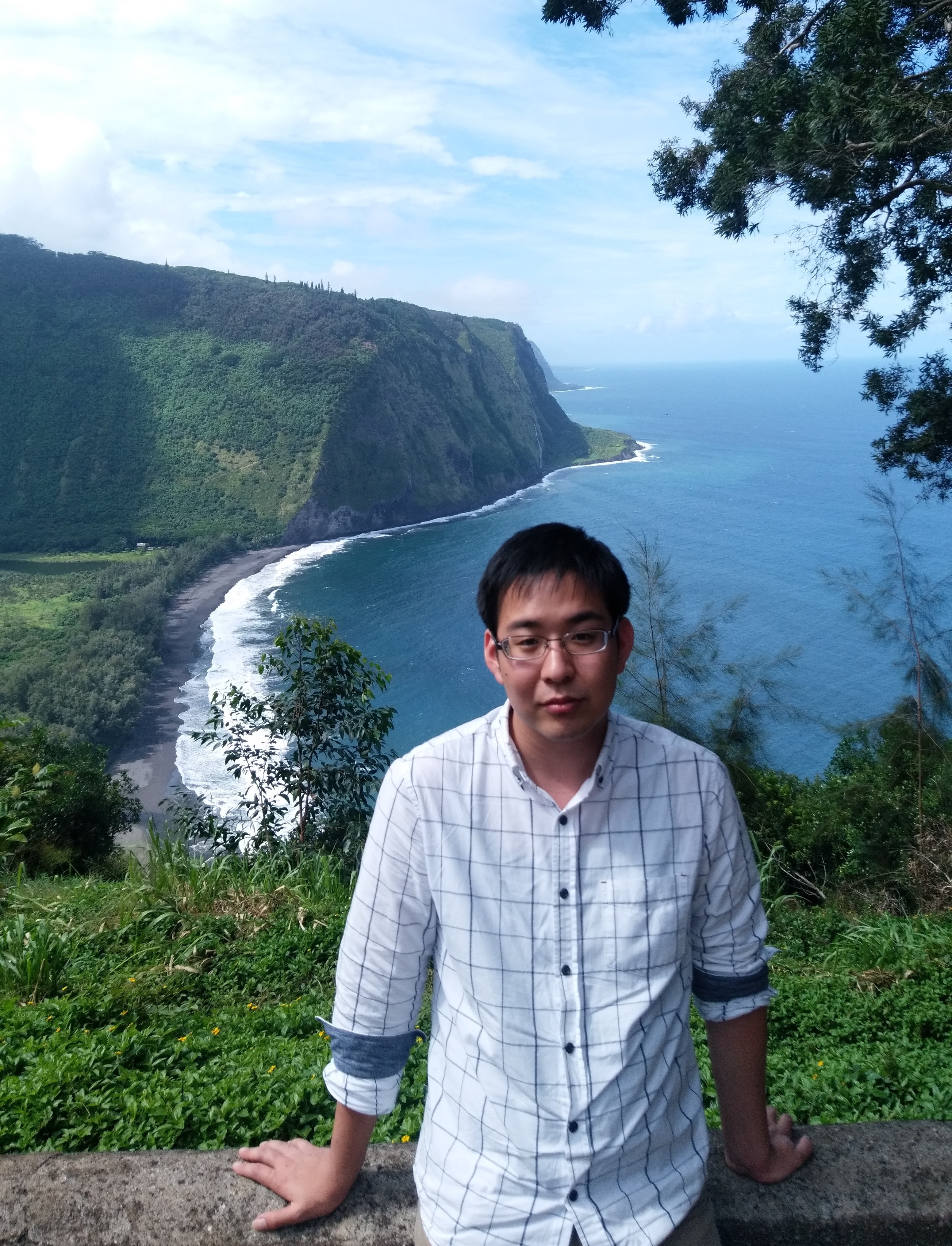
From Oct. 23rd to 27th, I had attended the Joint Meeting of the APS Division of Nuclear Physics and the Physical Society of Japan. This meeting was held in the Waikoloa Beach located in the Hawaii Island. There was a vast wasteland around the venue and it seemed that the ground was covered by cooled lava. Although it was completely different from what I had imagined, I was deeply impressed with the landscape which cannot be seen in Japan.
I spent my spare time swimming, sightseeing or eating like other tourists. This picture was taken in the Waipi'o Valley Lookout on the other side of the island, where a lot of plants grow unlike the Waikoloa Beach. However I went there on my departure day, mosquitoes bit me so much and I was feeling itchy during the whole flight.
10月23日から27日まで、日米物理学会合同大会核物理分科に参加しました。 このミーティングはハワイ島にあるワイコロアビーチで行われました。 会場のまわりには荒野が広がっていて、地面は冷えた溶岩で被われているらしいです。 想像していたものとはかけ離れていましたが、日本では見られないであろう光景に深く感銘を受けました。
他の旅行者のように空いた時間は泳ぐとか観光するとか食べるなどして過ごしました。 この写真はワイピオ渓谷の展望台で撮ったもので、ワイコロアとは違い草木の生い茂る島の反対側にあります。 そこへ行ったのは最終日でしたが、蚊にしこたま刺され、飛行機の中でずっとかゆい思いをしました。

Naoto HASEGAWA (M2, Department of Physics, Graduate School of Science, Tohoku University)
14-27 September 2018, Institut de Physique Nucléaire Orsay, France
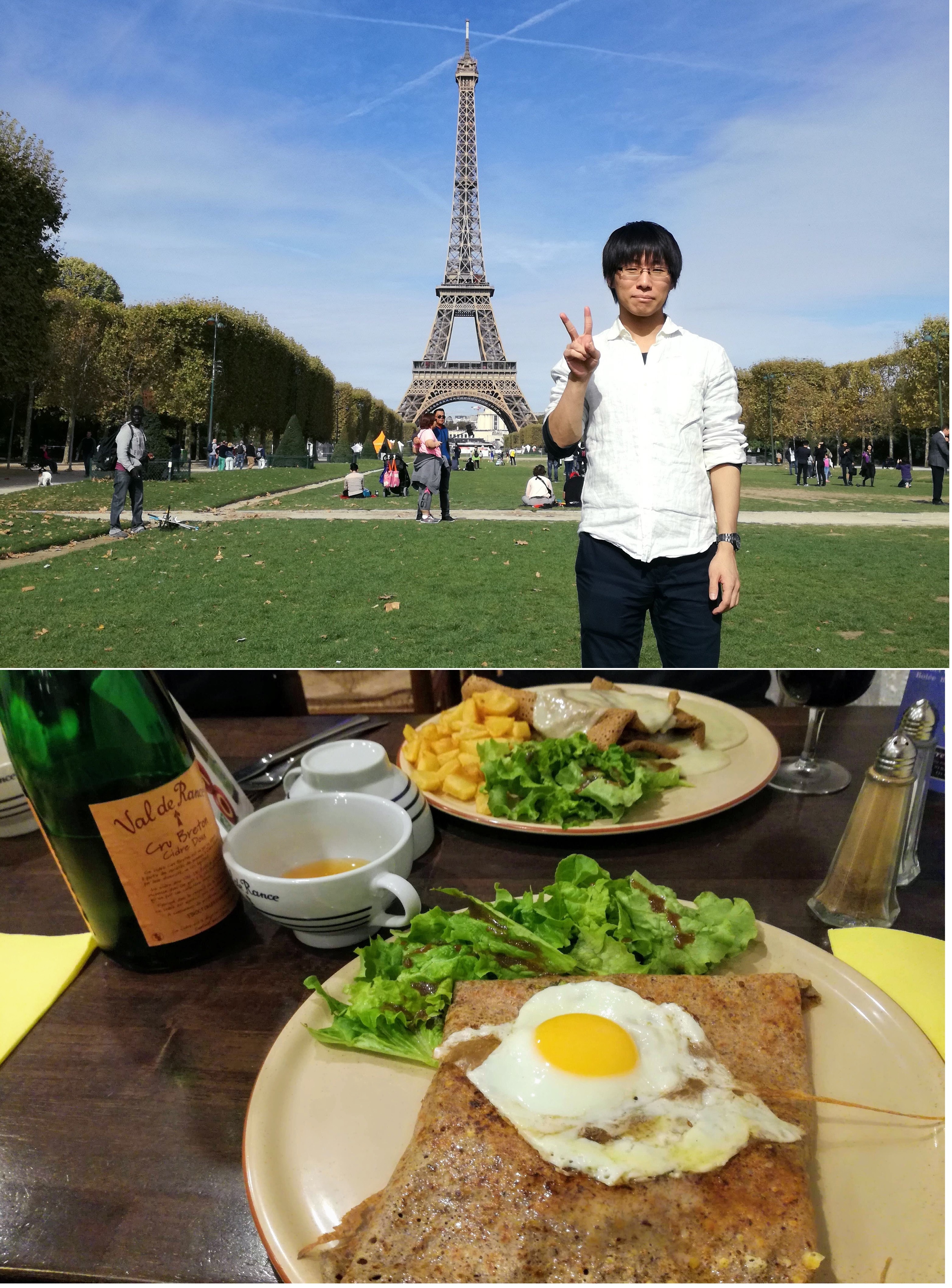
I have been in France for about two weeks to visit Institut de Physique Nucléaire Orsay. I discussed with local researchers in the daytime, and I enjoyed French meals and sightseeing in my free time. Among what I ate in France, galette, a crêpe made from buckwheat flour, stands out in my mind. When we hear "crêpe" in Japan, a thin pancake filled with creme or something sweet may come to our mind. Actually, galette wraps minced meat or sausage and comes with salty sauce (not sweet). Galette was absolutely delicious. I visited crêpe restaurants three times during my short stay. When you have a chance to visit France, I recommend eating galette at least once.
Orsay原子核研究所への出張で、2週間程フランスに滞在しました。平日は主に 自分の研究について現地の研究者の方々と議論をし、平日の夜や休日にフラン スでの食事や観光を楽しみました。フランスの食事では特にそば粉を使ったク レープ(ガレットと呼ぶらしい)が印象的でした。日本でクレープというと、生 クリームなどが入ったデザートというイメージです。しかしフランスで食べた ガレットは挽肉やソーセージなどが入り、味付けもチーズやペッパーのソース などの甘くない味付けでした。このガレットはとても美味しく、フランス滞在 中に3度もお店に行きました。皆さんもフランスに行く機会があれば、ガレッ トを食べるのをおすすめします。

Masaaki TOKIEDA (D1, Department of Physics, Graduate School of Science, Tohoku University)
14-27 September 2018, Institut de Physique Nucléaire Orsay, France
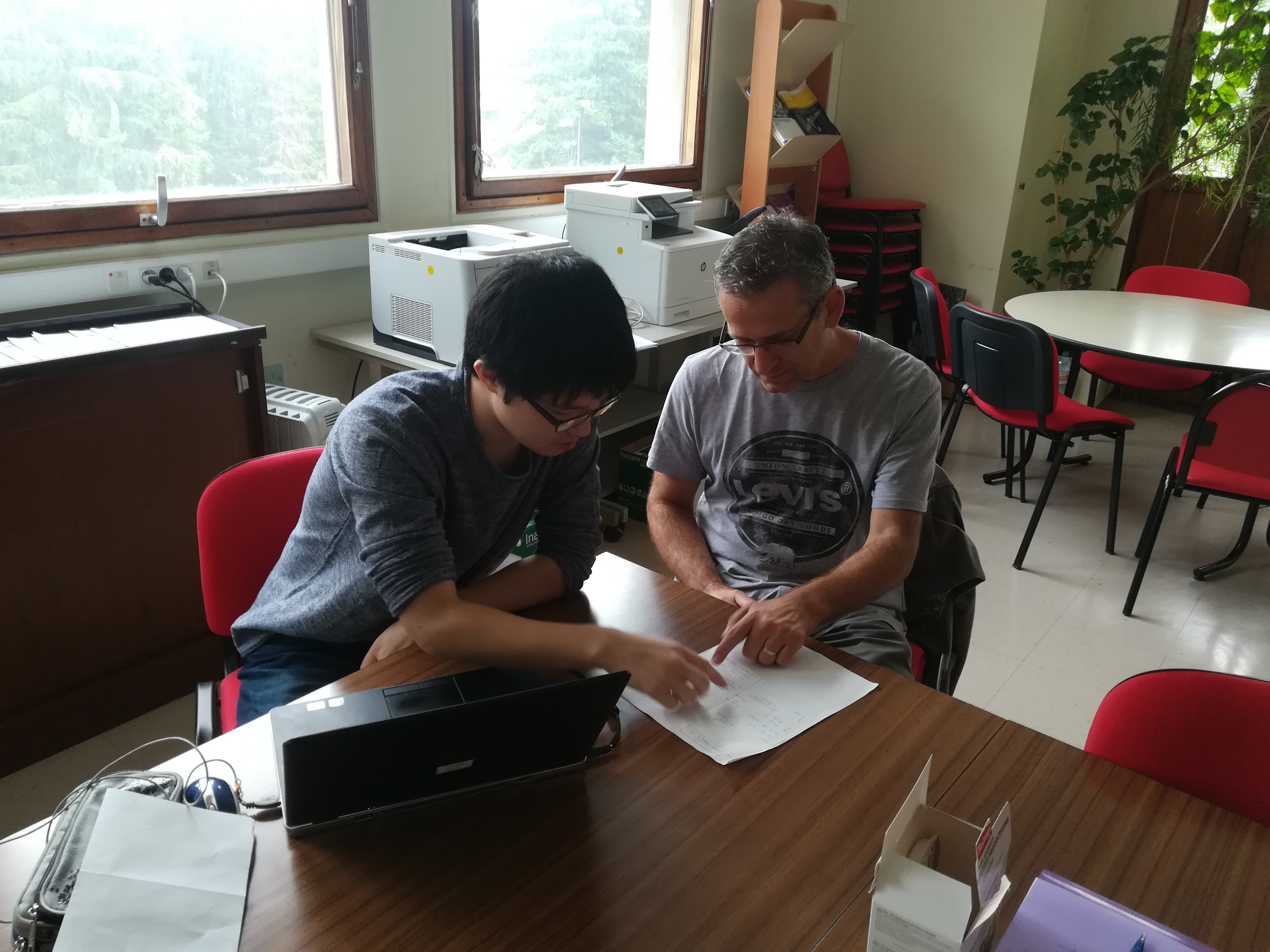
This time, I visited Dr. Denis Lacroix at IPNO (Institut de Physique Nucléaire Orsay) in France, to conduct a discussion on some possible future collaboration work. The topic was an approximate method for open quantum systems. Dr. Guillaume Hupin, who has worked on a similar problem during his Ph.D with Dr. Lacroix, also joined our discussion.
Dr. Lacroix had suggested that we start the project already before the visit. Thanks to his advice, I could do some preparation in advance and I believe we had fruitful discussions. They took time for me almost everyday in spite of being busy. I really appreciate their hospitality. Although it was a short-term trip, I got a lot of homework from this visit. In return for their kindness, I will do my best to show them new results.
On the other hand, I visited France for the first time in my life. France is such a popular place that is always on the top 10 of the most visited countries. I am sincerely grateful to the GPPU program for giving me the opportunity to visit such country. I was able to see a lot of famous tourist attractions thanks to Dr. Tanimura's help. If I could have a chance to visit France again, I would go to some secret spots outside Paris.
この度、フランスにあるIPNO(Institut de Physique Nucléaire Orsay)所属のDenis Lacroix博士を訪問しました。 渡航の目的は、開放系の記述によく用いられるハミルトニアンに対する近似解の求め方について議論するためです。 Lacroix博士の学生であったGuillaume Hupin博士もまた同様の問題を過去取り扱っていたため、議論に参加していただきました。
Lacroix博士より、渡航に先立って議論を始めましょうとの提案を頂き、ある程度の準備をもって渡航を迎える事が出来ました。 それもあって、私個人としては実りのある議論ができたと感じています。学期はじめの多忙な時期にも拘わらず、ほとんど毎日議論のために時間を作ってくださり、本当に感謝しています。 短期間の渡航となりましたが、宿題をたくさんいただきましたので、恩返しの気持ちも込めて、新しい結果をお見せできるよう全力を尽くしたいと思います。
他方、観光地として非常に有名かつ人気なフランスへと今回初めて訪問する事ができました。 このような機会を与えてくださったGPPUプログラムには感謝の気持ちでいっぱいです。 同行していただいた谷村さんのおかげで、多くの有名な観光地を目にする事ができました。 もしまた今度訪問する機会を頂けたなら、パリ郊外の穴場にも足を運んでみたいです。

Yuichi TOYAMA (D2, Department of Physics, Graduate School of Science, Tohoku University)
23 June – 14 July, 2018, Thomas Jefferson National Accellerator Facility (JLab), Newport News, VA, US
Jefferson研究所の滞在期間はサッカーワールドカップの開催期間と重なっており、 研究所内のいたるところで熱いサッカー談義に花が咲いていました。私もベルギー人と ベネズエラ人の研究者とともにベスト8をかけた日本代表とベルギー代表の試合を宿舎で観戦しました。 写真はその試合の後にとったものです。ご存知の通り試合結果は我々日本人にとって大変受け入れがたい ものでしたが、日本ではなかなか味わうことのできない国際研究所ならではの貴重な経験を得ることができました。
My stay of Jefferson Laboratory coincided with the term of FIFA World Cup 2018 and many people were discussing about football throughout the laboratory. I watched a game of the Japan national team and the Belgium national team that won the best 8 with scientists from Belgium and Venezuela in our dormitory. This photo was taken after the game. As you know, the result of the game was really difficult for Japanese to accept, but I had a valuable experience unique to such an international laboratory.

Kosuke Itabashi (M2, Department of Physics, Graduate School of Science, Tohoku University)
17 June - 15 July 2018, Thomas Jefferson National Accellerator Facility (JLab), Newport News, VA, US
私はアメリカ・バージニア州・ポーツマスで開催された HYP2018 でポスター発表をしました。 HYP は原子核・ハイパー核分野の国際会議であり、私は Jeffeson Lab で行 われる次世代実験の標的システムデザインについて、ポスターを通して国内外の研究者と 様々な議論を行い、研究の知見をより深めることができました。 また、レセプションパーティーでは、ハンプトン大学の生徒やイタリア・ドイツの研究グ ループと研究内容だけではなく、様々な話をして親交を深めることができた。写真はレセプシ ョンパーティで撮った写真です。海岸沿いの眺めがいい場所でお酒を飲みながら楽しく過 ごすことができました。
I participated in a HYP2018 international conference in Portsmouth, Virginia state, USA, and gave a poster presentation on a target system design. Through discussions in English, I could understand my study more deeply. In the reception party, I was able to deepen friendship through drinking with students of Hampton University and many scientists from Germany, Italy, and so on.
This picture was taken in reception party near the coast when I drunk with friends. I enjoyed very much. Through this conference, I had good experience.

Masashi Nashimoto (D2, Institute of Astronomy, Graduate School of Science, Tohoku University)
9-17 June 2018, University of Copenhagen, Denmark
Tycho Brahe was a Danish astronomer whose accurate astronomical observations provided the basis for Kepler's laws about planetary motion. Copenhagen has sentimental and traditional atmosphere which lets me feel the time he lived. While thinking about the great discovery more than 400 years ago, I took part in the international conference about cosmic dust at the University of Copenhagen, where he had graduated, and made a poster presentation about the frequency dependence of the intensity and polarization emission from amorphous dusts. It was very exciting for me to discuss a lot with both senior professors and young and energetic researchers. It was my first participation in international conference held abroad. During the trip, I had a fruitful life and research activities.
惑星運動に関するケプラーの法則を生む基礎となる精密な天体観測を行ったデンマー ク出身のティコ・ブラーエ。コペンハーゲンの町並みは彼が生きた時代の情緒を今な お感じさせる風情あるものであった。四百年以上前の偉大なる発見に思いを馳せなが ら、彼の出身大学でもあるコペンハーゲン大学にて開催された宇宙ダストの国際会議 に参加し、アモルファスダストの放射強度・偏光放射の周波数依存性に関する講演を 行った。大御所の先生から新進気鋭の若手研究者まで、最前線で活躍する研究者たち に混ざって議論を交わしたこの一週間は私にとって大変刺激的な経験だった。海外で 開催される国際学会への初めての参加であったが、研究・生活ともに非常に充実した 一週間を過ごすことができた。

Shu-Yu HO (D2, Department of Physics, Graduate School of Science, Tohoku University)
28 May – 4 July, 2018, Technical University of Munich (TUM), Munich, Germany
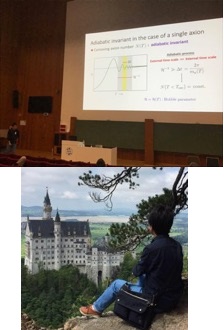
In this summer, I visited Prof. Alejandro Ibarra's group at TUM, who is an expert on dark matter and neutrino physics. During my stay, I gave a seminar talk about my research work on "axion" in his group and had fruitful discussions with his students. Besides physics, we also talked about the culture, food, and sightseeing of Germany in each coffee break. Later on, I attended the workshop "Axion Wimps 2018" at Hamburg and gave a plenary presentation in front of hundreds of people. I was very nervous at that time but it was a really nice experience for me. After the workshop, I visited department of physics at Max Planck Institute to give a seminar talk also. Before leaving Germany, I made a travel plan for myself. For example, I went to Berlin to see the "Berlin Wall" and enjoyed sausage, Eisbein and beer there. I also visited the famous castle "Neuschwanstein" nearby Munich. I really had a good time in Germany. Therefore, I would like to thank GP-PU program for giving me this opportunity of visiting Germany

Taiki OGIHARA (M2, Institute of Astronomy, Graduate School of Science, Tohoku University)
1-10 March 2018, ACADEMIA SINICA Institute of Astronomy and Astrophysics (ASIAA), Taiwan
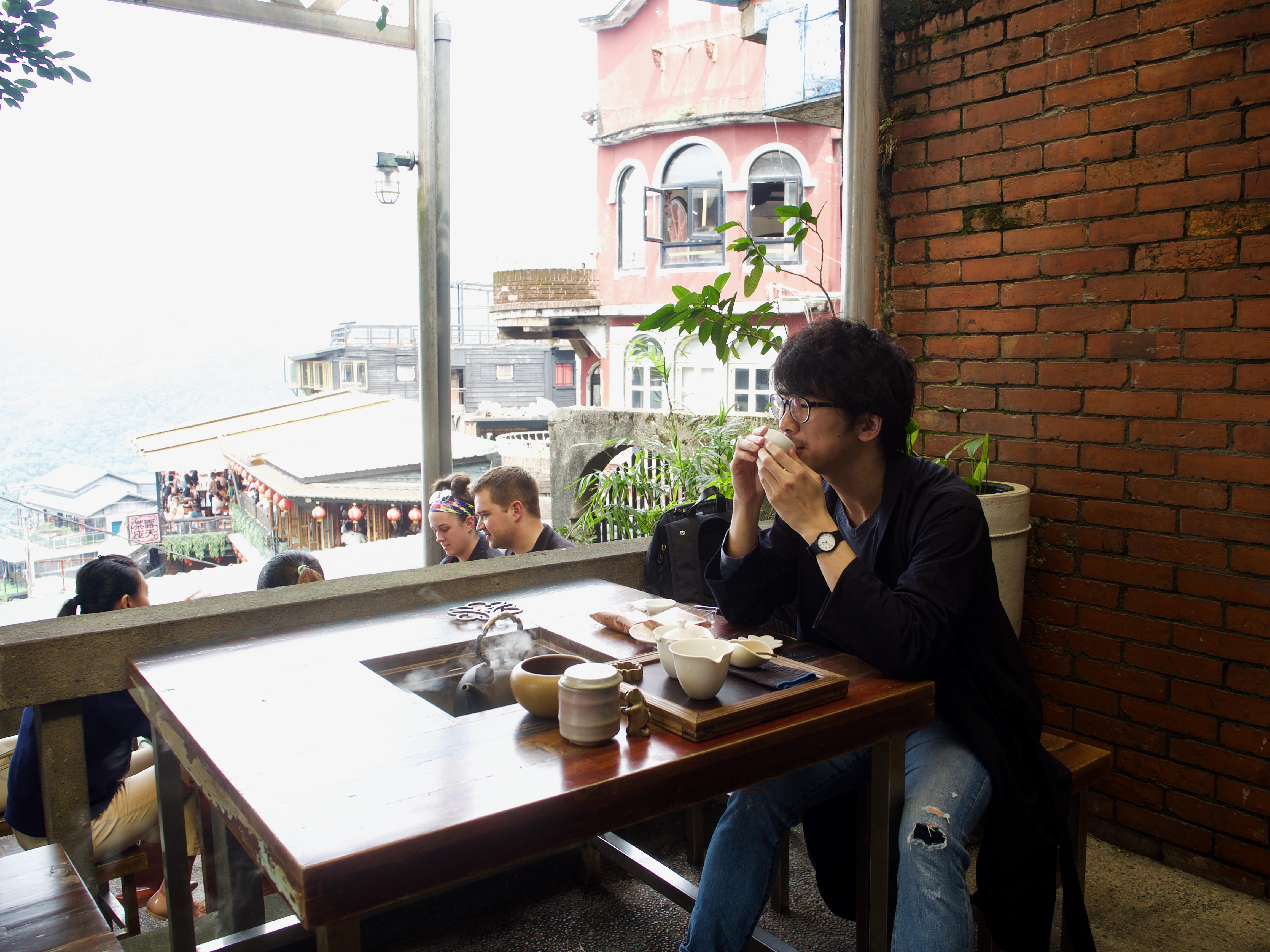
I stayed ACADEMIA SINICA Institute of Astronomy and Astrophysics (ASIAA) in Taiwan for ten days to learn how to use a simulation code “HARM” and to develop a joint research with Dr. Nakamura. We mainly discussed about active galactic nucleus jets. I am pleased that we found that the model I constructed would play an important role to determine free parameters in the simulation. Dr. Nakamura organized a seminar in which I gave a talk, and I could enjoy a discussion with astronomers in ASIAA. The discussion let me have ideas that would inspire my next study. Having lunch and dinner with people from different countries was also exciting to me as well as discussions on research. This visit was good experience for my study and life. I am very grateful for GPPU’s supports.
3月1日から10日間、共同研究のため台湾ACADEMIA SINICA Institute of Astronomy and Astrophysics (ASIAA)を訪れました。ASIAAには私の研究対象である活動銀河核ジェットの研究者が多く在籍しています。今回の滞在は中村雅徳氏にシミュレーションコード”HARM”の使い方を教えていだき、それを用いた共同研究を進展させることが目的でした。本格的なシミュレーションコードを扱うのは初めてでしたが、私がこれまで行ってきたジェット形成理論に関する研究の応用する方法について具体的に議論することができました。滞在中には1時間ほどのセミナートークの機会をいただきました。様々な分野の方から多くの質問をいただき、有益な議論をすることができました。中村氏には研究所の方々との交流のためにとランチやディナーを何度もセッティングしていただいて、台湾の美味しい料理とともに楽しい時間を過ごすことができました。 海外初心者の私でしたが、公私共に貴重な経験をさせていただきました。この経験を糧により一層研究に励んでいきたいと思います。

Yuichi TOYAMA (D1, Department of Physics, Graduate School of Science, Tohoku University)
1-27 February, 2018, Johannes Gutenberg-Universität Mainz, Germany
私はドイツ・マインツ大学に約1か月間滞在し、アンジュレータを利用した電子ビームのエネルギー絶対値較正実験に参加しました。我々の研究グループは2011年よりマインツ大学と共同でハイパー核研究プロジェクトを推進してきました。その中で、ハイパー核崩壊パイ中間子分光という新しいΛハイパー核の質量分光手法を確立し、4重水素Λハイパー核の質量を世界最高精度で決定することに成功しました。
さらなる高精度実験を行うため、アンジュレータを用いたビームエネルギーの絶対値較正手法の確立を目指しています。今回、我々はアンジュレータを用いたテスト実験を実施しました。その中で私は放射光を測定するカメラ及びアンジュレータ移動用モータの制御プログラムの構築を担当しました。あまり馴染みのない機器、ソフトウェアでしたが、現地の学生・研究者と協力して実験を成功裏に行うことができました。
また、偶然にも滞在中にドイツでも最も有名なカーニバルのひとつでもあるマインツのカーニバルを見物することができ、私自身2度目のマインツ訪問でしたが前回同様に充実した日々を送ることができました。
I stayed at Mainz University in Germany for about a month to work on the energy measurement of electron beams using undulators. The Tohoku-Mainz international collaboration started a project of hypernuclear spectroscopy in 2011. In the project, we established a new method of mass spectroscopy of Lambda hypernuclei, so called decay pion spectroscopy, and measured a mass of hydrogen 4 Lambda with the best accuracy in the world.
In order to achieve further improvement in accuracy, we are developing a technique for absolute energy calibration of electron beams by using undulators, and performed a test experiment at MAMI this time. I was responsible for a control program of a CMOS camera and a motor system of the undulators which are major components for a radiation light detection. Although I was not familiar with these equipment and software, the experiment was succeeded thanks to many helps of colleagues in Mainz University.
Coincidentally, there was a Carnival of Mainz which is the one of the most famous festival in Germany, and I enjoyed it with friends in Mainz. It was a second time for me to visit Mainz. I had a good time as well as last time.

Ryouki Matsukoba (M2, Institute of Astronomy, Graduate School of Science, Tohoku University)
14-28 January 2018, Vienna Observatory, Austria
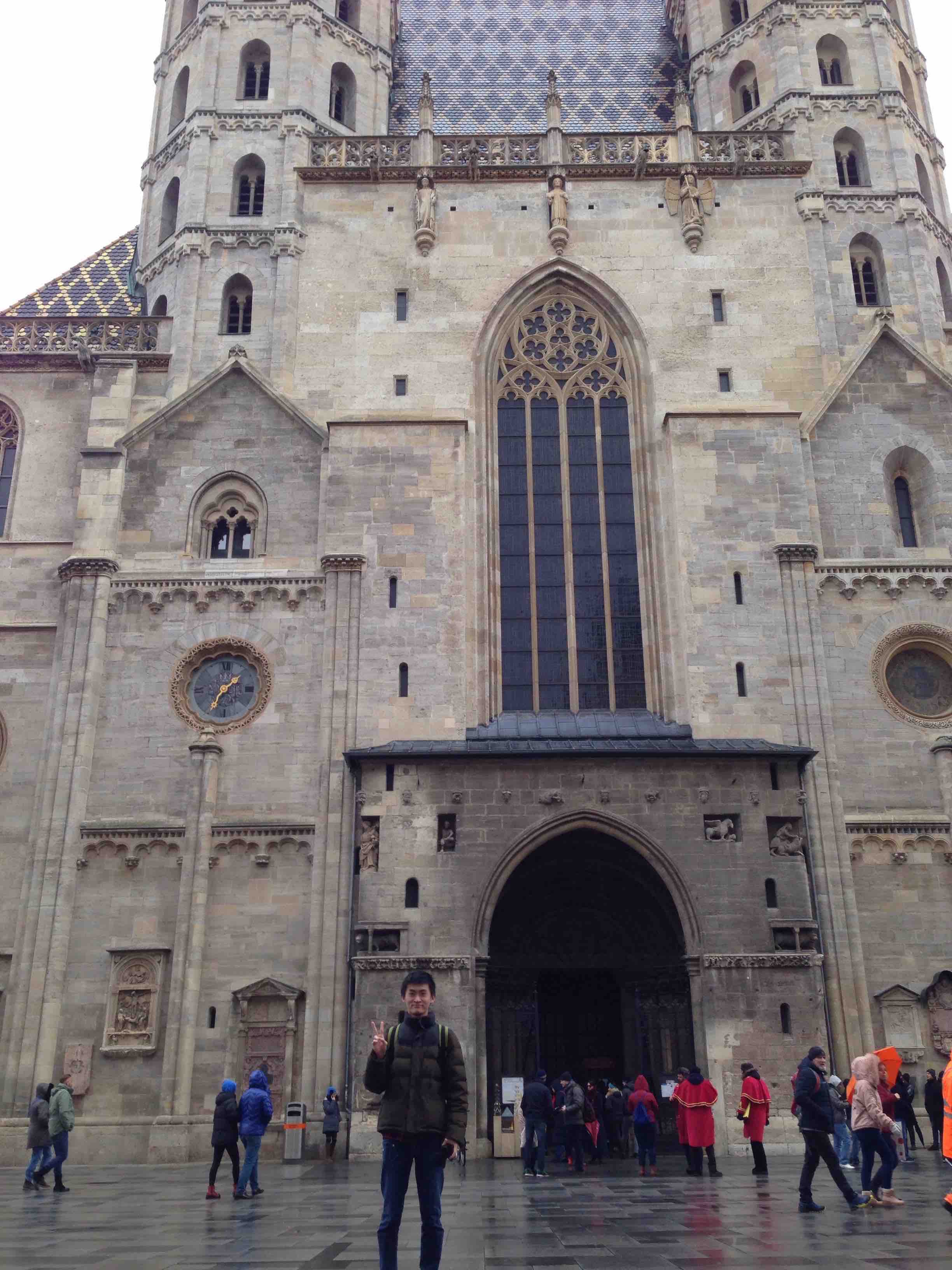
ほとんどの銀河の中心に超大質量ブラックホールが存在することが明らかになってい る。特に遠方宇宙に存在する超大質量ブラックホールの起源として超大質量星と呼ば れる星の形成が予言されている。私は修士研究において、超大質量星を形成する際に その周囲にできる円盤の分裂について調べた。その修士研究を発展させるために流体 シミュレーションを行う計画である。そこで、流体計算コードの開発者であるE. Vor obyov博士に会うためにウィーン天文台を訪問した。2週間の滞在中でVorobyov博士 に指導を仰ぎ、計算コードの使い方を習得することができた。また議論を通して今後 の研究に進め方に具体的な指針ができた。今回の海外研修は私にとって初めての海外 経験であったため、現地の研究者との交流で得る知識は新鮮かつ驚きに満ちており、 非常に良い経験となった。この研修が良い研究へと繋がるように、今後はより一層の 努力をしたいと考える次第である。
The observations reveal that there are supermassive black holes in the center of most galaxies. Some astrophysicists predict the formation of a supermassive star as the origin of supermassive black holes in the early universe. In my master thesis, I studied the fragmentation of the circum-supermassive-star disk. I plan to do hydrodynamical simulation for advancing my master thesis. Therefore, I visited the Vienna observatory to see Dr. E. Vorobyov who is developer of hydrodynamical simulation code. I was instructed how to use the code by him and leaned it. It was the first time for me to visit the foreign institute. So, to discuss with the local scientists was good experience. I would like to make further efforts in the future so that this experience will lead to good work.

Yuichi TOYAMA (D1, Department of Physics, Graduate School of Science, Tohoku University)
8 November - 8 December 2017, Thomas Jefferson National Accellerator Facility (JLab), Newport News, VA, US
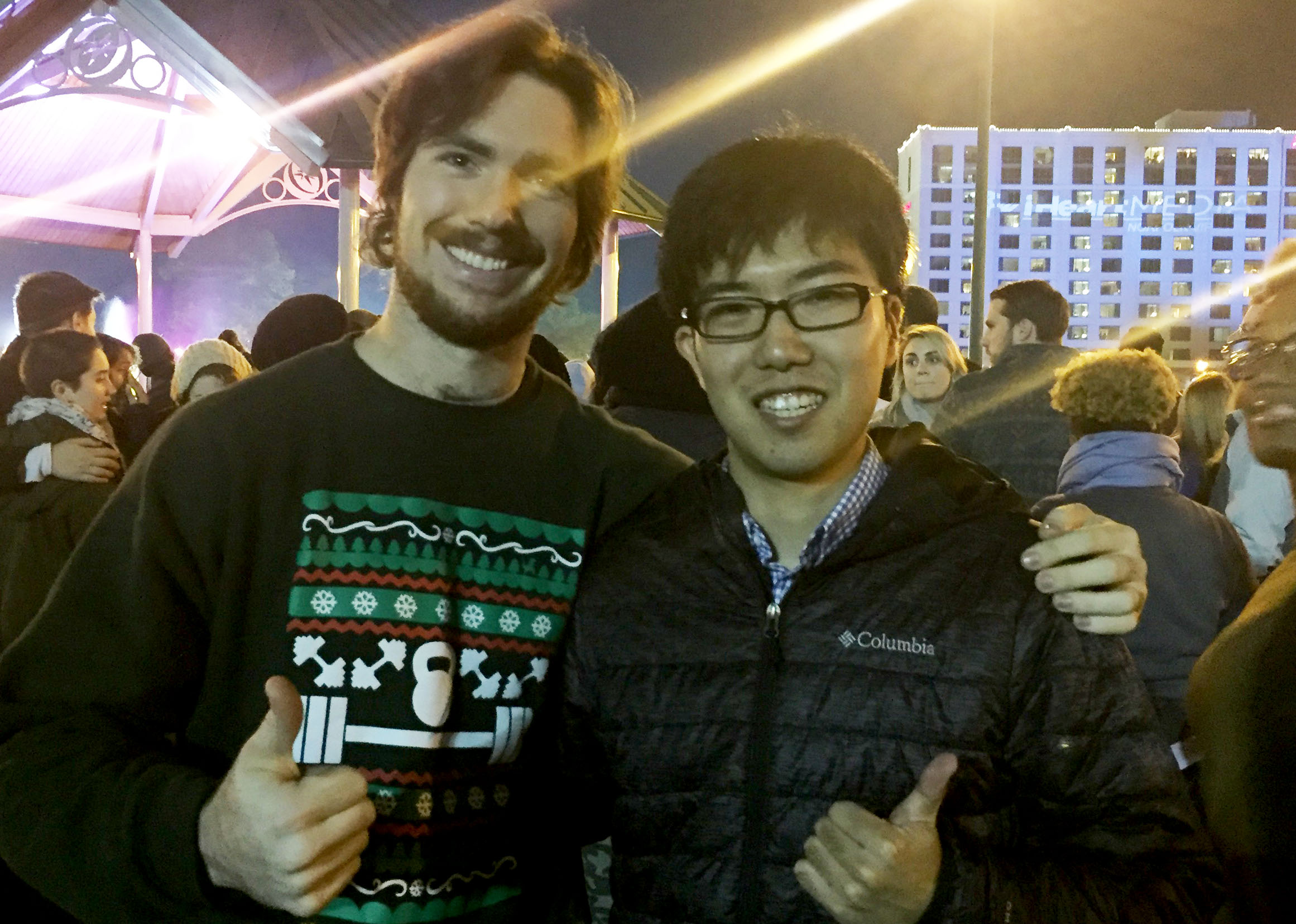
私は米国・トーマスジェファーソン研究所 (以下JLab) で実施する予定の Λ ハイパー核分光実験の準備のために約 1 か月間米国に滞在しました。JLabでは世界最高品質の大強度・高エネルギー電子ビームが利用できるため、世界各国から研究者が集まり、素粒子・原子核物理の研究が行われています。Λ ハイパー核分光実験も、そうした国際共同研究のひとつであり、2019年と2020年の実験実施を目指して様々な準備を我々東北大学が中心となって推進しています。
今回の滞在で私は主に次世代実験で使用予定のチェレンコフ検出器の動作確認及び新型波形読出しモジュールを用いたデータ解析コードの開発を行いました。またその他にも、JLab で同様に実施予定のダークフォトン探索実験のための検出器の調整などを、各国の共同研究者とともに行いました。休日には近所で行われたフェスティバルに友人とともに参加したり、JLab 近辺の観光をするなど充実した1ヵ月を過ごすことができました。
I stayed at the Thomas Jefferson Laboratory (JLab) in the U.S. for about a month to prepare for experiments of Lambda (Λ) hypernuclear spectroscopy. In JLab, the particle and nuclear physics are intensively studied by scientists from all over the world since the facility provides the highest quality of an electron beam. We are promoting the Λ hypernuclear experiments at JLab in an international collaboration team, and are now aiming to perform approved two experiments in 2019 and 2020.
During this stay, I checked performance of detectors which will be used in our next experiments and developed analysis code for flash ADC data. In addition, I checked performance of a detector which will be used in “dark-photon” search experiment which is also planned to be performed at JLab in near future. I also enjoyed a festival with my friends and sightseeing around JLab in some weekends. I had a very good time with overseas friends in JLab.

Yuichi TOYAMA (D1, Department of Physics, Graduate School of Science, Tohoku University)
21-28 October 2017, ECT* Trento, Italy
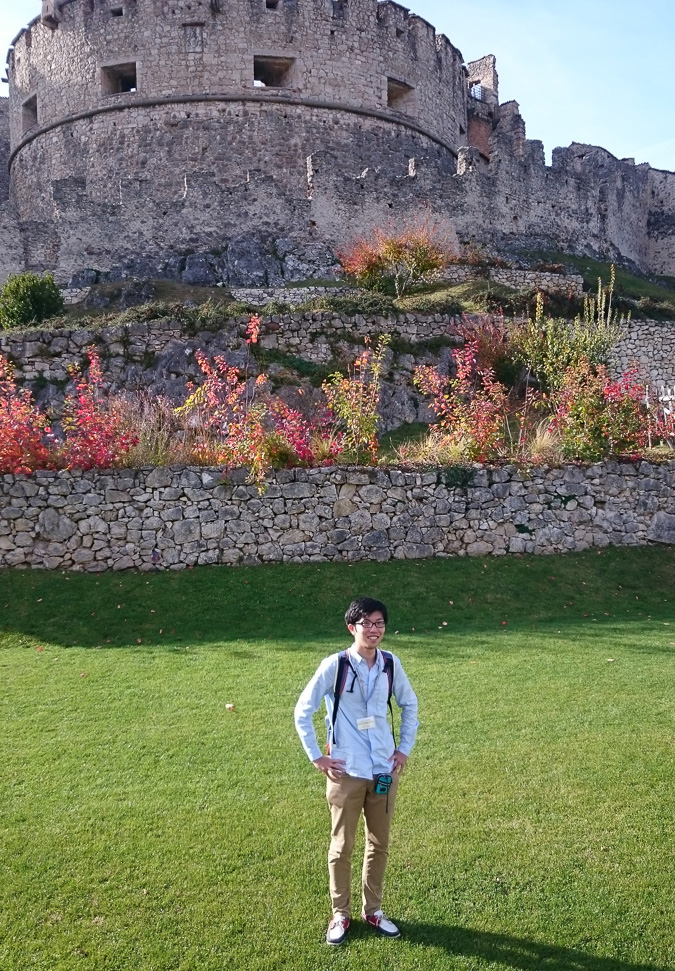
イタリア・トレントのECT*で開催されたストレンジネス核物理に関するワークショップASTAR2017に参加し、 Λハイパー三重水素の寿命測定計画について発表を行いました。私自身初めて英語で30分間の発表を経験し、国内外の理論家や実験家と様々な議論を深めることができました。
また休日にはトレント市街地から車で30分ほどの場所にある古城・ベゼーノ城を訪れ、雄大な自然と異文化に触れるよい経験をすることができました。 写真はその時にベゼーノ城を背景にとったものです。
I participated in ASTRA2017 which was a workshop for strangeness nuclear physics at Trento, Italy. I presented about experimental project of hypertriton-lifetime measurement. It was the first time for me to give a 30-min talk in English. I had a good opportunity to discuss with theorists and experimentalists from all over the world.
And I had a chance to visit Beseno castle which is about a 30-min drive from downtown of Trento. I enjoyed beautiful view and different culture there. The picture was taken with Beseno castle at that time.

Koji YAMAGUCHI (M2, Department of Physics, Graduate School of Science, Tohoku University)
1-31 October 2017, Waterloo, Canada
私はGPPUによる援助を受けて, カナダのUniversity of Waterlooにある, Physics of Information Labに一ヶ月滞在した. この研究室では, 情報理論, 量子論, 一般相対論および宇宙論に関係する幅広い話題について研究が行われている. 滞在期間中, ブラックホール蒸発の量子ビット模型に関する自身の最近の研究についてセミナーを行えたことは非常によい経験であった. また現地の教授や大学院生と議論をする中で新しい共同研究をスタートさせることが出来たため,これからそれが実を結ぶことを願っている.
私にとって他の研究室に長期間滞在するのは初めてのことであり, これは今後より良い研究者を目指す上で非常に有意義な経験であったと感じている. このような機会を与えてくれたGPPUと, 滞在を快く受け入れてくれたAchim Kempf教授に心から感謝したい.
Thanks to the support from GPPU, I visited the Physics of Information Lab at University of Waterloo in Canada for a month. At that lab, people are working on a wide range of topics such as information theory, quantum theory, general relativity and cosmology. During the stay, I had the opportunity to give two seminars on a recent work with Masahiro Hotta and Yasusada Nambu about a qubit model for black hole evaporation. The discussion with the people at Canada helped me to start a new collaborative research project, which hopefully will bear fruits in the near future.
This was my first time to stay at another laboratory for a long time. I believe this experience will help me to become a better researcher in the future. I am really grateful for the support of the GPPU. I would also like to express my thanks to Professor Achim Kempf for his hospitality.

Natsuki TSUKAMOTO (D1, Department of Physics, Graduate School of Science, Tohoku University)
4 Sepetmber - 9 October 2017, Heidelberg, Germany
ハイデルベルクはフランクフルトより列車で1時間の距離に位置し、一般に寒冷でしられるドイツの中にあって温暖な気候に恵まれます。 それでも私が尋ねた9月は少し肌寒かったです。ハイデルベルクは観光地としても有名で、旧市街地では素晴らしい光景が楽しめます。 私が訪問した研究室も可愛らしい建物の中にあり、哲学の道という有名な観光スポットに位置しています。
滞在中に私は現地での指導教官であるAlexander Rothkopf博士と新しい共同研究をはじめました。 それは格子QCDの既存の解析法の改善を目指したものです。短い間でしたが、 この経験が私にとってよいもので、この共同研究が我々に重要な示唆を与えてくれることを願っています。
Heidelberg is located within one hour train from Frankfurt and blessed with the warm climate despite Germany is generally known for its cold climate. However it was a little chilly when I had visited in September. Heidelberg is popular with tourists and we can enjoy an awesome view in the old city. Actually the laboratory I visited is in a beautiful building located in the Philosophenweg (Philosopher's Walk in German), a famous tourist attraction.
During this stay, I had started a new collaboration aiming to improve the analysis method on Lattice QCD with Dr. Alexander Rothkopf which is my supervisor in Universitaet Heidelberg. Although it was for a short while, I think that this experience is helpful and have expected that this collaboration will give us a fruitful suggestion.

Masaaki TOKIEDA (M2, Department of Physics, Graduate School of Science, Tohoku University)
3-21 July 2017, Trento, Italy
I participated in the Nuclear TALENT School 2017 at ECT*, Trento, Italy.
The main objective of this course is to understand the results of various nuclear structure experiment based on nuclear shell-model analysis.
During the course, we collaborated with other participants to make our own shell-model code. We also looked into some of the nuclear structure problems with the existing shell-model code.
By taking part in this course, I learnt what we have to calculate, and how we can
do it with the shell-model calculation to compare with the results of the experiment.
And I obtained the new shell-model code since we succeeded in making our own code during the course.
Incidentally, I have learnt the basic usage of a new programming language to make one code collaboratively. I would have not gotten this opportunity if I had worked by myself.
On a personal note, I had a lot of experiences for the first time, such as an overseas trip, collaborative work, and having a discussion in English.
While I was having a great time with those new challenges, this trip helped me realize what I need to do to improve myself.
I think that it is important to have those experiences before entering Ph.D. I am really grateful to the GPPU program for their support to do that.
今回、私はイタリア、トレントにあるECT*で開催されたNuclear TALENT School 2017に参加した。
本スクールの主な目的は、様々な原子核構造に関連した実験結果を原子核殻模型に基づき理解する事であった。
実務として、他の参加者との共同作業により自らの殻模型計算コードを作成したり、また核構造の様々な問題に対し既存の殻模型計算コードを用いた解析を行った。
本スクールに参加し、殻模型計算と実験結果を比較するために何をどのように計算すれば良いかという点に関する知見を得た。
また、本スクールの期間中に自らの殻模型計算コードを作成する事に成功し、新たにそのコードと関連する計算コードを得た。その過程で、共同で一つの計算コードを作るため、新しいプログラミング言語の基本的な用法を学んだ。グループワークをしていなければ、こうした機会を得ることもなかったであろう。
個人的な事柄として今回私は、海外渡航、共同研究、英語での議論といった多くの初めての経験をした。
今回の渡航では、そうした新しい事への挑戦を非常に楽しみながらも、自分に足りない多くの事に気づく事が出来た。
博士後期課程に進学する前にこうした経験が出来た事は非常に重要であると思っており、それを支援してくださったGPPUプログラムには心から感謝している。

Yo SATO (M2, Department of Physics, Graduate School of Science, Tohoku University)
22 May - 11 June 2017, Laboratoire de l'Accélérateur Linéaire, France
ILC (International Linear Collider) 計画は高エネルギーで電子と陽電子を衝突させ、 宇宙初期の状況を再現し宇宙創成の謎を探る次世代の加速器実験計画です。 LAL (Laboratoire de l'Accélérateur Linéaire) はILC計画の中心的役割を果たす 研究所の一つであり、私はLALの研究者と共同でトップクォーク電弱結合の研究を行っています。 今回の研修は、研究の推進と国際会議での発表の打ち合わせが目的でした。英語で研究に関する議論したり、 日本とは全く異なる文化に身を置きそれを体感したりと、自身の成長につながる有意義な経験ができました。
研修の最後にはCERN (欧州原子核研究機構) で開催された国際会議に参加し、 これまでの研究成果について発表してきました。参加者から貴重な意見を頂き、 またほかの発表から自身の研究にも役立つ情報を得ることができました。会議の最終日には、 参加していた同年代の学生と夕食を共にしながら互いの状況や目標について語らい、大いに刺激を受けました。
今後の研究遂行はもちろん、国際舞台で活躍する研究者として働くという目標に向けて、非常に有意義な機会となりました。
The ILC (International Linear Collider) is the next-generation electron-positron collider, which will explore the physics of primordial universe. I study the top-quark electroweak couplings to be measured at ILC with researchers of LAL (Laboratoire de l'Accélérateur Linéaire) which is one of the institutes playing the central role for ILC.
The goal of this trip was to promote our collaboration and prepare for my presentation at an international workshop at CERN that I attended during this trip. I had many discussions in English with my colleagues and got to know foreign culture during this stay. These useful experiences made me grow up.
At the end of the trip, I attended the workshop at CERN and gave a presentation. I got helpful comments from the other participants and learned things that are useful for my studies from the other talks. I had impressive discussions with foreign students about their situations and ambitions while having dinner.
This trip was very meaningful to make progress in my study and to become an international researcher.

Masashi NASHIMOTO (D1, Tohoku University Astronomical Institute)
23-26 May 2017, Instituto de Astrofísica de Canarias, Spain
There are the Canary Islands on the Atlantic which
are near to the coast in northwestern African Continent. I went to Instituto de Astrofisica de Canarias (IAC) on the island of Tenerife, which is one of the islands of the Canary Islands. The purposes
of this trip were to inspect the Teide observatory located on Tenerife for GroundBIRD and to discuss for collaboration study with QUIJOTE team members.
GroundBIRD, which is a telescope to observe Cosmic Microwave Background polarization
signals from the ground, will be constructed in Teide observatory. There is QUIJOTE in the same place, too. I looked around the site. I talked about my study I’ve been doing with IAC members. I got some advices from a new viewpoint, and
was able to make a clue for future collaboration work. This first opportunity to go to abroad for research was very meaningful for me.
アフリカ大陸北西部の沿岸に近い大西洋上に
スペイン領カナリア諸島がある。カナリア諸島を構 成する島の一つであるテネリフェ島にある、カナリア天体物理研究所(IAC)へ研修に伺った。今 回の研修の目的は、私の所属する研究室が参加する宇宙マイクロ波背景放射Bモード偏光地上観測 実験GroundBIRDの観測サイトである同島にあるテイデ天文台の視察と、同観測サイトにて行わ れるQUIJOTEとの共同研究の可能性を議論することである。
標高2390mにあるテイデ天文台は 雨が非常に少なく乾燥しており、天体観測に適した場所である。この場所にGroundBIRDを設置
するにあたってドームなどの視察と、共同研究を行う予定であるQUIJOTEの見学を行った。また 今回の訪問では私の今までの研究内容についてIACのグループの方とセミナーを行った。新たな視 点からの提言をいただき、今後の共同研究に向けて足がかりを作ることができた。 初めての海外での研究活動であった今回の研修は、非常に有意義なものであった。

Visitors
Essays by the visiters to Tohoku University for collaborations.
Victor LOHEZIC (M1, Magistère of Fundamental Physics, Paris-Sud University)
6 May - 26 July 2019, Tohoku University
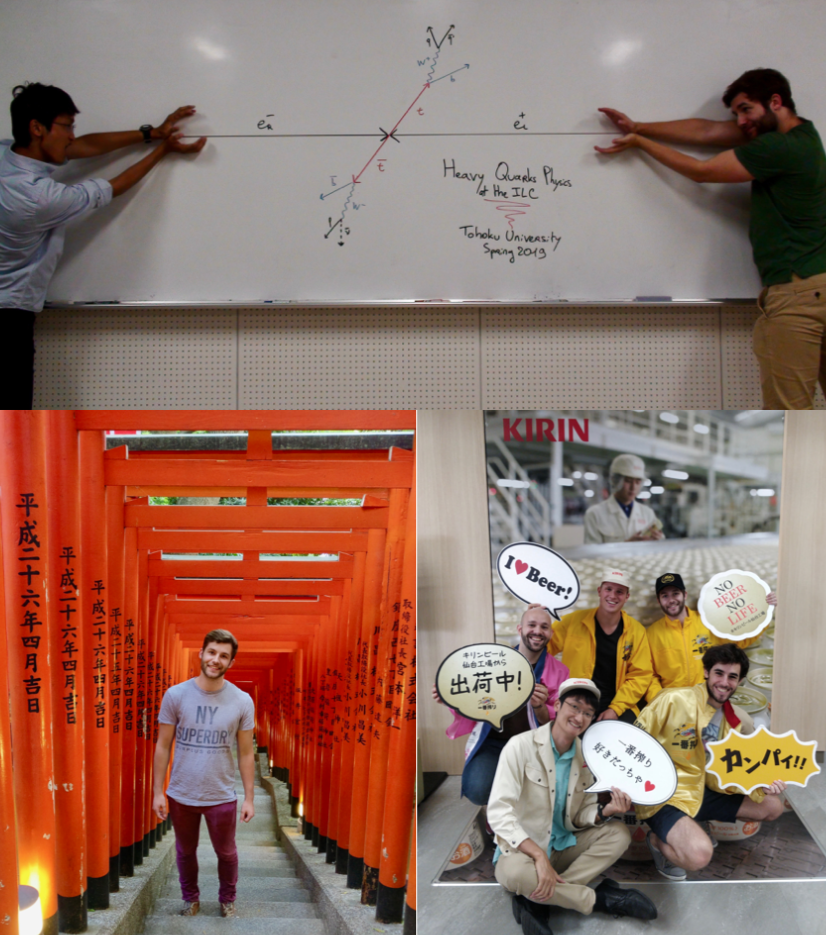
As a M1 student, I had the great opportunity to join the High Energy Accelerator Experiments Group at Tohoku University for a 3 months long internship. Professor Hitoshi Yamamoto was my supervisor and thanks to him, I could work on the semi-leptonic decay of the e+e- → tt reaction in the ILC (International Linear Collider) framework. This is one of the decay process we can use to measure fundamental observables. However, in order to measure these observables with maximum precision, we need to ensure the reconstruction processors are efficient enough. That was my actual work during this internship. It was my first experience as long as that abroad and I feel I learnt a lot on both an experimental and a theoretical aspect. I also had the pleasure to attend the public GP-PU seminars during my stay at Tohoku University. Each tackled topic was engaging so I am grateful to the GP-PU program for all this opportunities.
On my free time, I tried to discover the most of Sendai and its surroundings. I really liked visiting the Nikka and Kirin factories, trying onsen for the first time and exploring beautiful places such as Yamadera and Matsushima. The food is also very different from what one can find in France and, even if I am starting to miss baguettes, I know I will definitely miss ramen a lot when I will be back in France ! Finally, this essay would not be complete without mentioning the people I met during my stay. Japanese people are inherently kind and helpful, and this stay allowed me to meet people from all around the world. I made a lot of unexpected friendship I attend to preserve.
I would like to thank everybody in my lab for such a warm welcome and I am now really looking forward to coming back to Japan!

Mila PANDUROVIĆ (Vinča Institute of Nuclear Science, Serbia)
11 September - 12 October 2017, Tohoku University
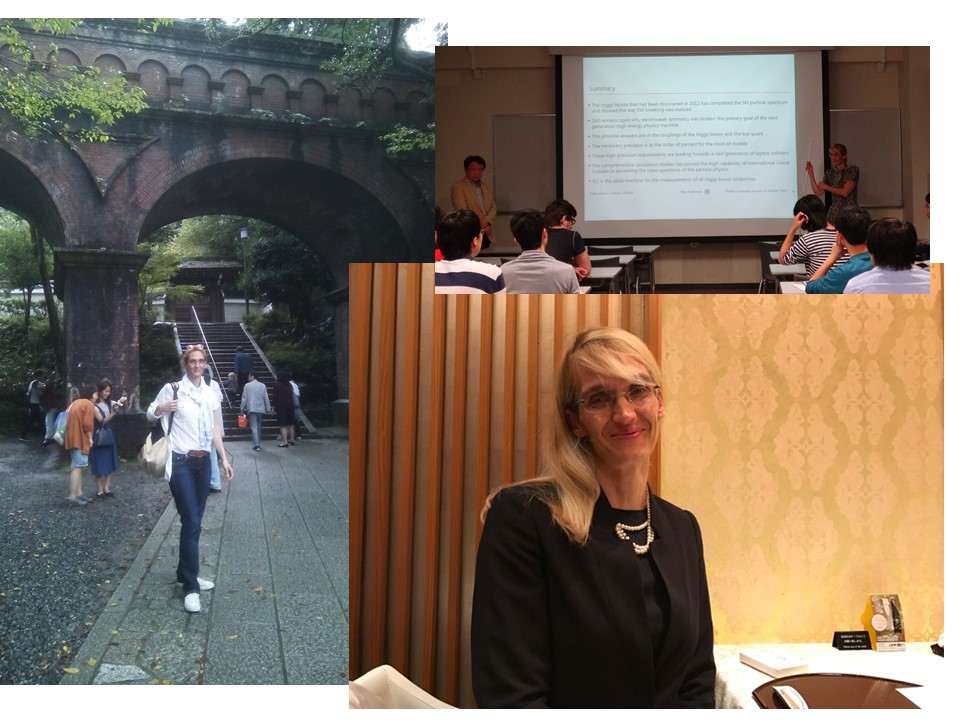
I am associate professor of Vinča Institute of Nuclear Sciences, University of Belgrade, Serbia, working on the Higgs physics at lepton colliders. Even though I am working at the International linear collider ILC project for quite a long time, and have many dear friends, Japan was one of the destinations that did not go into my travel equation. But the finale of the ILC optimization phase, that has been undergoing in the last period with the “shinkasen” speed , where we all hope that decision about the new major project in high energy physics is going to be confirmed in the following period, brought me to Japan. This came rather suddenly in the framework of e-Jade project which connects many institutions from over the world including my home institute and Tohoku University. The opportunity to work in persons with colleagues from Tohoku University ILC group was an interesting and empowering experience. I was finalizing the study of the subleading Higgs decay process and supervising the student on the BSM aspect of the Higgs physics involving non Standard model Higgs bosons.
Besides work, I had a chance to start exploring culture and see everyday life of Japan. My host city, Sendai, which was my first target, exhibits sensations of a modern worldly city, mostly of contemporary architecture, sprinkled with older cultural heritage. It possesses the fresh atmosphere of continental cities. Besides, I have visited Kyoto and Nara. That was quite different time travel, aesthetics and experience.
Even though I am in love with my home country, Serbia, in this month that I have spent in Japan I grew to love Japan and enjoy our differences reflecting in everyday life, food and people.

Jo JAMIN (M2, Graduate School of Physics, Korea University)
15-23 May 2017, Research Center for Electron Photon Science (ELPH), Tohoku University
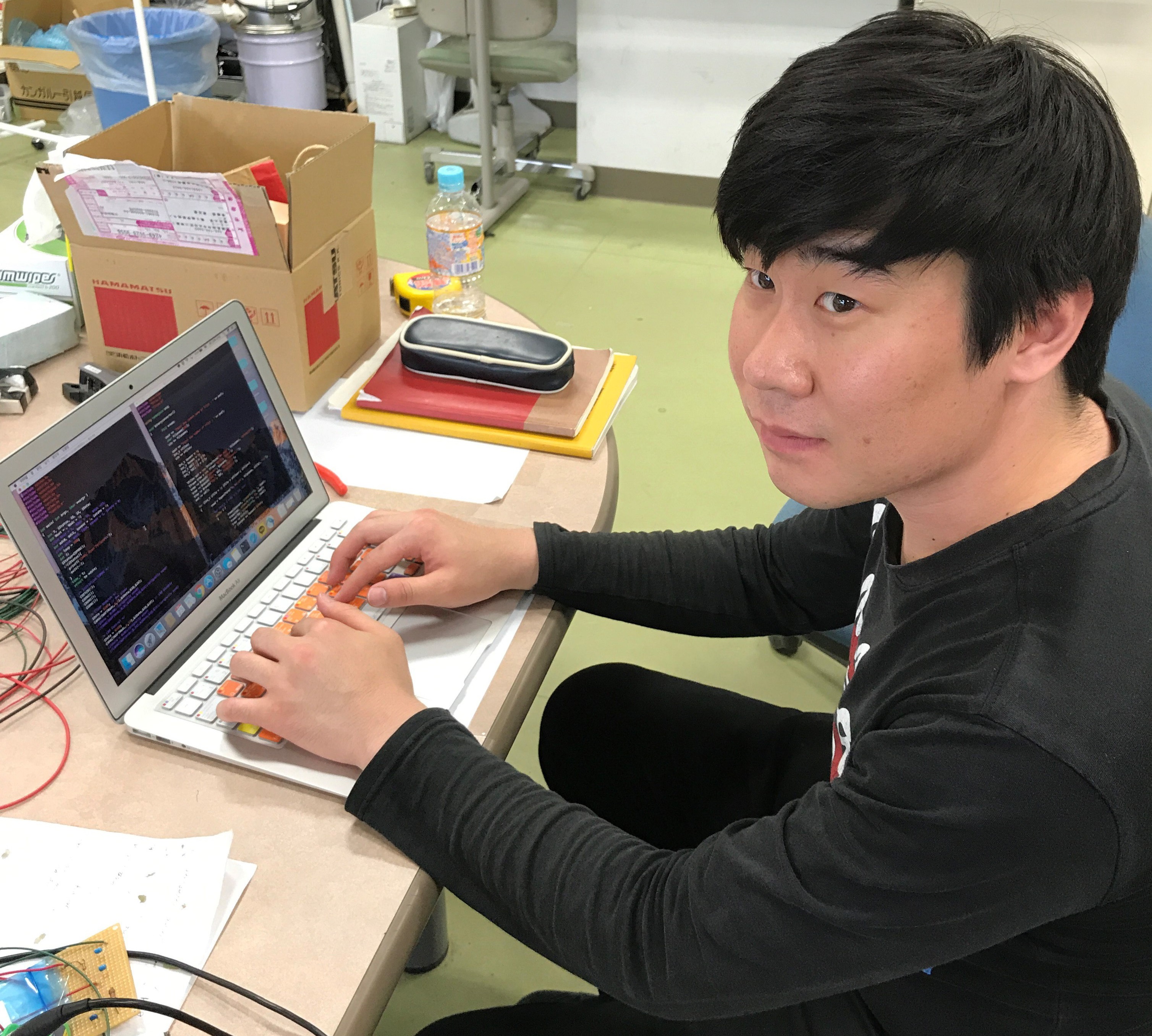
I am Jo Jamin, a second year student
at the Graduate School of Physics, Korea University. My major is nuclear physics, and I am especially interested in hardron physics. I went to various accelerator facilities in Korea and Japan and while I was doing
related work, I came to know that I was doing a program called GPPU at Tohoku University.
The University of Tohoku has a great facility called ELPH,
and experimenting with it has been a great motivation to support because it can be of great
help in future research. It is a great opportunity to exchange opinions directly with your professors while you are attending classes you need, and to experiment with experimental facilities belonging to the school. If you are currently
a master student and you are considering a doctoral program, the GPPU program at Tohoku University will definitely be a great opportunity.

GPPU staff members
Yusuke TANIMURA
(Assistant Professor, Department of Physics, Graduate School of Science, Tohoku University)
14-27 September 2018, Institut de Physique Nucléaire Orsay, France
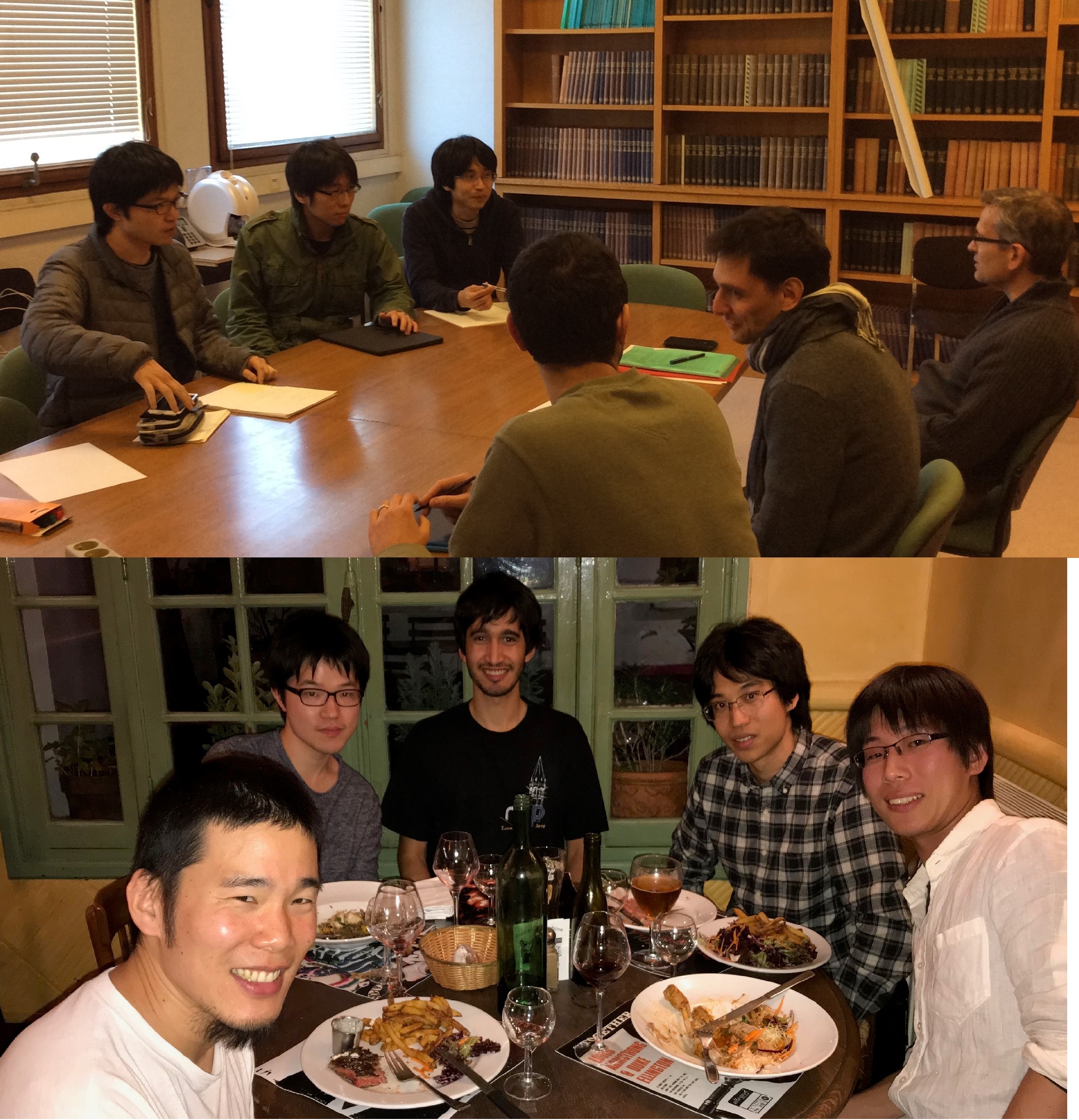
We visited Institut de Physique Nucléaire Orsay (IPNO) in France. The aim of the trip was to have discussions on possible future collaborations between Orsay and Tohoku groups. During our stay for about 10 days, we had fruitful discussions with Dr. Denis Lacroix, Dr. Guillaume Hupin, and Dr. David Regnier on several topics related to theories of nuclear reactions.
Orsay is a small quiet town located at 20 km southwest to Paris, connected directly by a railway line to Paris city and Charles de Gaulle airport. The climate is moderate as compared to Sendai. The weather was nice, fortunately, during our visit. We had dinners at nice crêperies, French restaurants and pizzerias etc. around Orsay.
Personally, the trip was very enjoyable since I had been at IPNO for two years from 2014 as postdoc with Denis. I was happy to meet my colleagues, to walk around the town where I used to live, and to visit touristic places in Paris.
フランスのオルセー原子核物理研究所 (Institut de Physique Nucléaire Orsay, IPNO) を訪問し、オルセーと東北大の理論グループ間での共同研究の可能性について議論しました。 約10日間の短い滞在ではありましたが、Denis Lacroix氏、Guillaume Hupin氏、David Regnier氏と、 核反応に対する新しい理論的なアプローチについて有意義な議論を交わすことができました。
オルセーは、パリの南西約20kmに位置する閑静な町です。 交通の便はよく、パリ市内やシャルルドゴール空港に直通する鉄道があります。 気候は仙台に比べると穏やかで、幸いにも、我々の滞在中には好天に恵まれました。 宿泊先がオルセーの近くだったので、夕食は主にオルセーにあるクレープ屋等でおいしい料理を楽しみました。
IPNOには学位取得後の2014年から2016年にかけてポスドク研究員として滞在していたので、今回オルセーを訪問できたのは非常に喜ばしいことでした。 当時の同僚と再会したり、住んでいた町を散歩したり、パリの観光地を訪れたりと、滞在中のすべての出来事が私にとっては心地よく懐かしいものでした。

Dr. Toshiyuki GOGAMI
(Assistant Professor, Department of Physics, Graduate School of Science, Tohoku University)
21 - 29 October, 2017, ECT*, Trento, Italy
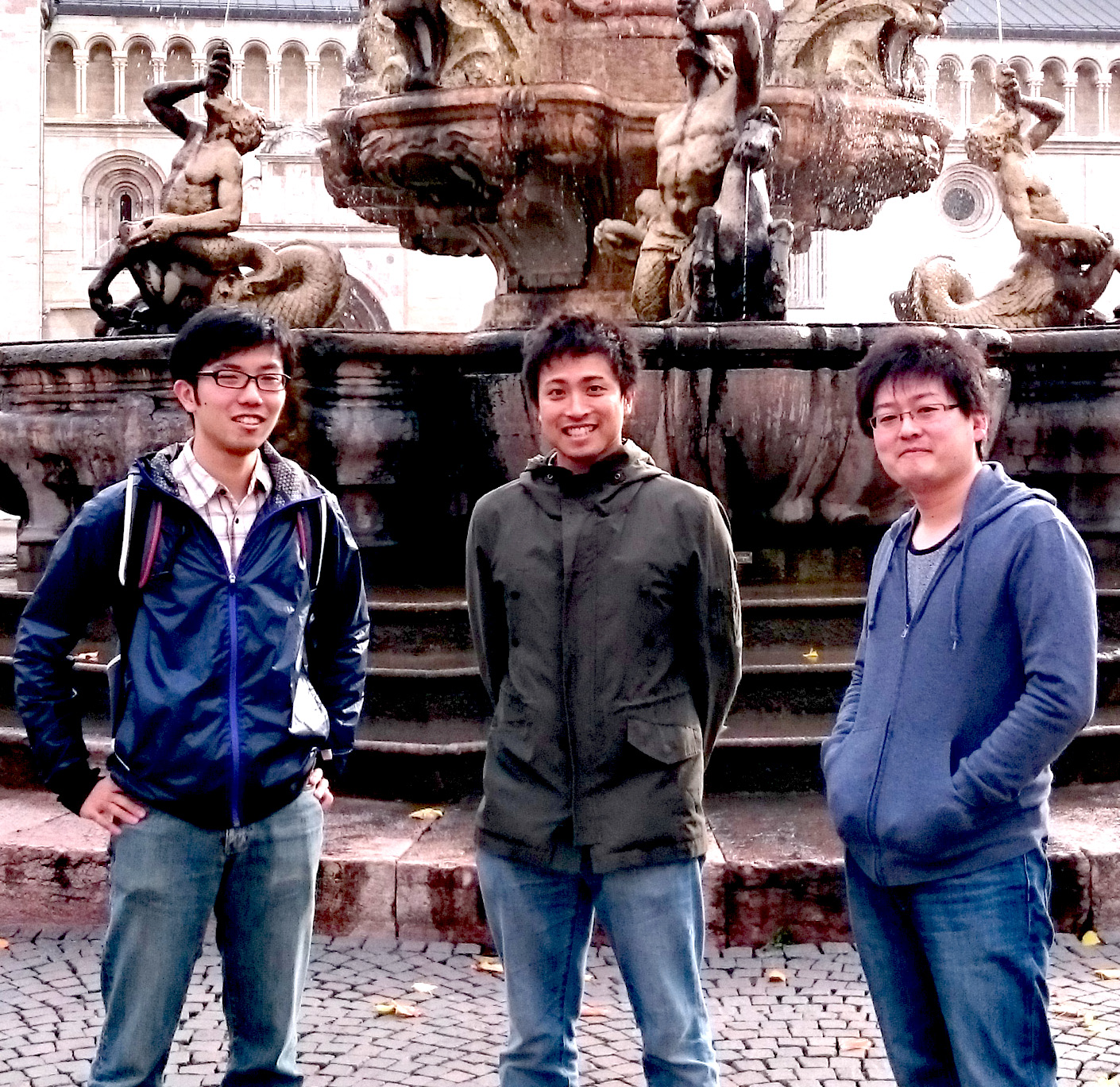
I participated a workshop, ASTRA: Advances and open problems in low-energy nuclear and hadronic STRAngeness physics, which was held in ECT*, Trento, Italy. I presented about Λ hypernuclear spectroscopy at Jefferson Lab using electron beam. Trento is one of the wealthiest cities in Italy, and is in a valley surrounded by 2000-m class rock-mountains. I enjoyed food, drinks, and natures as well as discussions about strangeness nuclear physics with researchers.
私はイタリア・トレントにあるECT*において開催された研究会・ASTRA に参加しました。そこでは、自身の Λ ハイパー核分光研究について発表すると共に、世界で展開されるストレンジネス核物理に関する実験的・理論的な先端研究について学びました。イタリアの中で最も裕福な町の一つであるトレントは 2000 m 級の山々に囲まれた谷に位置し、壮大な自然の景観が印象的な場所です。アルプス山脈から流れるアディジェ川を見下ろす会場において、現地の食べ物や飲み物を楽しみつつ、普段会う事の難しい研究者との議論を深める事が出来ました。

Dr. Toshiyuki GOGAMI
(Assistant Professor, Department of Physics, Graduate School of Science, Tohoku University)
June 21 - July 16, 2017, Thomas Jefferson National Accellerator Facility (JLab), Newport News, VA, US
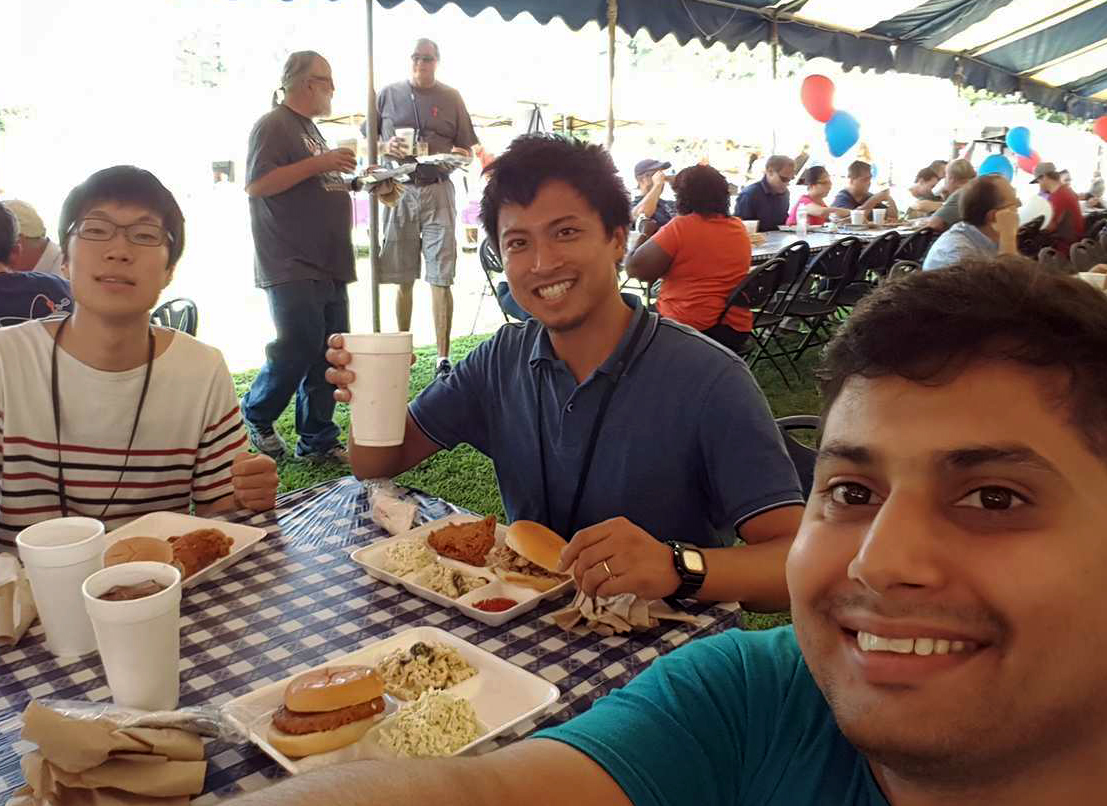
What I am investigating is one of the fundamental forces,
the strong interaction, by means of spectroscopy of Lambda (Λ)
hypernuclei at the Thomas Jefferson National
Accelerator Facility (JLab),
Newport News, VA, US. The strong interaction
in a framework of nucleons which consist of u and d quarks
are well studied.
On the other hand, our understanding of the strong interaction with
other quarks is not enough, and thus it is important to investigate
the interaction between nucleon and Λ particle which includes s
quark.
This time, I visited to JLab in order to discuss
with collaborating researchers, engineers,
and designers about the next generation experiments
of which goal is to extract more precise
Λ-nucleon interaction through high-precision
measurements of various Λ hypernuclei.
In addition, I tested and checked functions of some particle detectors
that will be used for the experiments, supervising foreign students
as well as Tohoku students.
Software environment such as a Monte Carlo simulation,
magnetic field calculation, and real data analysis
were also established.
私たち東北大学が率いる国際研究グループ (JLab Hypernuclear Collaboration) は、基本的な力の一つである「強い力」の研究を米国・ジェファーソン研究所 (JLab) におけるラムダ(Λ)ハイパー原子核の精密分光を通して行っています。私たちは高運動量分解能磁気分光系と高精度解析手法を開発・確立してきました。これにより、世界最高レベルの精度でΛハイパー核分光を行い、Λ-核子相互作用の新たな知見を導いてきました。現在、この実験技術を拡張した次世代実験の詳細設計と準備を行っています。
今回の滞在で私は現地の研究者、エンジニア、デザイナーと新実験の設計について議論し、今後の方針や計画を明確にしました。また、現地の学生や一緒に滞在していた東北大の学生の研究指導をしながら、実験で使用する粒子検出器の動作確認とシミュレータを含んだデータ解析環境の整備が出来ました。今後も、数年後に施行予定の実験を成功に導くための準備を進めていきます。

